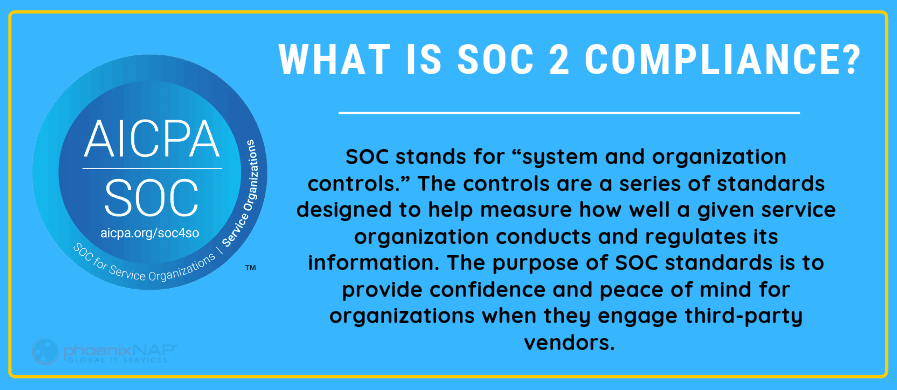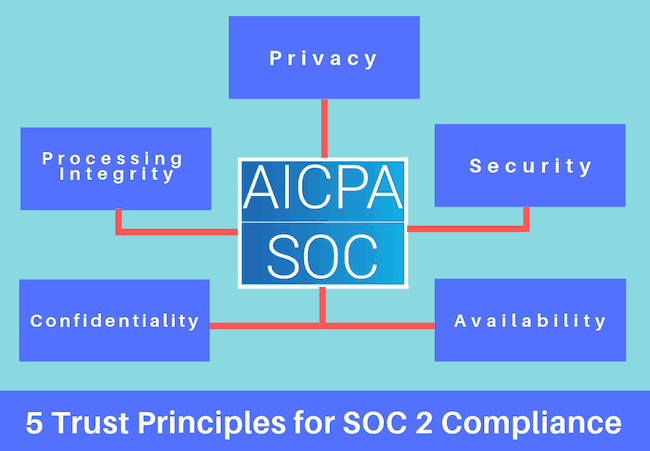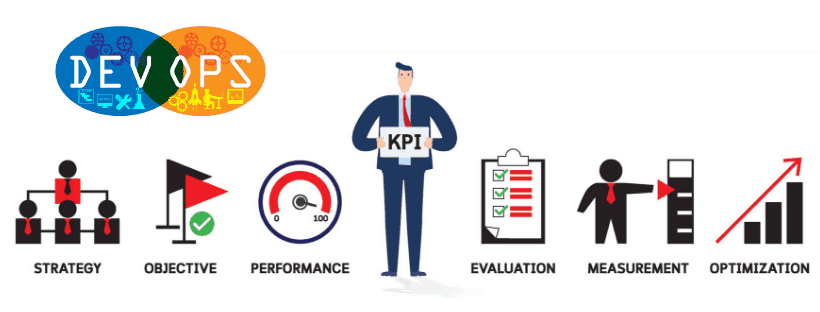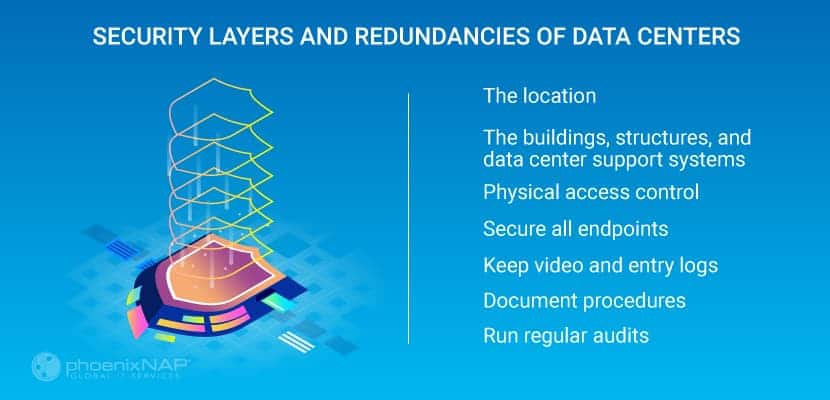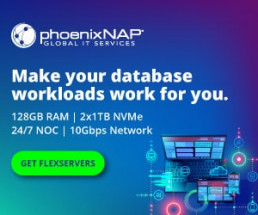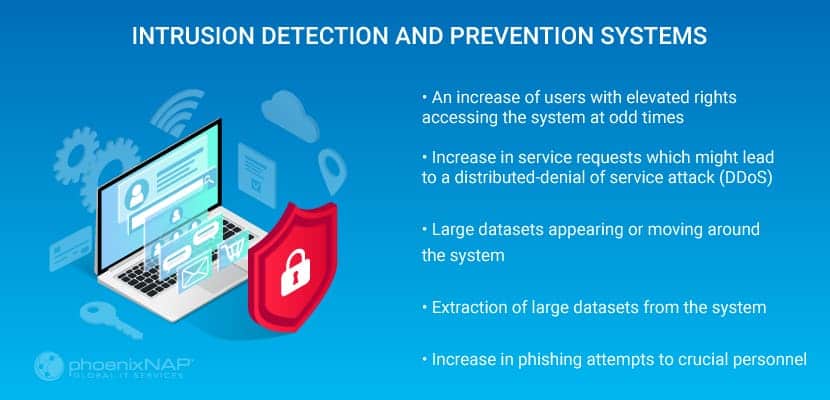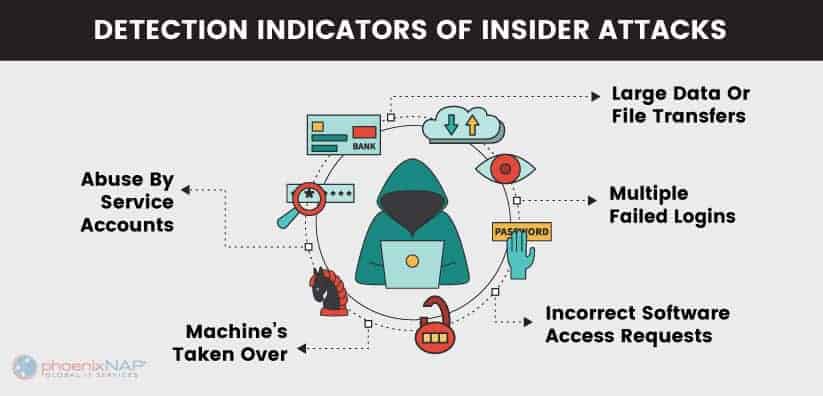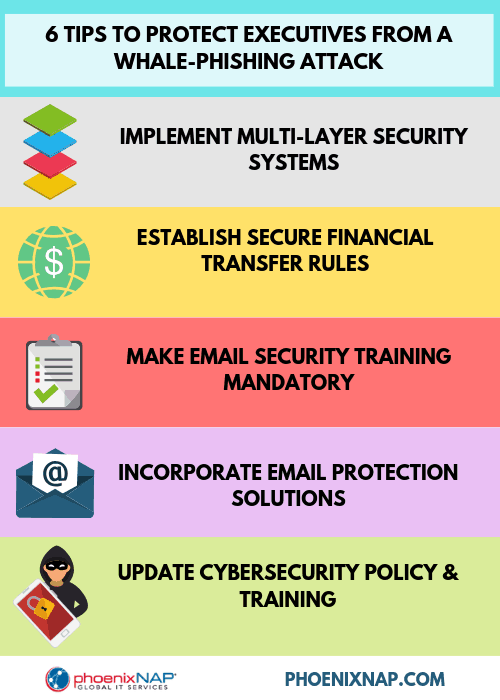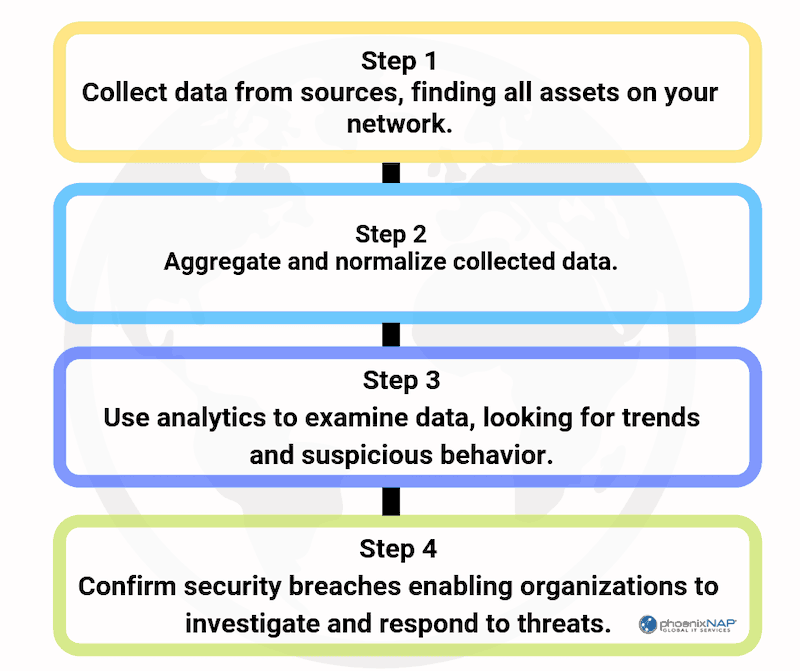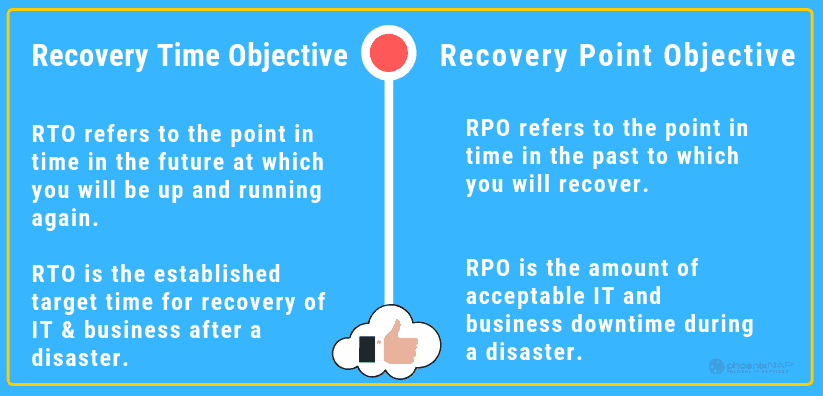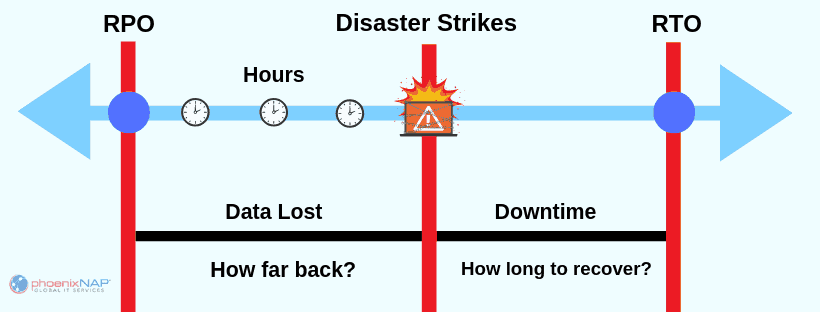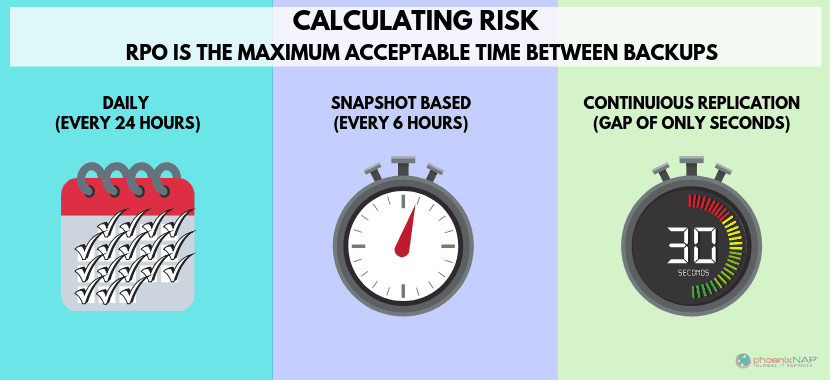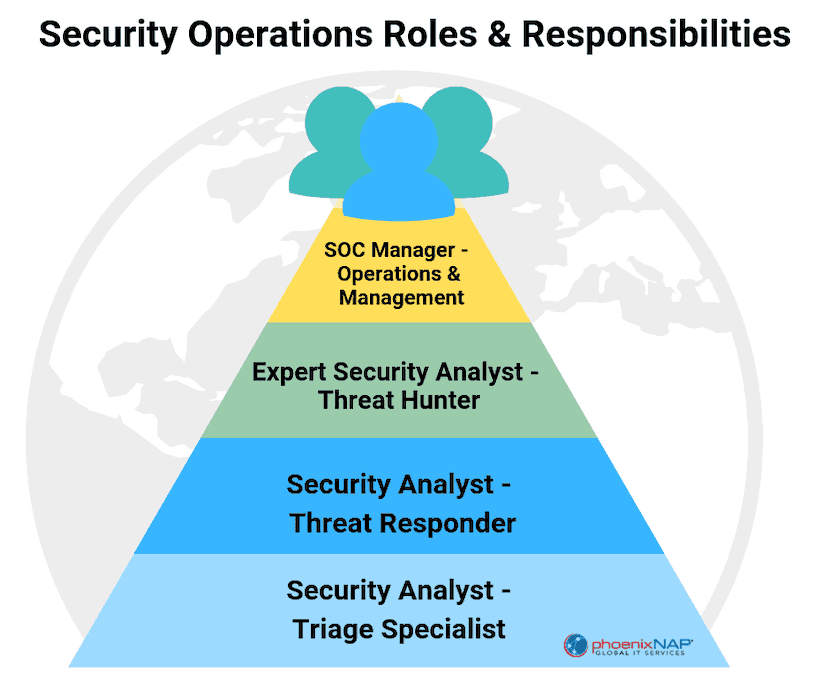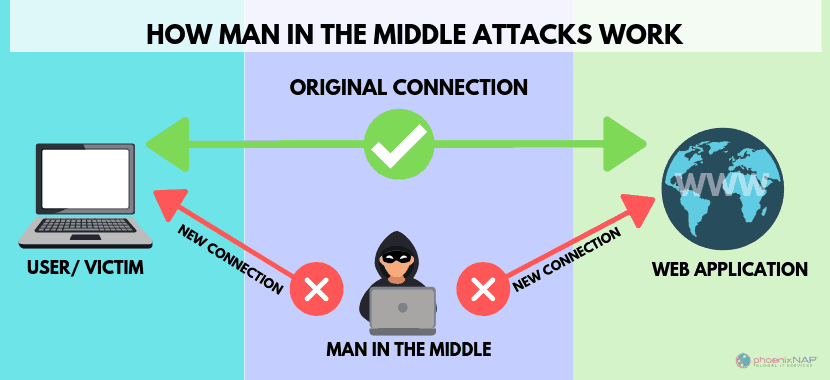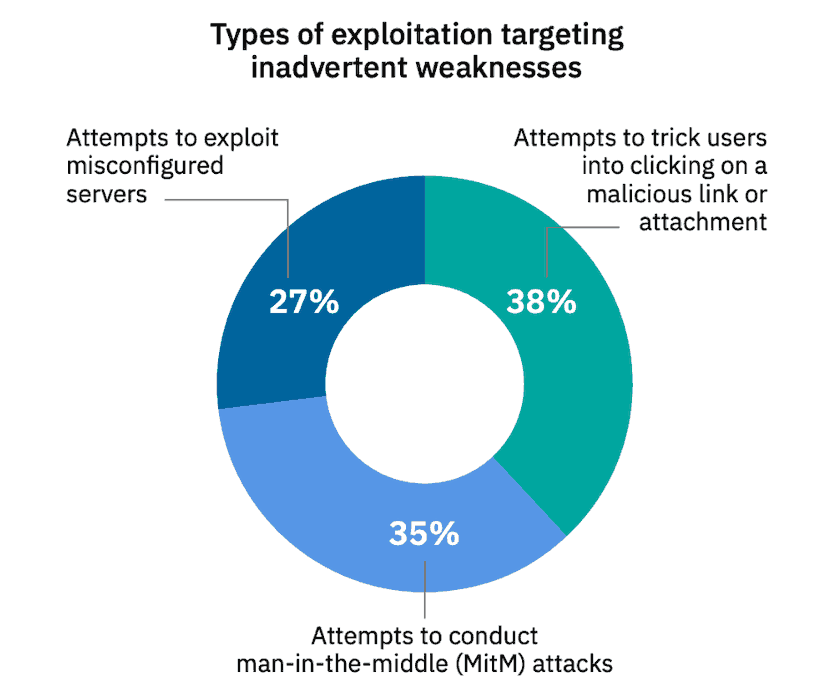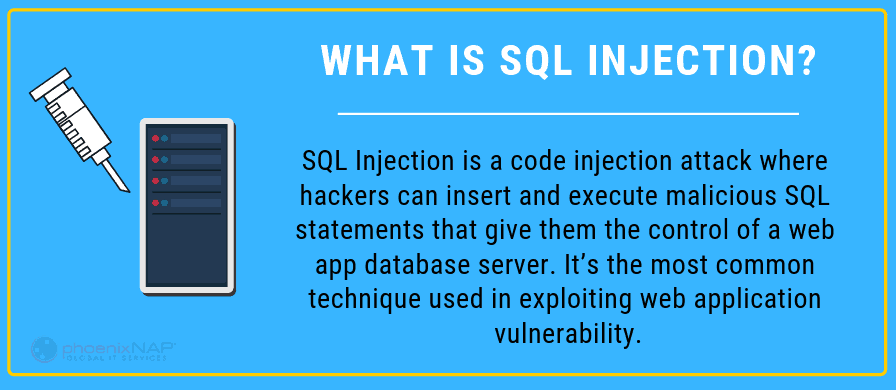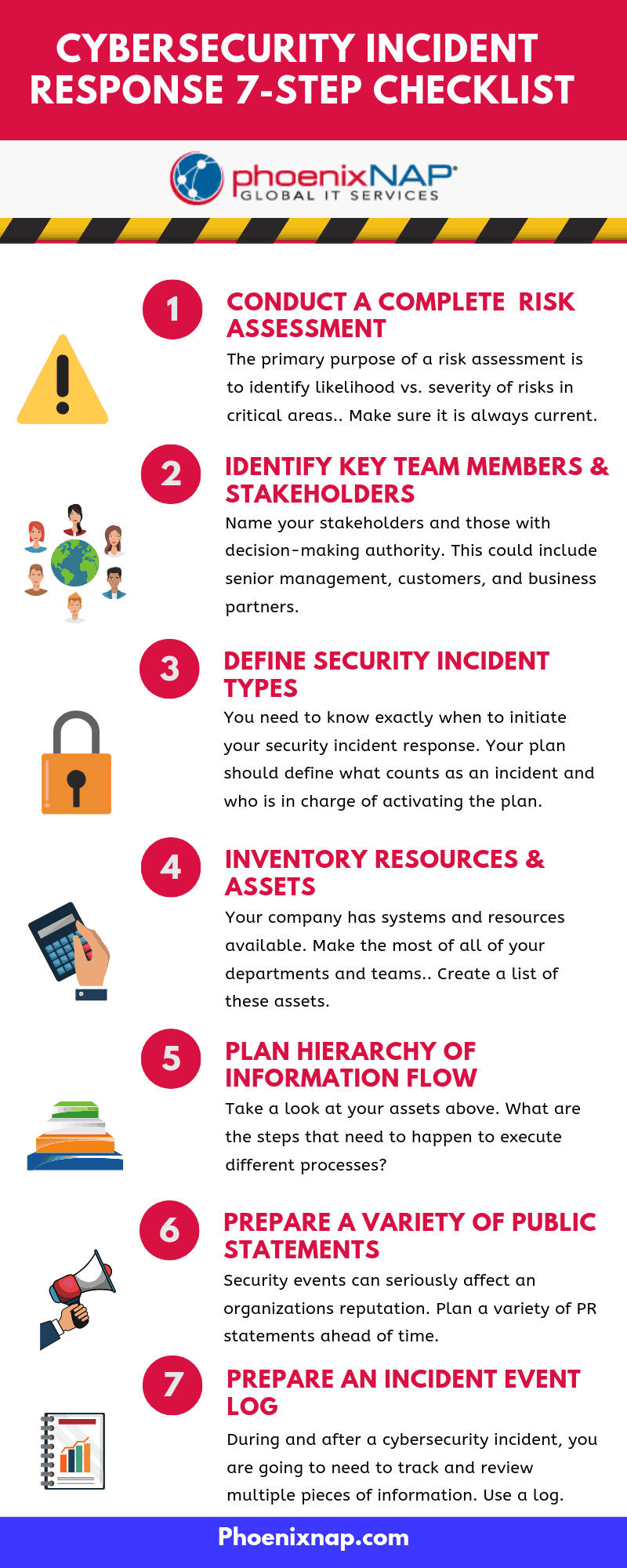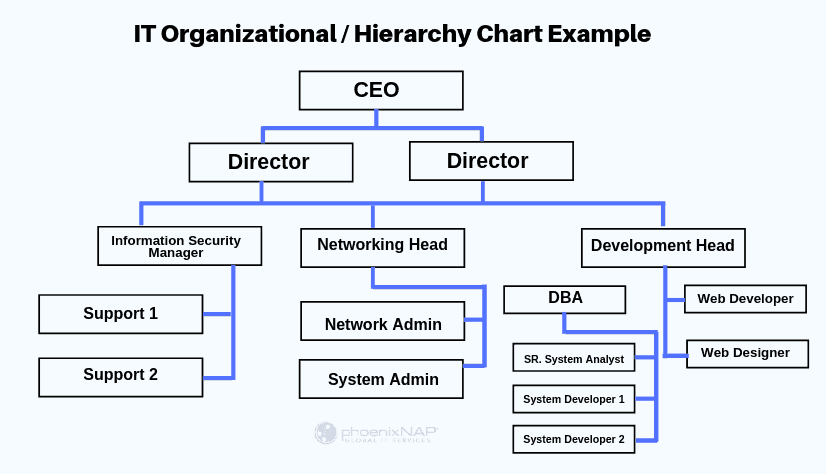Data Loss Prevention Best Practices: CISO's Ultimate Guide to DLP
Data Loss Prevention is critical for any business that captures or stores data. With more and more sensitive data being collected, the consequences of a breach are increasing.
In this article learn, what data loss prevention is, best practices, and how to get started creating a DLP policy.
What is Data Loss Prevention (DLP)?
Data loss prevention (DLP) is an approach to protect sensitive business data and information from data breaches or unwanted compromise of sensitive data. DLP identifies, classifies, and tracks confidential data throughout the enterprise preventing unauthorized disclosure of data with disclosure policies.
Data loss happens when a user gets unauthorized access to sensitive information. Data Loss Prevention is a suite of tools and procedures to prevent data loss.
There are three main components to DLP:
- Identify and categorize sensitive data
- Trace the route of data transmission
- Prevent unauthorized access to data
Data Loss Prevention Planning Best Practices
Define an Objective
The objective is the engine that drives the project. You should decide what’s most important. Areas to consider include:
- Protect customer data
- Stay compliant with regulations
- Keep Intellectual Property safe
- Avoid lawsuits and fines over a data breach
Get All Departments On-Board
Some companies have strict, limited budgets. Others might have reluctant leaders who don’t see the value in DLP. If you’re having trouble pitching the importance of a DLP plan, consider these selling points:
- Show how DLP reduces risk
- Show how DLP plans can include policies and technology that improve business processes
- Show how DLP can automate some tasks and reduce expenses
Get to Know Your Vendors
Ask relevant security questions of your vendors. You’ll want to know if software applications are compatible with your business environment. Find out the costs and features for each vendor, and make sure they’re a good fit. Vendors should be able to speak to compliance, partners, and technologies that they use. They should also be able to tell you who controls the DLP program, whether it’s in-house or vendor-managed. Find out staffing requirements and how those will be affected.
Establish Targets
Define an easy-to-achieve target, then roll out the plan to solve it. Success breeds success. A Data Loss Prevention program can be complex and frustrating to staff. Early wins help boost morale, plus helps sell the continuity of the project to decision-makers.
Causes of Data Loss
Data loss and leakage can be broken down into three main categories. These categories help you develop tools and procedures to protect data.
Negligence
Many data breaches occur because a critical asset wasn’t protected. In many cases, this is simply an error, like a misconfigured firewall, or a MySQL database using the default configuration.
Other times, breaches are related to the budget. Without enough dollars in IT security, professionals may lack the resources to protect data effectively.
A popular attitude among hacker is that “If it’s not locked down, it’s fair game.” It’s a good idea to remember this when evaluating a data protection plan. Anything you ignore or overlook could be used against you.
Infiltration
This is the most common conception of a breach. A criminal attacks your network and gains access. Techniques used to hack into systems include:
- Phishing – In this kind of attack, an email tries to solicit sensitive information or login credentials. Spear-phishing is one type of phishing, in which a specific person is identified and attacked.
- Malware – Attackers try to load malware into the corporate network. Malware could include a computer virus, Trojan horse, rootkits, keyloggers, and other malicious software. Malware can hide in a network, recording data and broadcasting back to its owner.
- Social engineering – An attacker manipulates an employee into granting them access. This could be used in combination with malware. Or, it could merely be an attacker wearing a disguise and asking an employee to open the door.
Insider threats
This is the gut-punch of data breaches. An insider threat or attack is when someone inside a company steals data.
How to Build a Data Loss Prevention Policy
Evaluate current data use
Before enacting sweeping changes, evaluate the ecosystem of your data environment. It’s essential to find out what data is being used, and who’s using it. For example, securing payment card data might sound like a great idea, until sales reps can’t process payments.
Categorize Data Types
A custom solution may be required. Consider using “Employee information,” “Intellectual property,” “Financial information,” and “Customer data” as a starting point. These categories allow you to create different rules to handle different kinds of data.
Monitor Data usage and Transmission
Once categories are established, examine how the data used. Identify storage locations and transmission channels to provide context for data protection strategies.
Start gently
It can be tempting to implement a DLP system right away. The reality is that business data systems can be too complicated for a single sweeping change. A better policy is to tackle easier, obvious targets first to manage the most significant risks while building a culture of data protection.
What Type of Data Loss Prevention is Right for Your Organization?
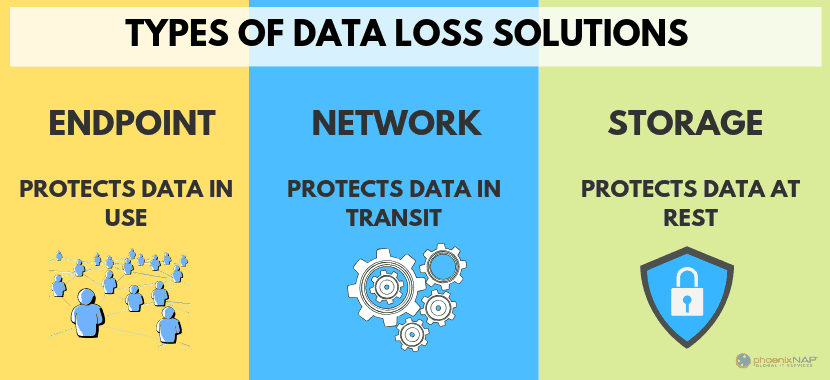
- Endpoint – This protects data in use, and devices used to access data. It could be as simple as a terminal or as complex as shadow IT of smartphones and tablets.
- Network –This protects the data during transit. Behavior analysis and traffic monitoring are common tools.
- Storage – This protects data at rest. This governs access to data in storage, whether on NAS drives or the cloud.
Steps to PreventData Loss
Compliance
If your business is regulated, compliance is a critical piece of a DLP plan. Starting at mandatory regulation helps to ensure custom data policies don’t contradict compliance. For example, Healthcare companies must comply with HIPAA compliance. To process credit cards, you need a PCI-DSS compliance plan.
Organize Data by Risk and Vulnerability
To start, identify, and organize data by type. The next step is to analyze each data type. Look at the level of risk each category presents, then their vulnerability to establish a list of targets. Start with the riskiest and most vulnerable data types. Then, implement a set of policies and technology to protect them.
Define User Roles
Users should have clearly-defined roles to make sure that users can only access data that’s necessary for their job. Examples might include a “Sales Agent” job that allows access to payment card data. Another example might be “Senior Technical Support,” which has access to bug reports and engineering fixes. Data can be restricted from specific user roles as well. A Senior Technical Support agent doesn’t usually need access to payment card data.
Involve Key Stakeholders
No one knows the business like the people doing the work. Take time to involve leaders from different parts of the company. They often see vulnerabilities that upper management can overlook and also anticipate problems or conflicts with new policies. Employees are more likely to buy into a new plan if they are involved in developing it.
Create policies, implement technology
It should go without saying that DLP plans should be enacted. If the DLP plan requires a review of all firewall settings, make sure employees are tasked with that job. Create a timeline for buying, testing, and installing new DLP software.
Automate
Humans make mistakes, and our ability to see problems can be limited.
Automating data loss tools and policies helps reduce the risk of human error. Some tasks cannot be automated. Wherever possible, try to create systems that protect data automatically. For example, spam-filtering software can prevent phishing attacks. Users are protected because they never have a chance to see (or be manipulated by) a phishing email.
Educate
Education takes leader involvement to the next step. Leaders who help develop DLP plans already understand the policy. The next step is to train individual team members. A good data loss prevention strategy is to teach what, then why. Explain the new systems and software and how to use it. Then have a conversation about why this change is essential. Help them understand how protecting data is a win for the company and its customers.
Document
Write down a master plan of the DLP solution. Proper documentation is essential for a couple of reasons. First, it helps keep the project on task. Everyone can refer back to the agreements and plan that was made. Second, it helps keep a record of what’s been implemented. The documentation is especially helpful if there are instructions. At a minimum, leave a brief note with the “how” and “why” for each part of the DLP plan.
Measure
Once the DLP plan is in place, check back regularly, and review the progress. Most data loss prevention tools have reporting metrics. Check to see how many intrusion attempts have been blocked. Review server logs to verify that data is being used appropriately.
Delete Unnecessary Data
It can be tempting to hold on to data forever. We never know when we might need it! Old, unused data can be a liability. If server logs are no longer required after seven years, delete them. If you can’t bear to delete them, archive them in long-term, secure storage. That data might seem valuable. But the value can easily be outstripped by its vulnerability. When weighed against the cost of a data breach, old data might not seem quite so important.
DLP Statistics
Cybercrime is big business. Here are a few sobering facts about Data Loss and the consequences.:
Data loss is estimated to have generated over a half billion dollars profit for cybercriminals in 2018.
Security breaches increased by 11% in 2018.
43% of cyber attacks target small businesses.
Ransomware statistics show that is costs businesses more than $75 billion per year.
83% of IT security professionals have experienced phishing attacks. Source: (Wombat Security)
It takes an average of 50 days between discovery and reporting of a breach.
DLP is a culture, not a silver bullet
Building a data loss prevention strategy is a critical component for today’s digital businesses.
The landscape of digital crime is continually evolving. A quick, one-and-done solution may be effective today, but obsolete tomorrow. Instead, develop policies as living documents. If a vulnerability is discovered, a flexible and growth-oriented security policy can better adapt to new threats. Eventually, data protection will grow to become a core feature of company culture.
Recent Posts
The Ultimate Guide to Zero-Day Exploit Attacks: Defined, Explained
In today’s digital marketplace, there is hardly an organization that does not depend on software or “the internet”. This dependence brings with it a degree of vulnerability. Businesses today are far more likely to have their operations interrupted by cybercriminals than malicious actors in the real world.
Zero-day attacks are especially feared because they give hackers a unique opportunity to bypass typical cybersecurity defenses. In this article, learn what a zero-day vulnerability is and how you can protect against an attack.
What Is a Zero-Day Vulnerability?
A zero-day attack is when hackers release malware before developers have an opportunity to release a fix for the vulnerability—hence zero-day.
Zero-day refers to a newly discovered vulnerability in the software. As developers are just finding out about the flaw, patches or security update to resolve the issue, have not been released. In zero-day attacks, software vendors are reactive, not proactive. They can only respond when problems emerge.
A zero-day attack happens when hackers exploit a window of vulnerability and then launch a direct attack using that vulnerability.
What makes zero-day exploits so dangerous is that the only people who know about them are the attackers themselves. Hackers can either attack immediatly or sit on their knowledge of weakness, waiting for the opportune moment to strike.
How Does A Zero-Day Attack Work?
Zero-day exploits work by many mechanisms. Typically, they involve targeting a software system with malware. Malware integrates into an existing layer of software and prevents it from performing its normal function.
Infiltration with malware is surprisingly easy. Often hackers will disguise malware in the form of website links. All a user has to do is click a website link, and they will automatically begin downloading the problem software. Downloads like these often occur when a hacker has found a way to exploit unpatched vulnerabilities in a web browser.
For example, suppose that your browser has just updated its software to add more features. You log into a website that you trust on your browser and then click what you believe to be a valid link. The link, however, contains malicious code.
Before the patch, your browser would have prevented the link from automatically downloading software onto your computer. However, thanks to changes in the browser code after patching, the download begins. Your computer then becomes infected.
Hours later, the browser company releases a new patch to prevent other people from getting infected. However, for you, it’s already too late.
Who are the targets?
Zero-day exploits target high-profile businesses and governments, but they can attack anyone. The zero-day exploit, Stuxnet, for instance, attempted to sabotage the Iranian Nuclear program in 2010. Many people believe that Israel and the United States were behind the attack. Stuxnet contained new forms of exploit that many people had not seen before.
New email software, for instance, may not be able to filter out fake addresses. This might expose people to various types of phishing attacks. Hackers may try to steal valuable information, like bank card details or passwords.
How Can Zero-Day Exploits be Prevented?
Many organizations and individuals believe that there’s not much that can be done to stop a zero-day attack. This is not entirely true. Take a look at these tips and learn prevention strategies.
Use Up-To-Date Advanced Security Software
The problem with many basic anti-virus software solutions is that they are only good at defending against known threats. When threats are unknown – as they are in zero-day attacks – then they can fail. Only the most advanced security software in the world can protect against hacking from as-yet-unknown origins. Keeping software up-to-date at all times is essential.
Ensure Security Software is Up-to-Date
Vendors may not always publicly disclose if they have been the victim of a zero-day attack. That’s why it’s essential to install new software updates as soon as they become available. They could protect your organization against threats software vendors have identified.
Teach Safe Online Security Habits
Many zero-day exploits harness human error. Malicious actors, for instance, may target employees with fake emails. These emails may contain documents infected with malware or encourage them to hand over sensitive information. Smart organizations, therefore, rigorously enforce security habits to help employees stay safe online.
Install Proactive Security Defenses
Smart security software can sometimes block as-yet-unknown threats using databases of past breaches. These data can be correlated with present attacks to detect threats. Look for software that can defend against attacks of both known and unknown origin.
Implement Network Access Control
Network access control is a tool that prevents unauthorized machines from accessing an organization’s network.
Use IPsec
IPsec encrypts and authenticates all network traffic. This allows the system to identify and isolate non-network traffic quickly.
Deploy a Web Application Firewall
Web application firewalls are a kind of firewall that helps to protect computers that link to a web server. The purpose of the firewall is to scan incoming packets of data for threats continually. The hope is that by using a web application firewall, companies can react in real-time. With a scanner, firms can immediately suppress suspicious activity on their platforms.
Use Content Threat Removal
Content threat removal is a type of detection technology that assumes all data is threatening. The system works by dismantling all data that comes through the network and discarding anything it thinks is malicious. The idea is to throw out anything potentially unsafe in the original data, based on a database of dangerous objects.
Develop Recovery Strategies
Even employing all of the above, it is unlikely that an organization will be able to eliminate the threat of zero-day exploits. Organizations, therefore, must prepare for the worse so that they can respond.
Having a disaster recovery strategy in place is essential. Disaster recovery strategies can mitigate damage from a breach. Most companies ensure that they have cloud backups for all their data. In the event of a breach, their data is safe, and they can continue with their operations as usual.
Detection of Zero Day Exploits
Organizations need to be able to detect attacks quick. Security professionals have four ways of identifying a zero-day attack.
- Statistical analysis can be deployed to analyze the likelihood and probable source of an attack.
- Signature-based. Previous data from past attacks can be examined and determine whether current data patterns signal a threat. If they do, then an attack may be underway.
- Behavioral analysis. By studying the behavior of malicious actors and see if it has changed. If the patterns from a suspected hacking entity differ from usual, then it could be a sign of an attack.
- Combination scoring system. By combining all methods into a single scoring system, the score determines the likelihood of a breach.
Recent Zero Day Attacks
Zero-day attacks are a common occurrence throughout recent history. Take a look at the following cases:
- Adobe Flash Player, 2016. In 2016, there was a zero-day attack on Adobe Flash. Hackers gained the ability to control read and write memory.
- Microsoft Office, 2017. In 2017, hackers discovered that documents in rich text format could open a visual basic script. The script could then be used to open PowerShell commands.
- Windows. A Google employee identified Windows as having zero-day vulnerabilities. The employee then went on the record to state the Microsoft’s flagship product had had flawed code for more than 20 years.
- Java. Java is a platform used by both Microsoft and Apple to create their products. Java recently released a fix designed to overcome some of the platform’s serious zero-day security vulnerabilities.
Recent Posts
17 Best Security Penetration Testing Tools The Pros Use
Are you seeking the best penetration testing tool for your needs? We have you covered.
Penetration testing tools are software applications used to check for network security threats.
Each application on this list provides unique benefits. Easy comparison helps you determine whether the software is the right choice for your business. Let’s dive in and discover the latest security software options on the market.
What Is Penetration Testing?
Penetration testing, also known as pen testing, means computer securities experts use to detect and take advantage of security vulnerabilities in a computer application. These experts, who are also known as white-hat hackers or ethical hackers, facilitate this by simulating real-world attacks by criminal hackers known as black-hat hackers.
In effect, conducting penetration testing is similar to hiring security consultants to attempt a security attack of a secure facility to find out how real criminals might do it. The results are used by organizations to make their applications more secure.
How Penetration Tests Work
First, penetration testers must learn about the computer systems they will be attempting to breach. Then, they typically use a set of software tools to find vulnerabilities. Penetration testing may also involve social engineering hacking threats. Testers will try to gain access to a system by tricking a member of an organization into providing access.
Penetration testers provide the results of their tests to the organization, which are then responsible for implementing changes that either resolve or mitigate the vulnerabilities.
 Types of Penetration Tests
Types of Penetration Tests
Penetration testing can consist of one or more of the following types of tests:
White Box Tests
A white box test is one in which organizations provide the penetration testers with a variety of security information relating to their systems, to help them better find vulnerabilities.
Blind Tests
A blind test, known as a black-box test, organizations provide penetration testers with no security information about the system being penetrated. The goal is to expose vulnerabilities that would not be detected otherwise.
Double-Blind Tests
A double-blind test, which is also known as a covert test, is one in which not only do organizations not provide penetration testers with security information. They also do not inform their own computer security teams of the tests. Such tests are typically highly controlled by those managing them.
External Tests
An external test is one in which penetration testers attempt to find vulnerabilities remotely. Because of the nature of these types of tests, they are performed on external-facing applications such as websites.
Internal Tests
An internal test is one in which the penetration testing takes place within an organization’s premises. These tests typically focus on security vulnerabilities that someone working from within an organization could take advantage of.
Top Penetration Testing Software & Tools
1. Netsparker
Netsparker Security Scanner is a popular automatic web application for penetration testing. The software can identify everything from cross-site scripting to SQL injection. Developers can use this tool on websites, web services, and web applications.
The system is powerful enough to scan anything between 500 and 1000 web applications at the same time. You will be able to customize your security scan with attack options, authentication, and URL rewrite rules. Netsparker automatically takes advantage of weak spots in a read-only way. Proof of exploitation is produced. The impact of vulnerabilities is instantly viewable.
Benefits:
- Scan 1000+ web applications in less than a day!
- Add multiple team members for collaboration and easy shareability of findings.
- Automatic scanning ensures a limited set up is necessary.
- Searches for exploitable SQL and XSS vulnerabilities in web applications.
- Legal web application and regulatory compliance reports.
- Proof-based scanning Technology guarantees accurate detection.
2. Wireshark
Once known as Ethereal 0.2.0, Wireshark is an award-winning network analyzer with 600 authors. With this software, you can quickly capture and interpret network packets. The tool is open-source and available for various systems, including Windows, Solaris, FreeBSD, and Linux.
Benefits:
- Provides both offline analysis and live-capture options.
- Capturing data packets allows you to explore various traits, including source and destination protocol.
- It offers the ability to investigate the smallest details for activities throughout a network.
- Optional adding of coloring rules to the pack for rapid, intuitive analysis.
3. Metasploit
Metasploit is the most used penetration testing automation framework in the world. Metasploit helps professional teams verify and manage security assessments, improves awareness, and arms and empowers defenders to stay a step ahead in the game.
It is useful for checking security and pinpointing flaws, setting up a defense. An Open source software, this tool will allow a network administrator to break in and identify fatal weak points. Beginner hackers use this tool to build their skills. The tool provides a way to replicates websites for social engineers.
Benefits:
- Easy to use with GUI clickable interface and command line.
- Manual brute-forcing, payloads to evade leading solutions, spear phishing, and awareness, an app for testing OWASP vulnerabilities.
- Collects testing data for over 1,500 exploits.
- MetaModules for network segmentation tests.
- You can use this to explore older vulnerabilities within your infrastructure.
- Available on Mac Os X, Windows and Linux.
- Can be used on servers, networks, and applications.
4. BeEF
This is a pen testing tool and is best suited for checking a web browser. Adapted for combating web-borne attacks and could benefit mobile clients. BeEF stands for Browser Exploitation Framework and uses GitHub to locate issues. BeEF is designed to explore weaknesses beyond the client system and network perimeter. Instead, the framework will look at exploitability within the context of just one source, the web browser.
Benefits:
- You can use client-side attack vectors to check security posture.
- Connects with more than one web browser and then launch directed command modules.
5. John The Ripper Password Cracker
Passwords are one of the most prominent vulnerabilities. Attackers may use passwords to steal credentials and enter sensitive systems. John the Ripper is the essential tool for password cracking and provides a range of systems for this purpose. The pen testing tool is a free open source software.
Benefits:
- Automatically identifies different password hashes.
- Discovers password weaknesses within databases.
- Pro version is available for Linux, Mac OS X, Hash Suite, Hash Suite Droid.
- Includes a customizable cracker.
- Allows users to explore documentation online. This includes a summary of changes between separate versions.
6. Aircrack
Aircrack NG is designed for cracking flaws within wireless connections by capturing data packets for an effective protocol in exporting through text files for analysis. While the software seemed abandoned in 2010, Aircrack was updated again in 2019.
This tool is supported on various OS and platforms with support for WEP dictionary attacks. It offers an improved tracking speed compared to most other penetration tools and supports multiple cards and drivers. After capturing the WPA handshake, the suite is capable of using a password dictionary and statistical techniques to break into WEP.
Benefits:
- Works with Linux, Windows, OS X, FreeBSD, NetBSD, OpenBSD, and Solaris.
- You can use this tool to capture packets and export data.
- It is designed for testing wifi devices as well as driver capabilities.
- Focuses on different areas of security, such as attacking, monitoring, testing, and cracking.
- In terms of attacking, you can perform de-authentication, establish fake access points, and perform replay attacks.
7. Acunetix Scanner
Acutenix is an automated testing tool you can use to complete a penetration test. The tool is capable of auditing complicated management reports and issues with compliance. The software can handle a range of network vulnerabilities. Acunetix is even capable of including out-of-band vulnerabilities.
The advanced tool integrates with the highly enjoyed Issue Trackers and WAFs. With a high-detection rate, Acunetix is one of the industry’s advanced Cross-site scripting and SQLi testing, which includes sophisticated advanced detection of XSS.
Benefits:
- The tool covers over 4500 weaknesses, including SQL injection as well as XSS.
- The Login Sequence Recorder is easy-to-implement and scans password-protected areas.
- The AcuSensor Technology, Manual Penetration tools, and Built-in Vulnerability Management streamline black and white box testing to enhance and enable remediation.
- Can crawl hundreds of thousands of web pages without delay.
- Ability to run locally or through a cloud solution.
8. Burp Suite Pen Tester
There are two different versions of the Burp Suite for developers. The free version provides the necessary and essential tools needed for scanning activities. Or, you can opt for the second version if you need advanced penetration testing. This tool is ideal for checking web-based applications. There are tools to map the tack surface and analyze requests between a browser and destination servers. The framework uses Web Penetration Testing on the Java platform and is an industry-standard tool used by the majority of information security professionals.
Benefits:
- Capable of automatically crawling web-based applications.
- Available on Windows, OS X, Linux, and Windows.
9. Ettercap
The Ettercap suite is designed to prevent man in the middle attacks. Using this application, you will be able to build the packets you want and perform specific tasks. The software can send invalid frames and complete techniques which are more difficult through other options.
Benefits:
- This tool is ideal for deep packet sniffing as well as monitoring and testing LAN.
- Ettercap supports active and passive dissection of protections.
- You can complete content filtering on the fly.
- The tool also provides settings for both network and host analysis.
10. W3af
W3af web application attack and audit frameworks are focused on finding and exploiting vulnerabilities in all web applications. Three types of plugins are provided for attack, audit, and discovery. The software then passes these on to the audit tool to check for flaws in the security.
Benefits:
- Easy to use for amateurs and powerful enough for developers.
- It can complete automated HTTP request generation and raw HTTP requests.
- Capability to be configured to run as a MITM proxy.
11. Nessus
Nessus has been used as a security penetration testing tool for twenty years. 27,000 companies utilize the application worldwide. The software is one of the most powerful testing tools on the market with over 45,000 CEs and 100,000 plugins. Ideally suited for scanning IP addresses, websites and completing sensitive data searches. You will be able to use this to locate ‘weak spots’ in your systems.
The tool is straightforward to use and offers accurate scanning and at the click of a button, providing an overview of your network’s vulnerabilities. The pen test application scans for open ports, weak passwords, and misconfiguration errors.
Benefits:
- Ideal for locating and identify missing patches as well as malware.
- The system only has .32 defects per every 1 million scans.
- You can create customized reports, including types of vulnerabilities by plugin or host.
- In addition to web application, mobile scanning, and cloud environment, the tool offers priority remediation.
12. Kali Linux
Kali Linux advanced penetration testing software is a Linux distribution used for penetration testing. Many experts believe this is the best tool for both injecting and password snipping. However, you will need skills in both TCP/IP protocol to gain the most benefit. An open-source project, Kali Linux, provides tool listings, version tracking, and meta-packages.
Benefits:
- With 64 bit support, you can use this tool for brute force password cracking.
- Kali uses a live image loaded into the RAM to test the security skills of ethical hackers.
- Kali has over 600 ethical hacking tools.
- Various security tools for vulnerability analysis, web applications, information gathering, wireless attacks, reverse engineering, password cracking, forensic tools, web applications, spoofing, sniffing, exploitation tools, and hardware hacking are available.
- Easy integration with other penetration testing tools, including Wireshark and Metasploit.
- The BackTrack provides tools for WLAN and LAN vulnerability assessment scanning, digital forensics, and sniffing.
13. SQLmap
SQLmap is an SQL injection takeover tool for databases. Supported database platforms include MySQL, SQLite, Sybase, DB2, Access, MSSQL, PostgreSQL. SQLmap is open-source and automates the process of exploiting database servers and SQL injection vulnerabilities.
Benefits:
- Detects and maps vulnerabilities.
- Provides support for all injection methods: Union, Time, Stack, Error, Boolean.
- Runs software at the command line and can be downloaded for Linux, Mac OS, and Windows systems
14. (SET) Social Engineer Toolkit
Social engineering is the primary focus of the toolkit. Despite the aim and focus, human beings are not the target of the vulnerability scanner.
Benefits:
- It has been featured at top cybersecurity conferences, including ShmooCon, Defcon, DerbyCon and is an industry-standard for penetration tests.
- SET has been downloaded over 2 million times.
- An open-source testing framework designed for social engineering detection.
15. Zed Attack Proxy
OWASP ZAP (Zed Attack Proxy) is part of the free OWASP community. It is ideal for developers and testers that are new to penetration testing. The project started in 2010 and is improved daily. ZAP runs in a cross-platform environment creating a proxy between the client and your website.
Benefits:
- 4 modes available with customizable options.
- To install ZAP, JAVA 8+ is required on your Windows or Linux system.
- The help section is comprehensive with a Getting Started (PDF), Tutorial, User Guide, User Groups, and StackOverflow.
- Users can learn all about Zap development through Source Code, Wiki, Developer Group, Crowdin, OpenHub, and BountySource.
16. Wapiti
Wapiti is an application security tool that allows black box testing. Black box testing checks web applications for potential liabilities. During the black box testing process, web pages are scanned, and the testing data is injected to check for any lapses in security.
- Experts will find ease-of-usability with the command-line application.
- Wapiti identifies vulnerabilities in file disclosure, XSS Injection, Database injection, XXE injection, Command Execution detection, and easily bypassed compromised .htaccess configurations.
17. Cain & Abel
Cain & Abel is ideal for procurement of network keys and passwords through penetration. The tool makes use of network sniffing to find susceptibilities.
- The Windows-based software can recover passwords using network sniffers, cryptanalysis attacks, and brute force.
- Excellent for recovery of lost passwords.
Get Started with Penetration Testing Software
Finding the right pen testing software doesn’t have to be overwhelming. The tools listed above represent some of the best options for developers.
Remember one of the best techniques to defend your IT structure is to use penetration testing proactively. Assess your IT security by looking for and discovering issues before potential attackers do.
Recent Posts
How to Achieve SOC 2 Compliance & Certification
SOC 2 is an audit procedure that displays your company’s commitment to providing trusted services.
All service providers should be trying to achieve SOC 2 Compliance and Certification. User Entities – i.e., companies that are using your service – want to know you’re proactively taking care of their needs.
The guide covers the factors required to achieve SOC 2 Compliance and Certification.
What is SOC 2?
SOC 2 is part of the AICPA’s Service Organization Controls standards based on the AICPA’s Trust Service Criteria. First published in 2011, it follows the same format as the SOC 1 Report. However, the AICPA’s Assurance Services Executive Committee listed a different set of criteria to be measured for SOC 2 Compliance.
The ‘SOC 2 Report on Controls at a Service Organization’ creates a baseline of information safety at a service provider. It is Proof of your organization’s compliance will come in the form of a SOC 2 Report. You can think of the User Entity’s needs as the risks they’re exposed to while they are using your service.
The 5 Trust Principles of SOC 2 Certification
The Trust Service Criteria are defined as principles. Each of the tenets covers an area relating to the safety and control of a user’s information. You should keep in mind that a control – such as a software module – could satisfy one or more of the required principles.
Security
The company should be able to show that their system is protected from unauthorized access. They should also prevent unauthorized disclosure and limit any damage that could influence the availability, integrity, confidentiality, and privacy of the information.
Availability
The system should have controls in place to ensure it’s available as needed by the User Entity.
Processing Integrity
Data and information processing should be checked whether they are complete, valid, accurate, timeously executed and authorized.
Confidentiality
Information that is designated as confidential should be protected according to the User Entity’s needs.
Privacy
The organization should address the User Entity’s needs when they collect, use, retain, disclose and dispose of Personal Information.
Establishing a SOC 2 Compliance Framework
The company’s risk assessment determines the framework for SOC 2 Compliance. The risks are based on the type of services provided.
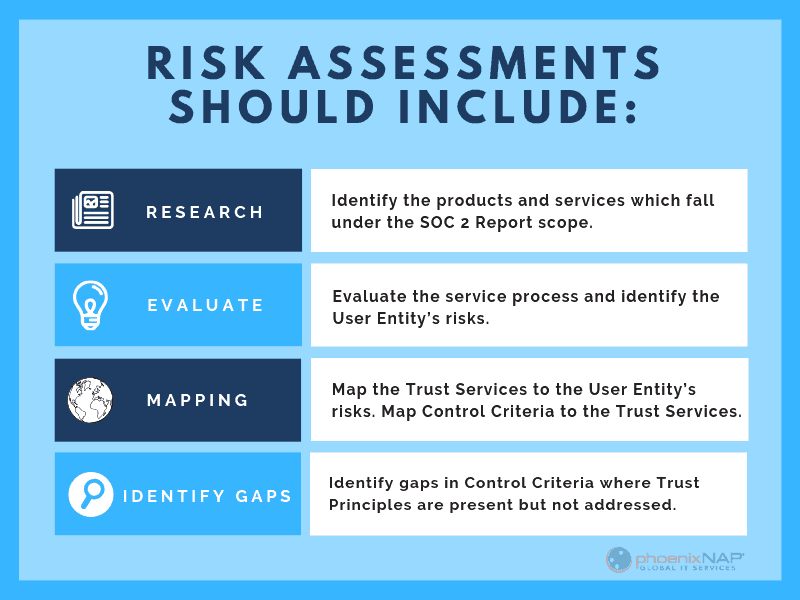
1. Identify the products and services which falls under the SOC 2 Report scope.
2. Evaluate the service process and identify the User Entity’s risks.
3. Map the Trust Services to the User Entity’s risks.
4. Map the Control Criteria to the Trust Services.
5. Identify gaps in the Control Criteria where Trust Principles are present but not addressed.
6. Map internal user controls to the gaps.
The Scope of SOC 2 Reports
Unlike strict PCI Requirements, it is not required for service providers to cover all 5 Trust Principles in a SOC 2 report. Only those that relate to their activities should be included in the scope. Care should be taken when deciding on which of the TSPs will be in the report.
For services that are outsourced, the supplier will have to show adequate controls are in place at their company’s site as part of your report.
Business Processes for the Trust Principle Assessment
The four main areas that are covered during the assessment of the company’s TSP Controls are:
Business Policies
Written policies that are relevant to the Trust Principles.
Communicating the System
The company has disclosed its policies to stakeholders and the responsible entities. This includes the users of the system.
Control Procedures
The company has procedures that will achieve the principles set out in the policies.
System Monitoring:
The company monitors the system and takes action to ensure compliance with the policies.
SOC 1 vs. SOC 2 Reports
Two types of SOC reports can be prepared. The type of report your company will need will likely depend on your User Entity’s needs. A SOC 1 Report deals with the controls at financial institutions while service-orientated companies prepare a SOC 2 Report.
Type 1 Report
The Type 1 Report records the state of the system at a point in time. This will include a description of the system, a written assertion by management, the designed controls, and the Service Auditor’s expressed opinion.
Type 2 Report
A Type 2 report further records the operating effectiveness of the system over a period of time. In addition to the items listed in Type 1, the Type 2 Report will also contain the test results of the system’s controls. It uses the 5 Trust Principles to assess the company’s risk and how they are managing exposure.
The SOC 2 Reporting Format
The Report has four main sections. Each section covers aspects of the system design, implementation, including whether it is complete and adequate.
Directors Call the System
The description of the system covers details about the services the company offers. It lists the infrastructure (such as hardware and software) that the data processing is done by. Boundaries that relate to these tasks should be recorded.
Additional items to keep in mind as part of the system description:
- Audit compliance solutions
- Risk assessment processes
- Varied system configurations at different locations
- Incident identification and response planning
The system description identifies the Trust Service Principles that should be covered. This enables you to map your Control Criteria to them and measure how effective your system is.
Management Provides a Written Assertion
This section contains the assertions made by management regarding the controls they’ve chosen to use. This is an opportunity to explain each of your methods and the controls that serve the Trust Services Criteria.
If the privacy principle forms part of the report, proof of compliance with the commitments stated in the privacy practice must be shown.
If a subservice is used for any portion of your system, this section should include:
- Details on how information is provided or received from the service provider.
- Controls at the service provider that deals with the handling, processing, maintenance, and storage of information.
Trust Principles that are excluded from the report should be listed along with the reasons why they are not covered.
Design and Operational Effectiveness Details
Section 3 of the SOC 2 Report contains a list of the controls that were designed.
If you are preparing a Type 1 Report, list the designed controls that meet the TSP criteria. For a Type 2 Report, you should include the test results for each of the designed controls. This can be in done in a table format.
To create a suitable control design, your company has to identify the risks that stand in the way of achieving your TSP. You will have to see if your control works as described and make sure there are no other risks that stop you from reaching your TSP.
Expressed Opinion by Service Auditor
The Auditor’s opinion will be based on:
- Whether the description of the system was fair.
- If the controls work as they are supposed to (for a Type 2 Report this is done over a period of time).
- If the description presents how the system was designed and built.
- It doesn’t leave out or distorts information regarding the system.
- The company complies with its privacy practices (if it was part of the scope).
As part of their opinion, the Service Auditor will list deviations and areas that lack control in the system.
Remember – SOC 2 Certification Creates Trust
When you achieve SOC 2 Compliance and Certification, it will inspire and grow trust in your organization.
User Entities may ask for a SOC 2 Report, and they will specify their TSP needs in the request. In cases like this, the report should be based on their request.
Each Trust Principle covered in the SOC 2 Compliance Report is an opportunity to earn the trust of your clients.
Recent Posts
52 Best DevOps Tools For Automation, Monitoring, & Development (Definitive List)
An essential aspect of software delivery and development is the collaboration and communication that takes place between operations professionals and project management teams.
IT experts, programmers, web application developers, and DevOps experts have worked together to create numerous tools that make this possible. Discover what DevOps tools are, why you need to track KPIs and metrics, and how to choose the right one.
What is DevOps?
In short, the term “DevOps” is a combination of the terms ‘development and operations’.
The term refers to the tools, people, and processes that work together in software development processes. The primary goal is to create a faster, more streamlined delivery.
DevOps use technology and various tools of automation to increase and improve productivity across teams working together. When you are working to scale to your project, the top DevOps tools are going to help you get there faster.
Devops Development Tools
1. Docker
Docker has been a forerunner in containerization. Regarded by many to be as crucial to DevOps as Word to writing or Photoshop to image-editing.
Docker provides agile operations and integrated container security for cloud-native and legacy applications.
Docker automates app deployment and makes distributed development easy. Dependency management isn’t a significant concern with Docker as it can package dependencies.
- Secure and automated supply chain to reduce time to value.
- Google Cloud and AWS both offer built-in support for Docker.
- New and existing applications are supported.
- Turnkey enterprise-ready container platform.
- Docker containers are platform-independent with virtual machine environments.
2. Kubernetes
Kubernetes builds on what Docker started in the containerization field.
Kubernetes was developed by a pair of Google engineers looking to apply Docker’s concepts to scalable projects. The result was a tool that can group containers by logical categorization.
Kubernetes may not be necessary for small teams but have proven vital for large projects.
For large teams, an application like Kubernetes is vital to managing what might otherwise be unwieldy.
- Kubernetes can deploy to multiple computers through automated distribution.
- Kubernetes is primarily useful in streamlining complex projects across large teams.
- Kubernetes is the first container orchestration tool developed for public release.
3. Puppet Enterprise
Puppet Enterprise is a configuration management tool favored among large teams. Puppet Enterprise automates the infrastructure management process to reach a ship date quickly and securely.
Puppet Enterprise is useful for small teams and vital for large projects. It allows for the management of multiple coding and asset teams and many resources.
- Integrates well with most major DevOps tools.
- Puppet features more than five thousand modules.
- Offers real-time reports, node management, and access control delineated by role.
4. Ansible
Ansible is a lightweight option to Puppet.
Ideal for smaller teams in need of a fast, user-friendly configuration management tool. Developers working with dozens or hundreds of team members should use Puppet. Developers in need of a quick, light, and secure management tool should consider Ansible.
- Runs clean and light with no daemons or agents in the background.
- Features several modules.
- Integrates neatly with Jenkins.
5. Gradle
Gradle has been around since 2009 as an alternative to Apache Ant and Maven. A building tool that allows users to code in C++, Python, and Java, among other languages.
Supported by Netbeans, IntelliJ IDEA and Eclipse, and used by Google as Android Studio’s official build tool. Gradle has a learning curve owing to its Groovy-based DSL. Gradle is worth that extra time investment for the time it will save in the long run.
- Gradle is estimated to be 100 times faster than Maven. The increase in speed owes to Gradle’s daemon and build cache.
- The team has released a Kotlin-based DSL for users who would rather skip the learning process for Groovy.
- GWorkspace should be familiar to Maven users.
6. CodePen
CodePen is made with both developers and designers in mind. It is a social development platform meant to showcase websites. Developers can build web projects online and then instantly share them.
CodePen’s influence extends to building test cases and fueling innovation. Coding results are viewable in real-time. CodePen is a place for new ideas, to improve skills, socialize, and showcase talents for an employer.
- The code can be written in a browser.
- A variable editor is suitable for different code levels.
- Focuses on preprocessing syntaxes that associate directly with HTML, CSS, and JavaScript.
- Users have access to a blog, as well as a collection of projects.
7. TypeScript
TypeScript is a popular solution developed on GitHub. It works with any JavaScript host which supports ECMAScript 3 and newer environments. TypeScript is best suited for large apps with robust components and productivity.
Developers use TypeScript to leverage complex code, interfaces, and libraries. It increases efficiency when coordinating JS libraries and workflows. Code refactoring, defining interfaces, static checking, and insights into the behavior of libraries work seamlessly with TypeScript.
- TypeScript is an open-source solution.
- It is especially useful for Angular projects.
- Installable via a Node.js package.
- Works with Visual Studio, Sublime Text, Atom, Eclipse, and more.
- Features include optical static typing, overwriting properties, mock-up spread behavior, and strict checking options.
8. Vue.js
Vue.js is a front-end solution for building web interfaces. It is a JavaScript library that exists as an elaborate framework. Vue owes some of its success to its streamlined design and cutting-edge approach.
Vue is easy to learn. Its scaled solutions appeal to a variety of developers. UIs and single-page applications can be built using Vue.
- Vue is a progressive JavaScript framework existing as an MIT-licensed open source project.
- Several tools are coordinated with the JavaScript core.
- Vue is widely accepted by the developer community and is continuing to grow.
- Designed from the ground up to scale as an overview library to help streamline complex single-page applications.
9. Angular
Angular has been one of the top front-end solutions for years. Its success is owed to being a Google product but amassed a diverse following among the Github developer community. Its latest version is considered a significant improvement in technology.
Angular can build web applications for both mobile and desktop platforms. The structured framework dramatically reduces the redundancies associated with writing code.
- Angular is open-source.
- Created from the input of a team at Google, corporations, and individuals.
- Uses HTML as a template language.
- Angular’s HTML extensions facilitate the wide distribution of web applications.
10. Ionic 3
Ionic is a cross-platform software development kit (SDK). It has applications for front-end and mobile app development. However, it is best known for developing hybrid mobile apps.
In addition to mobile, the dynamic SDK can build web-optimized and desktop apps. It achieves this with a single shared code base for all platforms.
Ionic converts HTML, CSS, and JavaScript to native code. The native features of the UI are top-rated, especially among the fast-paced mobile development community.
- Ionic is built on Angular.
- An established community on Slack and StackOverflow provides substantial support.
- Ionic is entirely open-source.
- There is a high availability of plugins and built-in push notifications.
11. Django
Django is a powerful Python web framework designed for experienced developers. But, it can also be quickly learned. Django emphasizes practicality, security, and efficiency to ease the development of database-driven websites.
Django Supports projects on the back-end of development. Developers can work liberally because Django helps them avoid common mistakes. Apps can be written more efficiently using the flexible framework.
Django is an asset to fast-growing sites. It facilitates dynamic applications and rapid scalability.
- Django is a powerful, fast, and open source.
- Applications quickly move from concept to completion.
- Security is fundamental to the framework.
- It is entirely written in Python.
- Associated languages include HTML, CSS, Bootstrap, JavaScript, jQuery, and Python 3.
Continuous Integration DevOps Tools
12. Bamboo
A CI/CD server solution developed by Atlassian. Bamboo works from the code phase through to deployment, delivery, and continuous integration.
Compatible with Jira Software, Fisheye, Crucible, and hundreds of other tools. Bamboo is available in a variety of languages. It features a plethora of functions, including those for both deployment and searching.
With dedicated agents, you can run fixes and builds instantly to keep production moving. There is a clear visualization of all JIRA software issues so that each team can decipher what they need to do before deploying and throughout production before anything goes live.
For many users, the cost of Bamboo will make it a hard sell compared to Jenkins. For projects and teams with a budget, Bamboo may be preferable for a few reasons. Pre-built functionalities mean that Bamboo’s automation pipeline takes less time to configure than Jenkins.
- Bamboo’s user interface is intuitive and user-friendly.
- Features tools, tips, and auto-completion.
- Bamboo offers easy integration with branching versions through Git and Mercurial.
- For team leaders with expenses in mind, it can save many development hours.
13. TeamCity
TeamCity allows up to 100 different job configurations.
Three builds are capable of running at the same time, with extra agents allowed to be added as you need them. Before you decide to make any changes, you can run a build, check, and complete automated testing.
Whenever you want to run a report on the build, you can. You don’t have to wait for something to finish up before figuring out something is going wrong.
A forum is available that provides access to peer support, or you can file a request to have a feature fixed or repair any bugs.
14. Chrome DevTools
Chrome DevTools is built into the Google Chrome browser allowing for on-the-fly page edits. The objective of Chrome DevTools is to improve UX and performance.
Users are at the center of Chrome DevTools. Its user-friendly interface caters to everyone, from beginners to experienced users.
- Streamlines operations and quick access for users.
- Improves workflows.
- View and change any page.
- Instantly jump to an element to edit.
- Experienced developers can easily optimize website speeds and inspect network activity.
- Debugging incorporates code pauses with breakpoints, workspaces saving changes, dynamic snippets, reference, and local overrides.
15. Sublime Text
Sublime Text is a text editor for coding, markup, and prose. It is a sophisticated cross-platform solution with a Python programming interface. Sublime Text natively supports languages and plugins under free-software licenses.
As a high-level tool, Sublime Text requires time to master. The focus is on performance over functionality. The UI is friendly but comes with remarkable features.
Plugins augment the built-in functionality of the Python API. Its package ecosystem provides easy access to thousands of community-built items.
- Sublime Text is free to evaluate, but is proprietary and requires the purchase of a license.
- The evaluation period currently has no time limit.
- Powered by a customizable UI toolkit.
16. Sumo Logic
The main focus of Sumo Logic is log data. It’s built to help you understand your log data and make more sense of it. To do this, you call upon a variety of features that analyze this data in immense detail.
Sumo Logic can provide your organization with a deep level of security analytics by merging this with integrated threat intelligence.
- Can be scaled infinitely
- Works with Azure Hybrid applications
- Helps reduce your downtime and move to a more proactive monitoring system
17. Postman
Postman is used for performing integration testing on APIs. It delivers speed, efficiency, and improves performance. Postman performs well at both manual and exploratory testing.
The GUI functions can be used as a powerful HTTP client for testing web services. Postman markets itself as the only platform that can satisfy all API needs. It supports all the stages of the API lifecycle.
Developers can automate tests for a variety of environments. These tests can be applied to persistent data, simulations, or other measures of user interaction.
- Developers are onboarded to an API faster.
- Available as a plugin for Google Chrome.
- Built-in-tools are capable of testing, monitoring, automation, debugging, mock servers, and more.
18. Git Extensions
Git Extensions is a standalone GUI for Git used for managing repositories. The shell extension provides context menus for files and directories.
Git Extensions enables the use of Git without the command line. A CLI is unnecessary to control Git.
The ease and extent of its controls make it a top choice among developers. It focuses on intuitive Windows functionality.
- Supports 32bit and 64bit systems.
- Compatible with Linux and Mac OS through Mono.
- Shell extensions integrate with Windows Explorer.
- A Visual Studio extension is available.
Devops Automation Tools
19. Jenkins
A DevOps automation tool, Jenkins is a versatile, customizable open-source CI/CD server.
The Butler-inspired name is fitting. Jenkins can, with proper instruction, perform many of a user’s most tedious and time-consuming tasks for them. Success can be measured at each stage of an automated pipeline, allowing users to isolate specific problem-points.
The pipeline setup can be imposing for first-time users, but it does not take long to learn the interface. Jenkins is a crucial tool for managing difficult and time-consuming projects.
- Jenkins runs on Windows, Linux and Mac OS X.
- Jenkins can be set up with a custom configuration or with plugins.
- Jenkins has been criticized for its UI, which some feel is not user-friendly. Many users take no issue with the interface. This is a concern that seems to come down to personal preference.
20. CA Release Automation
Continuous delivery is possible with CA Release Automation’s deployment that can happen at regulated speeds across your entire enterprise automatically.
What used to take days can be done in just a few minutes so that there is no unexpected work popping up out of nowhere slowing down your productivity. You can be the first one to the market with shorter release cycles that happen up to 20 times faster than before.
Every complicated aspect of applications, environment, and tools are controlled by one program. Your visibility will increase, and you will see your reliability and consistency improve as well. Errors in production have gone down for some as much as 98%. It is both cloud and mainframe ready for quick and easy integration to your existing infrastructures.
21. XebiaLabs
Container, legacy, and cloud environments are all capable of setting up automated deployments with the XebiaLabs software delivery pipeline.
The likelihood of having failed deployments and errors during the process reduces and speeds increase. You stay in control of the deployment with a self-service option.
Visibility improves the status of deployment environments and applications. The DevOps tool can easily be worked in with the current programs and systems that you are already working with so that everything across public and private clouds is completed with ease. Enterprise security and centralized auditing are all capabilities of the XebiaLabs.
Developers can reduce time spent on the administrative side, allowing for much more to be done in a shorter time frame.
22. UrbanCode Deploy
UrbanCode Deploy allows for automated deployments as well as rollbacks of all your applications.
You can update, provision, and de-provision in various cloud environments. Collaborate changes across all your tiers, servers, and components for a more seamless process.
Security differences and configuration can also take place in all different environments. Have a clear visualization of who changed what and what is getting deployed at any given time.
Devops Monitoring Tools
23. Nagios
Nagios is a free tool that is one of the most popular DevOps applications available. Allowing for real-time infrastructure monitoring, Nagios feeds out graphs and reports as you need them, as the data is being produced.
The tool’s reporting provides early detection of outages, security threats, and errors. Plug-ins are a significant draw for Nagios users.
When problems arise, you are made aware of them instantly. Many issues can even be resolved automatically as they are found.
There are thousands of add-ons available for free, as well as many tutorials and how-tos. A large helpful community supports Nagios.
- Free and open-source.
- Available in Nagios Core, Nagios XI, Log Server, and Nagios Fusion. Core is a command-line tool. XI uses a web-based GUI. Log Server searches log data with automatic alerts. Fusion is for simultaneous multiple-network monitoring.
- Nagios demands a lot of set-up time before it is suited to a particular DevOps team’s environment.
24. New Relic
Every change that happens inside of your program can be seen clearly on one platform with New Relic.
Not only do they offer you the opportunity to watch what’s happening, but you can also fix problems, speed up deploy cycles, and take care of other tasks related to DevOps. The team will have the information they need to run everything in a way that works for everyone.
25. Pager Duty
Better customer, business, and employee value is the primary focus of Pager Duty.
They offer over 200 different integrations across multiple tools so that you can ticket, market, and collaborate with what you’ve already established. Some of the other features offered include analytics, on-call management, and modern incident response.
You will have a clear picture of what’s taking place, any disruptions that are occurring, and get patterns in the performance of your builds and productions throughout the delivery. Rapid resolutions, quick collaboration, and business responses are orchestrated and organized for your team.
26. Splunk
Any opportunities that might be available for your company, along with risks, can be visible with the Splunk DevOps product. Splunk uses predictive and actionable insights with artificial intelligence and machine data.
The business analytics can help you in better understand:
- Why you are losing customers,
- How much money you could make in certain situations
- Whether or not the people that are using your programs are accepting of new features and products you introduce.
27. Raygun
Raygun is a monitoring system used to catch errors and crashes.
Raygun recently released an application performance monitoring platform used to diagnose performance issues. Raygun is user-friendly and conducts much of its work with little set-up. Error reports are generated automatically with prioritization letting users know which problems need to be addressed first.
By linking errors to specific points, Raygun can save hours of manual bug fixing work.
- Automatically links errors to specific lines of source code.
- Consolidates both development and operations reporting for all relevant teams.
- Raygun APM can be applied to other DevOps tools like Jenkins to track development at every level.
28. Plutora
Plutora has been dubbed as one of the most complete VSM platforms out there. A VSM (Value Stream Management) tool that’s designed to give you everything you need to scale DevOps throughout your organization. Plutora lets you set up a map to visualize all of your value streams, allowing you to take data from all of your critical systems.
- Plutora includes deployment management, release management, and planning & idea management
- You can manage your ‘Kaizen’ throughout the process at every delivery stage
- vastly improve the speed and quality of your complicated application delivery.
- Contains governance & compliance features that ensure policy adherence for every process
29. Loom Systems
Loom Systems calls upon artificial intelligence and machine learning to help prevent problems in organizations. It does this by predicting what issues may arise, so developers can take steps to stop them from happening.
The core of Loom Systems is ‘Sophie’ – who is essentially your virtual IT assistant. She gives you ideas based on any detected issues as soon as they’re detected. She can also manage your feedback by learning from what went wrong and automatically improving things.
Sophie is currently the only system in the industry that can accurately predict IT issues before they create a negative impact on customers while providing solutions in easy-to-understand terms.
- It’s suggested that around 42% of P1 incidents are predicted using Loom Systems
- Loom can boost business productivity by adding automation
- Provide you with more time to focus on other essential DevOps tasks
30. Vagrant
Vagrant is built around the concept of automation. It can be used in conjunction with other management tools on this list, and it lets you create virtual machine environments all in the same workflow.
By doing this, it gives the entire DevOps team a better environment to continue with development. There’s a shorter set-up time for the development environment, which improves productivity as well.
Many companies have started using Vagrant to help transition into the DevOps culture.
- Vagrant is compatible with various operating systems, including Windows, Mac, and Linux
- Can be used and integrated with Puppet, Ansible, Chef, and more
31. Prometheus
Prometheus is a service monitoring system that helps to power your metrics and alerting. It does this by using a highly dimensional data model, along with powerful queries.
One of the great things about Prometheus is that you can visualize data in a variety of ways. As such, this makes analyzing data far easier for everyone involved.
Plus, you can export data from third-party solutions into Prometheus, which essentially means it works with different DevOps tools, such as Docker.
- Custom libraries that are easy for you to implement
- A very flexible query language
32. Chef
Chef is all about improving your DevOps processes and making life far easier for you. The main focus is on increasing the speed and consistency of tasks, while also enabling you to scale them with relative ease.
The exciting thing about Chef is that it’s a cloud-based system, which means you can access it from any device whenever you want. One of the drawbacks of cloud systems is that they might be unavailable due to server issues. Chef is found to maintain a high level of availability.
With Chef, you can make complicated tasks far easier by calling on automation to carry out different jobs and free up your own time.
- Helps to control your infrastructure
- Is used by big companies like Facebook and Etsy
Devops Collaboration & Planning Tools
33. Git
Remote teams have become standard in software development.
For many software companies, Git is the go-to solution for managing remote teams.
Git is used for tracking a team’s progress on a particular project, saving multiple versions of the source code along the way. Organizations can develop branching versions of the code to experiment without compromising the entire project.
- Git requires a hosted repository. The obvious choice is Github, although competitor Bitbucket has much to offer. Bitbucket offers free unlimited private repos for up to five members of a team.
- Slack can be integrated with either GitHub or Bitbucket.
- Separate branches of source code can be merged through Git.
Source code management tools like Git are necessary for the modern software development field. In that niche, Git stands as the leader.
34. Clarizen
Clarizen is a cloud-based management software DevOps product that makes sure everyone stays involved and engaged in what’s happening with your specific project.
Through aligned communication, you can develop new strategies and share resources. Automated processes can be set with alerts.
Managers can view t in real-time with the 360-degree visualization for the most accurate decisions based on customized data.
35. Slack
Slack enables your team to the opportunity to communicate and collaborate all on one platform.
Valuable information can quickly and easily be shared with everyone involved in a specific project on message boards.
Channels can be set up by topic, team, project, or, however, else you see fit. When information from the conversation is needed, there is a search option that allows for easy access. Slack is compatible with many services and apps you are already using.
36. Basecamp
Basecamp is a way for everyone to stay connected and accountable in an efficient and organized manner. Individual projects can be customized to suit specific requirements.
Each morning, you have the option of getting a summary of the previous day’s activities sent directly to your email. Many functions are available to streamline the process of working within a team:
- Message boards, documents file storage, to-do lists, schedules, check-in questions, and real-time chat.
- Access to clients direct messages
37. Asana
Plan out your team’s projects, assign tasks, set due dates, and stay more organized with Asana. View each stage of the project as it’s happening to ensure things are progressing.
Everyone has a visual representation of the plan and what steps need to be taken to reach the finish line. When something isn’t progressing the way you intended it to, changes can be made shared.
38. NPM
NPM interacts with a remote registry to build JavaScript applications. It focuses on security and collaboration. NPM provides enterprise-grade features while facilitating compliance.
Organizations profit from NPM’s streamlined go-to-market strategies. Zero-configuration functions help to improve team goals by easing collaboration.
NPM assists organizational efforts by simultaneously reducing risk and internal friction. It consolidates resources under a single sign-on to manage user access and permissions. This helps to support operations that depend on structured flows.
- NPM is open-source.
- Interacts with the world’s largest software registry.
- NPM has 100% parity with public registry features, which are in high demand today.
The built-in, zero-friction security design enables greater collaboration and flexibility for on-demand apps.
39. GitKraken
GitKraken incorporates developer experiences to create a cross-platform Git client. It is streamlined for active developers. GitKraken delivers efficiency, reliability, and excellence.
In addition to advanced cross-platform functionality, GitKraken is reportedly a pleasure to use. It is designed with a fast learning curve in mind.
This intuitive GUI client is consistent and reliable. It is a version control system that goes beyond basic software development. Power is merged with ease-of-use through features like quickly viewable information via hovering.
- GitKraken is available on Windows, Mac OS, Ubuntu, and Debian.
- It is built on Electron, an open-source framework.
- A free version is available.
- Among its capabilities are pushing, branching, merging, and rebasing.
- GitKraken is independently developed.
40. Visual Studio
Visual Studio is a Microsoft product. It is an integrated development environment (IDE). Visual Studio has applications for both the web and computer programs.
The broad spectrum of web uses includes websites and associated apps, services, as well as mobile technology. It is considered a go-to, best-in-class solution.
Visual Studio’s Live Share offers benefits beyond Microsoft platforms. It is available for developers and services on any platform and in any language. Both native and managed code can be used.
- Windows availability includes API, Forms, Store, Silverlight, and Presentation Foundation.
- Thirty-six language programs are supported.
- Advanced code editing and debugging for any OS.
- Its app center provides continuous delivery, integration, and learning.
Planning
41. GitLab
GitLab is an internal management solution for git repositories. It offers advantages for the DevOps lifecycle via a web-based engine.
The complete software lifecycle comes under a single application. Starting with project planning and source code management, GitLab extends to the CI/CD pipeline, monitoring, and security. The result is a software lifecycle that is twice as fast.
GitLab established features include planning, creation, management, verification, packaging, release, configuring, monitoring, security, and defense. The defend feature was introduced in 2019. All of the other features have updates and/or expanded functions in the works for 2020.
Available through the GitLab open-source license.
GitLab provides Git repository management, issue tracking, activity feeds, code reviews, and wikis.
42. Trello
Trello is a DevOps collaboration tool that helps improve the organization of your projects. Get more done with Trello by prioritizing projects and improving teamwork.
You can set up different teams and create tasks for everyone to carry out. This ensures that all team members are on the same page and know what they have to do – and what’s essential for them.
Trello allows everyone to interact and communicate with one another on one straightforward and intuitive platform.
- Highly flexible, meaning you can use Trello however you see fit.
- Integrates a range of third-party apps that your team already uses
- Keeps your team in-sync across all devices
Continuous Feedback
43. Mouseflow
Mouseflow focuses on continuous feedback from the customer. It won’t deliver surveys or direct words of feedback, but it does let you see how customers react.
Mouseflow uses heatmaps. You see where all of your visitors are going on your website, and what they’re doing. It’s a genius way of figuring out where the positive and negative aspects of your site lie.
With this tool, you can unlock analytics data that helps you understand why people are possibly leaving your site/application, allowing you to make changes to address this.
- Very easy to use and works on all web browsers
- Contains a Form Analytics feature to see why visitors leave online forms
- Tracks a variety of different funnels
44. SurveyMonkey
There’s no better way to understand what your customers are thinking than asking them.
SurveyMonkey allows you to do that along with providing several other operations, including researching, obtaining new ideas, and analyzing the performance of your business.
Continuous feedback is how to uncover what your clients are expecting from you. Not only can you survey your customers, but you can also use it to find out what your employees are thinking about how things are working within the company.
45. Jira Service Desk
Tracking, obtaining, managing, and addressing customer requests are possible through Jira Service Desk.
It’s where customers can go to ask for help or fill out various forms so that you can get to the bottom of any issues and improve the overall experience of your project so that the people are getting what they want.
Service requests are automatically organized and prioritized by importance with the Jira Service Desk tool.
Your employees can work through the requests quickly to resolve issues more efficiently. When there are critical submissions, an alert will come through, ensuring that you don’t miss anything.
You can also create a resource knowledge base that your clients can use to answer their own questions.
46. SurveyGizmo
This is another feedback tool that works similarly to SurveyMonkey. You can invite people to respond to your surveys and gain a lot of constant information from your customers.
There are many different ways you can construct a survey and select the questions you want to include. With this tool, you’re empowered to make smarter decisions based on the research you generate. There are segmentation and filtering features that help you find out what’s good and bad about your product.
Plus, the surveys look more appealing to potential customers. This could ensure that more people are willing to fill them in.
- Offers quick and easy survey configuration
- Can correlate feedback to positive and negative experiences for a simple overview
Issue Tracking
47. Mantis Bug Tracker
Mantis Bug Tracker provides the ability to work with clients and team members in an efficient, simple, and professional manner.
It’s a practical option for clearing up issues quickly while maintaining a balance of power and simplicity. You have the option of customizing the categories of problems along with workflows and notifications. Get emails sent when there are problems that need to be resolved right away.
You maintain control of your business while allowing specific users access to what you want.
48. WhiteSource Bolt
Security is a critical concern in DevOps.
With WhiteSource Bolt, you have an open-source security tool that helps you zone in on any security issues and fix them right away.
It’s a free tool to use, and you can use it within Azure or GitHub as well. The main aim of the tool is to give you alerts in real-time that show all of your security vulnerabilities. It then gives you some suggested fixes that you can act upon to sure up security and remove the weakness.
- Supports well over 200 different programming languages
- Provides up to 5 scans per day
- Can scan any number of public and private repositories
49. Snort
Snort is another security tool for DevOps that works to protect a system from intruders and attacks.
This is considered one of the most powerful open-source tools around, and you can analyze traffic in real-time. By doing so, it makes intruder detection far more efficient and faster. Snort also can flag up any aggressive attacks against your system.
There are over 600,000 registered users on the Snort platform right now, making it the most widely deployed intrusion prevention system out there.
- Packet logging and analysis provides signature-based attack detection
- Performs protocol analysis and content searching
- Has the ability to detect and flag up a variety of different attacks
50. OverOps
Code breaks are part and parcel of the DevOps life. OverOps is a tool that’s useful at identifying any breaks in your code during the production process.
Not only that, but it gets down to the root cause of an issue and informs you why there was a code issue and exactly when it happened. You’ll be faced with a complete picture of the code when the abnormality was detected, so you can reproduce and fix the code.
- Integrates with Jenkins
- Stops you from promoting bad code
- Uses Artificial Intelligence to spot any new issues in real-time
51. Code Climate
Code Climate is one of the top issue tracking tools for DevOps professionals. With this software, you get a detailed analysis of how healthy your code is. You can see everything from start to finish, which lets you pinpoint any issues.
DevOps professionals can easily see any problems in a line of code and fix them as soon as possible. Therefore, you can start producing better code with fewer errors and bugs – which will only improve the overall customer experience upon launch.
- Very easy to integrate into any workflow
- Let’s you built code that’s easy for everyone to maintain
52. ZenDesk
Zendesk works for companies of all sizes by improving customer service and support.
Choose from hundreds of applications, or use the features as is. Your development team can even build a completely customized tool taking the open APIs offered on the Apps Marketplace.
Zendesk provides benchmark data access across your industry. This is valuable data to improve your customer interactions.
How to Choose the Right DevOps Tool
There is no secret method for choosing proper DevOps tools. You are going to be implementing them across a variety of operational and development teams, so it should be thought of as more of a shift in the existing culture.
No single tool works across all areas of development and delivery. But several tools will work in different areas. You first need to discover your processes, and then you can more easily determine which DevOps security products you will be able to utilize successfully.
A straightforward way to break down your cycle of development is by doing so in phases.
The main phases are:
- Collaboration – deciding which tools everyone can agree on and share across multiple platforms for complete integration.
- Planning – being able to share ideas, brainstorm, comment, and work towards a common goal
- Build -includes the development of software along with coding against any virtual or disposable duplicates to speed up production and get more accomplished.
- Continuous integration – obtaining constant and immediate feedback through the process of merging code. It happens many times a day using automatic testing tools.
- Deploy – deploying predictable, reliable, and frequent applications to keep production running smoothly and risks low through automation.
- Operate – application and server performance monitoring that records and watches data around the clock to ensure it’s working correctly.
- Continuous feedback – user comments, support tickets, Tweets, NPS data, churn surveys, bug reports, and other feedback collected to determine if what’s being built is working.
DevOps Tools Streamline Processes
When you integrate DevOps early in software development, you are streamlining the process. Anyone looking to create and deliver a software program more quickly and efficiently than the more traditional methods can utilize these applications.
Decide which applications above are most useful for your needs and start developing more efficiently today!
Recent Posts
Data Center Security: Physical and Digital Layers of Protection
Data is a commodity that requires an active data center security strategy to manage it properly. A single breach in the system will cause havoc for a company and has long-term effects.
Are your critical workloads isolated from outside cyber security threats? That’s the first guarantee you’ll want to know if your company uses (or plans to use) hosted services.
Breaches into trusted data centers tend to happen more often. The public notices when news breaks about advanced persistent threat (APT) attacks succeeding.
To stop this trend, service providers need to adopt a Zero Trust Model. From the physical structure to the networked racks, each component is designed with this in mind.
Zero Trust Architecture
The Zero Trust Model treats every transaction, movement, or iteration of data as suspicious. It’s one of the latest intrusion detection methods.
The system tracks network behavior, and data flows from a command center in real time. It checks anyone extracting data from the system and alerts staff or revokes rights from accounts an anomaly is detected.
Security Layers and Redundancies of Data Centers
Keeping your data safe requires security controls, and system checks built layer by layer into the structure of a data center. From the physical building itself, the software systems, and the personnel involved in daily tasks.
You can separate the layers into a physical or digital.
Data Center Physical Security Standards
Location
Assessing whether a data center is secure starts with the location.
A trusted Data Center’s design will take into account:
- Geological activity in the region
- High-risk industries in the area
- Any risk of flooding
- Other risks of force majeure
You can prevent some of the risks listed above by having barriers or extra redundancies in the physical design. Due to the harmful effects, these events would have on the operations of the data center; it’s best to avoid them altogether.
The Buildings, Structures, and Data Center Support Systems
The design of the structures that make up the data center needs to reduce any access control risks. The fencing around the perimeter, the thickness, and material of the building’s walls, and the number of entrances it has. All these affect the security of the data center.
Some key factors will also include:
- Server cabinets fitted with a lock.
- Buildings need more than one supplier for both telecom services and electricity.
- Extra power backup systems like UPS and generators are critical infrastructure.
- The use of mantraps. This involves having an airlock between two separate doors, with authentication required for both doors
- Take into account future expansion within the same boundary
- Separate support systems from the white spaces allow authorized staff members to perform their tasks. It also stops maintenance and service technicians from gaining unsupervised entry.
Physical Access Control
Controlling the movement of visitors and staff around the data center is crucial. If you have biometric scanners on all doors – and log who had access to what and when – it’ll help to investigate any potential breach in the future.
Fire escapes and evacuation routes should only allow people to exit the building. There should not be any outdoor handles, preventing re-entry. Opening any safety door should sound an alarm.
All vehicle entry points should use reinforced bollards to guard against vehicular attacks.
Secure All Endpoints
Any device, be it a server, tablet, smartphone or a laptop connected to a data center network is an endpoint.
Data centers give out rack and cage space to clients whose security standards may be dubious. If the customer doesn’t secure the server correctly, the entire data center might be at risk. Attackers are going to try to take advantage of unsecured devices connected to the internet.
For example, most customers want remote access to the power distribution unit (PDU), so they could remotely reboot their servers. Security is a significant concern in such use cases. It is up to facility providers to be aware of and secure all devices connected to the internet.
Maintain Video and Entry Logs
All logs, including video surveillance footage and entry logs, should be kept on file for a minimum of three months. Some breaches are identified when it is already too late, but records help identify vulnerable systems and entry points.
Document Security Procedures
Having strict, well-defined and documented procedures is of paramount importance. Something as simple as a regular delivery needs to well planned to its core details. Do not leave anything open for interpretation.
Run Regular Security Audits
Audits may range from daily security checkups, and physical walkthroughs to quarterly PCI and SOC audits.
Physical audits are necessary to validate that the actual conditions conform to reported data.
Digital Layers of Security in a Data Center
As well as all the physical controls, software, and networks make up the rest of the security and access models for a trusted data center.
There are layers of digital protection that aim to prevent security threats from gaining access.
Intrusion Detection and Prevention Systems
This system checks for advanced persistent threats (APT). It focuses on finding those that have succeeded in gaining access to the data center. APTs are typically sponsored attacks, and the hackers will have a specific goal in mind for the data they have collected.
Detecting this kind of attack requires real-time monitoring of the network and system activity for any unusual events.
Unusual events could include:
- An increase of users with elevated rights accessing the system at odd times
- Increase in service requests which might lead to a distributed-denial of service attack (DDoS)
- Large datasets appearing or moving around the system.
- Extraction of large datasets from the system
- Increase in phishing attempts to crucial personnel
To deal with this kind of attack, intrusion detection and prevention systems (IDPS) use baselines of normal system states. Any abnormal activity gets a response. IDP now uses artificial neural networks or machine learning technologies to find these activities.
Security Best Practices for Building Management Systems
Building management systems (BMS) have grown in line with other data center technologies. They can now manage every facet of a building’s systems. That includes access control, airflow, fire alarm systems, and ambient temperature.
A modern BMS comes equipped with many connected devices. They send data or receive instructions from a decentralized control system. The devices themselves may be a risk, as well as the networks they use. Anything that has an IP address is hackable.
Secure Building Management Systems
Security professionals know that the easiest way to take a data center off the map is by attacking its building management systems.
Manufacturers may not have security in mind when designing these devices, so patches are necessary. Something as insignificant as a sprinkler system can destroy hundreds of servers if set off by a cyber-attack.
Segment the System
Segmenting the building management systems from the main network is no longer optional. What’s more, even with such precautionary measures, attackers can find a way to breach the primary data network.
During the infamous Target data breach, the building management system was on a physically separate network. However, that only slowed down the attackers as they eventually jumped from one network to another.
This leads us to another critical point – monitor lateral movement.
Lateral Movement
Lateral movement is a set of techniques attackers use to move around devices and networks and gain higher privileges. Once attackers infiltrate a system, they map all devices and apps in an attempt to identify vulnerable components.
If the threat is not detected early on, attackers may gain privileged access and, ultimately, wreak havoc. Monitoring for lateral movement limits the time data center security threats are active inside the system.
Even with these extra controls, it is still possible that unknown access points can exist within the BMS.
Secure at the Network Level
The increased use of virtualization-based infrastructure has brought about a new level of security challenges. To this end, data centers are adopting a network-level approach to security.
Network-level encryption uses cryptography at the network data transfer layer, which is in charge of connectivity and routing between endpoints. The encryption is active during data transfer, and this type of encryption works independently from any other encryption, making it a standalone solution.
Network Segmentation
It is good practice to segment network traffic at the software level. This means classifying all traffic into different segments based on endpoint identity. Each segment is isolated from all others, thus acting as an independent subnet.
Network segmentation simplifies policy enforcement. Furthermore, it contains any potential threats in a single subnet, preventing it from attacking other devices and networks.
Virtual Firewalls
Although the data center will have a physical firewall as part of its security system, it may also have a virtual firewall for its customers. Virtual firewalls watch upstream network activity outside of the data center’s physical network. This helps in finding packet injections early without using essential firewall resources.
Virtual firewalls can be part of a hypervisor or live on their own virtualized machines in a bridged mode.
Traditional Threat Protection Solutions
Well-known threat protection solutions include:
- Virtualized private networks and encrypted communications
- Content, packet, network, spam, and virus filtering
- Traffic or NetFlow analyzers and isolators
Combining these technologies will help make sure that data is safe while remaining accessible to the owners.
Data Center Security Standards

The classification system sets standards for data center’s’ controls that ensure availability. As security can affect the uptime of the system, it forms part of their Tier Classification Standard.
There are four 4 tiers defined by the system. Each tier maps to a business need that depends on what kind of data is being stored and managed.
Tiers 1 & 2
Seen as tactical services, Tier 1 and 2 will only have some of the security features listed in this article. They are low cost and used by companies who do not want real-time access to their data and who won’t suffer financially due to a temporary system failure.
They are mainly used for offsite data storage.
Tiers 3 & 4
These tiers have higher levels of security. They have built-in redundancies that ensure uptime and access. Providing mission critical services for companies who know the cost of damage to a reputation a break in service creates.
These real-time data processing facilities provide the highest standards of security.
Take Data Center Security Seriously
More and more companies are moving their critical workloads and services to hosted servers and cloud computing infrastructure. Data centers are prime targets for bad actors.
Measuring your service providers against the best practices presented in this article is essential.
Don’t wait for the next major breach to occur before you take action to protect your data. No company wants to be the next Target or Equifax.
Want Work With a State of the Art Secure Data Center?
Contact us today!
Recent Posts
Insider Threats: Types & Attack Detection CISO's Need to Know For Prevention
In this article you will learn:
- All CISO’s need to understand your biggest asset, people, can also your most significant risk.
- Insider threats are increasing for enterprises across all industry sectors. Threats can come from anyone with access to sensitive data.
- Be prepared to mitigate your risk with active insider threat detection and prevention.
What is an Insider Threat?
Insider threats are defined as cybersecurity threats that come from within your own company. It may be an employee or a vendor – even ex-employees. Anyone that has valid access to your network can be an insider threat.
Dealing with insider threats isn’t easy since the people you trust with your data and systems are the ones responsible for them.
Types of Insider Threats
There are three types of insider threats, Compromised users, Careless users, and Malicious users.
Compromised Employees or Vendors
Compromised employees or vendors are the most important type of insider threat you’ll face. This is because neither of you knows they are compromised. It can happen if an employee grants access to an attacker by clicking on a phishing link in an email. These are the most common types of insider threats.
Careless Employees
Careless employees or vendors can become targets for attackers. Leaving a computer or terminal unlocked for a few minutes can be enough for one to gain access.
Granting DBA permissions to regular users (or worse, using software system accounts) to do IT work are also examples of careless insider threats.
Malicious Insider
Malicious attackers can take any shape or form. They usually have legitimate user access to the system and willfully extract data or Intellectual Property. Since they are involved with the attack, they can also cover up their tracks. That makes detection even more difficult.
Detecting Insider Threats
Most of the security tools used today try to stop legitimate users being compromised. This includes things like firewalls, endpoint scanning, and anti-phishing tools. They are also the most common types of breaches, so it makes sense that so much effort goes into stopping them.
The other two types of profiles aren’t that easy to deal with. With careless behavior, knowing what system event was valid or not is almost impossible. Network and security admins probably don’t know the context behind an application’s behavior, so won’t notice anything suspicious before it’s too late.
Similarly, with malicious attackers, they will know the ins and outs of your company’s security system. Giving them a good chance of getting away without being detected.
The most significant issues with detecting insider threats are:
1. Legitimate Users
The nature of the threat is what makes it so hard to prevent. With the actor using their authentic login profiles, there’s no immediate warning triggered. Accessing large files or databases infrequently may be a valid part of their day to day job requirements.
2. System and Software Context
For the security team to know that something terrible is happening, they need to know what something bad looks like. This isn’t easy as. Usually, business units are the experts when it comes to their software. Without the right context, detecting a real insider threat from the security operations center is almost impossible.
3. Post Login Activities
Keeping track of every user’s activities after they’ve logged in to the system is a lot of work. In some cases, raw logs need to be checked, and each event studied. Even with Machine Learning (ML) tools, this can still be a lot of work. It could also lead to many false positives being reported, adding noise to the problem.
Indicators of Insider Attacks
Detecting attacks is still possible. Some signs are easy to spot and take action on.
Common indicators of insider threats are:
- Unexplained Financial Gain
- Abuse by Service Accounts.
- Multiple failed logins.
- Incorrect software access requests.
- Large data or file transfers.
Using systems and tools that look for these items can help raise the alarm for an attack. While regular endpoint scans (daily) will ensure workstations stay clean from viruses and malware.
Identifying Breaches in the System
Identify breaches starts with the security team understanding normal behavior.
Normal behavior should be mapped down to the lowest access and activity. Included in the logs should be the User’s ID, workstation IP address, the accessed server’s IP, employee department, and the software used.
Additionally, knowing what database was accessed, which schemas and tables read, and what other SQL operations were performed, will help the security team identify breaches.
Detect Insider Threats with Machine Learning
One area where machine learning gives a massive ROI is in network threat detection. Although it isn’t magic, it can highlight where to point your resources.
By providing the system’s state and behavioral information to a machine learning algorithm, weird and suspect actions can be identified quickly. Information like user and connection types, role access and application rights, working times and access patterns, can promptly be passed to ML applications.
Knowing what falls outside of the above normal system state can be done by mapping the following into the alert process:
- Listing table access rights per app.
- Specifying service account credentials and schemas used.
- Monitoring the usual data storage locations.
Prevent Insider Threats With Threat Scoring
Correlating the above types of information allows you to create threat scores for each user activity. Couple that to the user’s credentials, you can alert the security team soon after a breach is found.
Using this type of analytics is new to the industry. Early implementations have been successful in helping companies gain the edge on their rivals.
Vendors are starting to offer custom Security Risk Management solutions that include:
- Behavior analytics
- Threat intelligence
- Anomaly detection
- Predictive alerts
Statistics on Insider Threats
33% of organizations have faced an insider threat incident. (Source: SANS)
Two out of three insider incidents happen from contractor or employee negligence. (Source: Ponemon Institute)
69% of organizations have experienced an attempted or successful threat or corruption of data in the last 12 months. (Source: Accenture)
It takes an average of 72 days to contain an insider threat.
Take a Proactive Approach to Insider Threats
Using historical data can help you quickly build risk profiles for each of your users. Mapping their daily interactions with the data you manage will let you know where high-risk profiles are. This will allow you to proactively engage in the areas where you have the biggest concerns.
Although any point in the network poses a risk, elevated access rights have the highest potential for abuse. Implementing key indicator monitoring on these user profiles with active directory policies will reduce the amount of risk you face.
Auditing exiting employees, ensuring their credentials are revoked and they do not leave with company data is also vital. Nearly 70% of outgoing employees admit to taking some data with them out the door. If credentials are also left intact, you may as well leave the door open for them. Privileged access management is a great way to manage user.
Although unintended insider threats remain the biggest concern, it’s the malicious ones that can cause the worst disaster.
Recent Posts
What is a Whaling Attack? Identify & Prevent Whale Phishing
Are your company executives vulnerable to an attack?
A whaling attack is very similar to a phishing attack, just with bigger targets such as the c-suite. In this article, learn how to stay ahead of the threat and prevent a data breach.
What is a Whaling Attack?
A whaling attack is a spear phishing attack against a high-level executive. This is usually a C-level employee, like a Chief Executive or Chief Financial Officer.
In this attack, the hacker attempts to manipulate the target. The goal might be high-value money transfers or trade secrets. The term whaling (or whale phishing) refers to the high value of the target.
Differences Between Phishing, Whaling Phishing, and Spear Phishing
With typical phishing, attackers cast a wide net. This often means spamming a mailing list. Only a fraction of recipients needs to respond to make it worthwhile. Regular phishing attacks often ask the target for money and promise to repay more money later. The attacker then takes the money and vanishes.
A spear phishing attack is slightly different. In this type of phishing attack, the attacker identifies a specific target. Hackers learn details about their target and tailor the attack accordingly. A spear phisher might select a person in the IT department of a major corporation. Then learn that person’s habits, likes, and dislikes to use that knowledge for gaining trust. The attacker can then use social engineering against the target. The victim may grant access to sensitive data or even transfer money.
Spear phishing attacks target are regular everyday people. A whaling attack is targeting a high-level or difficult target. This is usually a C-level employee of a corporation. These targets often have better security awareness. A whaler is usually after large money transfers or trade secrets.
How Whale Phishing Works
- Urgency: One common phishing tactic is to create a sense of urgency. Whaling attacks are no different. Whaling attacks usually imply massive consequences and a short time frame. Urgency discourages the target from taking time to consider their actions.
- High risk / low effort: The attacker may threaten a costly lawsuit or public relations exposure. These threats would be disastrous to the company or individual. The hacker wants the target to bypass the security procedure. Usually, the action is simple compared to the danger. One example might be wiring funds to avoid regulatory action. Another might be clicking a link to a website that installs malware. This attack uses a substantial threat to get a low-effort response.
- Specific details: Whaling attacks can yield high rewards. Attackers spend substantial time and effort on the attack. Social engineering is often used to obtain personal information. They research the company to learn the names and achievements of different employees and use the details to exploit the target’s trust. If the target trusts the attacker, they are more likely to comply.
- Impersonation: Another common tactic is the use of impersonation. A hacker can use details from the corporation to impersonate a higher official. For example, an attacker might pose as a senior manager and ask for an employee payroll report. Or, they may pretend to be a fellow employee known by the target. Often, the email address is spoofed – or faked – to look authentic. Spoofing can include a valid-looking email address and company logos.
How to Prevent Whale Phishing
Educate employees in sensitive positions
This includes all of senior management. It’s also wise to educate employees in sensitive positions like IT and accounting. Employees in executive positions also make tempting targets. Train ALL employees to be wary of phishing and whaling attacks. If employees know what to watch for, they can protect themselves.
Senior employees should have private social media profiles
Social media sites provide a wealth of information for social engineering. An attacker might learn that an executive burned the hamburgers at a company picnic, then use that information to build credibility. Keeping profiles private helps limit an attacker’s ability to find compromising data.
Flag emails from outside the company
Whaling attacks often impersonate someone from within the company. Flagging external emails can warn users that the attacker is not who they claim to be. Attackers rarely attack from within the same company. This strategy can raise awareness of an attack.
Practice and enforce good email hygiene
Users should not click suspicious links or unsolicited attachments.
If the employee didn’t specifically request the email, they should take extra care. Anything that requires immediate and drastic action should be verified. Scan emails with a virus and malware scanner. Hover a mouse pointer over the sender’s name to see the real email address. In a web-based email, click the “more information” or “show details” to see the sender.
Use a system of verification for drastic action
Security awareness training is key. Train your staff on data security procedures, and how to check for suspicious phishing emails. Instruct sensitive employees to verify unusual requests.
For example, an employee might check the threat of a lawsuit with the legal department. Or, they might call a senior manager on the phone to verify the transfer of employee tax records. Consider a policy that requires verification for wire transfers.
Use data protection technologies
People make mistakes, and hackers are specialists in social engineering. As a last resort, implement data practices that make it difficult for one individual to cause damage.
Use access management, make sure root user access is limited to point-of-need. Also, make sure all user permissions are appropriate and necessary for each job function. Implement and maintain the usual suite of IT security tools: firewalls, intrusion detection software, and malware scanning utilities.
Active Threat Protection Keeps your Business Safe From Whaling
Whaling is a lot like spear phishing – just with bigger fish.
Whaling targets yield much bigger rewards, which creates an incentive to invest more effort into an attack. Though anyone can be vulnerable to social engineering, security training remains the best defense. High-level employees should expect to be a target, and defend themselves accordingly. In the event of a breach, incident response planning can help mitigate damage.
Recent Posts
13 Best SIEM Tools for Businesses in 2020 {Open-Source}
Choosing the right Security Information and Event Management software can be overwhelming.
The SIEM market today is nearly a $3 billion industry and growing. Gartner predicts spending on SIEM technologies will rise to almost $2.6 billion in 2020 and $3.4 billion in 2021.
As you consider threat detection systems, find the tools you’ll need to protect your organization against various types of cyberattacks. Examine how you should build out your protection.
Take the time to consider the preparations necessary for successful expansion into the technology. The benefits of a sound, real-time security system are well worth the investment.
What is SIEM?
SIEM or Security information and event management is a set of tools that combines SEM (security event management) and SIM (security information management) Both of these systems are essential and are very closely related to each other.
SIM refers to the way that a company collects data. In most cases, data is combined into a specific format, such as the log file. That format is then placed in a centralized location. Once you have a format and location for your data, it can be analyzed quickly.
SIM does not refer to a complete enterprise security solution, though it is often mistaken for one. SIM relates only to the data collection techniques used to discover problems within a system.
SEM provides real-time system monitoring and notifies network administrators about potential issues. It can also establish correlations between security events.
What are SIEM Software Tools?
SIEM products run directly on the systems they monitor. The software sends log information to a central portal. This is typically a cloud server as they have more robust security monitoring than in-house hardware. They also provide a degree of separation for added protection.
A console provides clients visual aids filtered through local parameters. Cybersecurity incidents can be identified, recreated, and audited through accounting logs.
How Security Information Event Management Works
SIEM works by identifying the correlation between separate log entries. More advanced platforms also include entity and user behavior analysis (UEBA). Other systems may also include SOAR. SOAR stands for “Security Orchestration and Automated Response.” UEBA and SOAR are very helpful in specific instances.
Security Information and Event Management also works by monitoring and logging data. Most security operations experts consider SIEM tools to be more than a simple monitoring and logging solution.
A SIEM security system includes:
- Actively develops lists of global threats based on intelligence.
- Collecting logs from vetted sources of intelligence.
- A SIEM solution consolidates and analyzes log file, including supplemental analytics data to enrich the logs.
- Finds security correlations in your logs and investigates them.
- If a SIEM rule is triggered, the system automatically notifies personnel.
Best Practices for Using a SIEM Solution
Identify Critical Assets To Secure
The first thing organizations must do is identify critical assets thru security risk management. Identification leads to prioritization. No company has the resources to protect everything equally. Prioritizing assets allows an organization to maximize its security within a budget.
Prioritizing assets also help in selecting a SIEM solution
Understanding a companies needs also helps to scale the SIEM platform used. SIEM technology can help with low-level compliance efforts without much customization.
Enterprise visibility is another goal altogether. This requires a much higher level of deployment. This goal does not require as much customization. Does your company know its goals? Take the time to form a detailed strategy before investing.
Train Staff to Understand SIEM Software
The second step is to ensure that in-house staff understands SIEM as a platform.
What system log files will the SIEM technology solution monitor? Does your company use a variety of logs? You may process data differently in various departments. You must normalize these logs before a SIEM security helps you. Different logs do not allow the system to execute to its maximum potential or deliver actionable reports. Why? The data is not consistent.
Create a Scaling Strategy
Some companies duplicate a logging strategy as they expand. The need for servers will eventually increase. As it does, the company reproduces the log rules. The log files will copy themselves as time goes on. This helps preserve records if a company is acquired or merges with another.
Creating a viable strategy becomes more difficult if servers are spread throughout different time zones and locations. Ideally, you would standardize the time zone your organization will use. Unsynchronized time stamps may result from neglecting this step. Finally, configure the triage of potential incidents on the system.
Make Sure the SIEM Solution Meets Your Needs
Each Security Information and Event Management comes with a log gathering requirement. For instance, Syslog logs connect through outsourced agents. Logs from Microsoft deal with locally installed agents. Logs are then collected centrally from a Remote Procedure Call or a Windows Management Instrumentation. Only then are they given to the devices collecting logs.
Executives are responsible for determining the security needs of each prioritized asset. This is essential to produce measurable and actionable results from a SIEM.
Log Only Critical Assets (at First)
Secondary features can roll out after configuring the full log environment. Managing this step by step helps to avoid errors. It also helps to hold back total commitment until the SIEM is tested.

Top SIEM Tools and Software Solutions to Consider
The capabilities of each SIEM product listed below vary. Make sure that you vet each system based on your individual needs.
OSSEC
Open source SIEM is quite popular. OSSEC is used most often as a host-based system for intrusion prevention and detection. This system is often abbreviated as an IDS. OSSEC works with Solaris, Mac OS, Linux, and Windows servers and Mac OS. It works well because of its structure. Two components comprise OSSEC: 1. the host agent and 2. the main applications.
OSSEC allows direct monitoring for rootkit detection, file integrity, and log files. It can also connect to mail, FTP, web, firewall, and DNS based IDS platforms. You also can synchronize log analysis from primary commercial network services.
Snort
Snort is a network-based IDS. It lives farther away from the host, allowing it to scan and monitor more traffic. As one of the top SIEM tools, Snort analyzes your network flow in real-time. Its display is quite robust: you can dump packets, perform analysis, or display packets in real-time.
If your network link has a throughput of 100 Gbps or higher, Snort may be the product for your company. The configuration has a high relative learning curve, but the system is worth the wait. Make sure that your staff has a sturdy grip on how to use Snort. It has robust analytical and filtering capabilities alongside its high-performance output plugins. You can use this SIEM tool in many ways.
ELK
ELK may be the most popular solution in the market. The ELK stack is the combination of products from SIEM vendors Elasticsearch, Logstash, and Kibana.
Elasticsearch provides the engine to store data. It is considered a top solution in the marketplace.
Logstash can receive your log data from anywhere. It can also enhance, process, and filter your log data if needed.
Finally, Kibana gives you your visuals. There is no argument in the world of IT about Kibana’s capabilities. It is considered the top open-source analytics visualization system produced in the industry so far.
This stack forms the base of many commercial Security Information and Event Management platforms. Each program specializes, making the entire stack more stable. This is an excellent choice for high performance and a relatively simple learning curve.
Prelude
Are you making use of various open-source tools? Prelude is the platform that combines them all. It fills in certain holes that Snort and OSSEC do not prioritize.
Prelude gives you the ability to store logs from multiple sources in one place. It does this using IDMEF technology (Intrusion Detection Message Exchange Format). You gain the ability to analyze, filter, correlate, alert, and visualize your data. The commercial version is more robust than the open-source version. If you need top performance, go commercial.
OSSIM SIEM Solution
ELK is one of the top SIEM solutions. OSSIM is a close second. OSSIM is the open-source sister to the Unified Security Management package from Alien Vault. It has an automated testing framework that is reminiscent of Prelude. It is considered an excellent tool.
OSSIM is more robust as a commercial offering. The SIEM, open-source version, works well with micro deployments. Get the commercial offering if you need performance at scale.
SolarWinds SIEM Log Manager
You get the event log analyzer and management consolidator for free as a trial. SolarWinds SIEM systems allow you to view logs across more than one Windows system. You can filter your logs and patterns. The Security Events Manager gives you the capacity to assess and store your historical log data.
SolarWinds is one of the most competitive entry-level SIEM security tools on the market. It offers all of the core features you would expect, including extensive log management and other features.
It is an excellent tool for those looking to exploit Windows event logs because of the detailed incident response and is suitable for those who want to manage their network infrastructure against future threats actively.
One nice feature is the detailed and intuitive dashboard design. The user can quickly identify any anomalies because of the attractive and easy to use display.
The company offers 24/7 support as a welcome incentive, so you can contact them for advice if you have issues.
LogFusion SIEM Software
LogFusion is a simple program. It has a simple user portal and a flat learning curve. If you want to handle remote logging, log dumps, and remote event channels from a single screen, this is the platform for you.
Netwrix Event Log Manager
If you do not need all of the features of Auditor, then the Netwrix Event Log Manager may be right up your alley. You get event consolidation from a whole network in a single location. You can create email alerts in real-time. You also have a limited ability to archive and some alert criteria filtering for extra measure.
McAfee Enterprise Security Manager SIEM
McAfee Enterprise Security Manager is one of the best options for analytics. It allows you to collect a variety of logs across a wide range of devices using the Active Directory system.
When it comes to normalization, McAfee’s correlation engine compiles disparate data sources efficiently and effectively. This ensures that it’s easier to detect when a security event needs attention.
With this package, users have access to both McAfee Enterprise Technical Support and McAfee Business Technical Support. The user can choose to have their site visited by a Support Account Manager twice a year if they would like, and this is recommended to make the most of the services.
This choice is Best for mid to large companies looking for a complete security event management solution.
RSA NetWitness
RSA NetWitness offers a complete network analytics solution. For larger organizations, this is one of the most extensive tools available.
However, if you’re looking for something simple, this is not it. The tool is not very easy to use
And can be time-consuming setup. Although comprehensive user documentation can assist you when setting up, the guides don’t help with everything.
LogRhythm Security Intelligence Platform
LogRhythm can help in numerous ways, from behavioral analysis to log correlation and even artificial intelligence. The system is compatible with an extensive range of devices and log types.
When you look at configuring your settings, most activity is managed through the Deployment Manager. For example, you can use the Windows Host Wizard to go through Windows logs. It’s a capable tool that will help you to narrow down on what is happening on your network.
The interface does have a learning curve, but the instruction manual is thorough and does help. The manual provides hyperlinks to features so you can find the links that will help you.
Splunk Enterprise Security
Splunk is one of, if not the most popular SIEM management solution in the world.
The thing that sets Splunk magic quadrant apart from the rest is that it has incorporated analytics into the heart of its SIEM. Network and machine data can be monitored on a real-time basis as the system looks for any vulnerabilities and weaknesses. Display alerts can be defined by you.
The user interface is incredibly simple when it comes to responding to threats, and the asset Investigator does an excellent job of flagging malicious actions.
Papertrail by SolarWinds SIEM Log Management
Papertrail is a cloud-based log management tool that works with any operating system.
Papertrail has SIEM capabilities because the interface for the tool includes record filtering and sorting capabilities, and these things, in turn, allow you to perform data analysis.
Data transfers, storage, and access are all guarded with encryption. Only authorized users are allowed access to your company’s data stored on the server, and setting up unlimited user accounts is simple.
Performance and anomaly alerts are provided and can be set up via the dashboard and are based on the detection and intrusion signatures stored in the Papertrail threat database.
Papertrail will also store your log data, making them available for analysis.
Logstash
Logstash is one of three software solutions that work together to create a full SIEM system. Each application can be used with the other tools as the user sees fit. Each product can be regarded as SIEM software but used together they form a SIEM system.
It is not compulsory to use them together. All of the modules are open source and free for the user.
Logstash collects log data from the network and writes them to file. You can specify in the settings of Logstash which types of records it should manage, so you can ignore specific sources if you wish.
The system has its own record format, and the Logstash file interface can reinterpret the data into other forms for delivery.

SIEM Tools and Technology: Key Takeaways
Cybersecurity tools and threat detection are a must to secure data and prevent downtime. Vulnerable systems are always a target of hackers, and this is why Security Information and Event Management products have become a crucial aspect in identifying and dealing with cyber attacks.
The top SIEM products provide real-time analysis of security alerts and are essential to identify cyber-attacks.
Recent Posts
RTO (Recovery Time Objective) vs RPO (Recovery Point Objective)
In this article you will learn:
- What Recovery Time Objective (RTO) and Recovery Point Objective (RPO) are. Why they are critical to your data recovery and protection strategy.
- Intelligent data management starts with a plan to avoid catastrophic losses — disaster recovery planning can guarantee the survival of your business when an emergency strikes.
- How business continuity planning minimizes the loss of revenue while also boosting customer confidence.
Recovery Time Objective and Recovery Point Objective may sound alike, but they are entirely different metrics in disaster recovery and business continuity management.
Find out how to plan accordingly with the proper resources before you need them. Much like having insurance, you may never use it – or it may save your company.
In this article, we will examine the critical differences between RPO and RTO and clear up any confusion!
RTO: Recovery Time Objective
RTO dictates how quickly your infrastructure needs to be back online after a disaster. Sometimes, we use RTO to define the maximum downtime a company can handle and maintain business continuity. This is often a target time set for services restoration after a disaster. For example, a Recovery Time Objective of 2 hours aims to have everything back up and running within two hours of service disruption notification.
Sometimes, such RTO is not achievable. A hurricane or a flood can bring down a business, leaving it down for weeks. However, some organizations are more resilient to outages.
For example, a small plumbing company could get by with paperwork orders and invoicing for a week or more. A business with a web-based application that relies on subscriptions might be crippled after only a few hours.
In the case of outsourced IT services, RTO is defined within a Service Level Agreement (SLA). IT and other service providers typically include the following support terms in their SLA:
- Availability: the hours you can call for support.
- Response time: how quickly they contact you after a support request.
- Resolution time: how quickly they will restore the services.
Depending on your business requirements, you may need better RTO. With it, the costs increase as well. Whatever RTO you choose, it should be cost-effective for your organization.
Businesses can handle RTO internally. If you have an in-house IT department, there should be a goal for resolving technical problems. The ability to fulfill the RTO depends on the severity of the disaster. An objective of one hour is attainable for a server crash. However, it might not be realistic to expect a one-hour solution in case of a natural disaster in the area.
RTO includes more than just the amount of time to needed to recover from a disaster. It should also include steps to mitigate or recover from different disasters. The plan needs to contain proper testing for the measures
RPO: Recovery Point Objective
An RPO measures the acceptable amount of data loss after a disruption of service.
For example, lost sales may become an excessive burden against costs after 18 hours. That threshold may put a company below any sales targets.
Backups and mirror-copies of data are an essential part of RPO solutions. It is necessary to know how much data is an acceptable loss. Some businesses address this by calculating storage costs versus recovery costs. This helps determine how often to create backups. Other businesses use cloud storage to create a real-time clone of their data. In this scenario, a failover happens in a matter of seconds.
Similar to RTO and acceptable downtime, some businesses have better loss tolerance for data. Retrieving 18 hours of records for a small plumbing company is possible but may not be detrimental to the business operation. In contrast, an online billing company may find itself in trouble after only a few minutes worth of data loss.
RPO is categorized by time and technology:
- 8-24 hours: These objectives rely on external storage data backups of the production environment. The last available backup serves as a restoration point.
- Up to 4 hours: These objectives require ongoing snapshots of the production environment. In a disaster, getting data back is faster and brings less disruption to your business.
- Near zero: These objectives use enterprise cloud backup and storage solutions to mirror or replicate data. Frequently, these services replicate data in multiple geographic locations for maximum redundancy. The failover and failback are seamless.
Both RTO and RPO involve periods of time for the measurements. However, while RTO focuses on bringing hardware and software online, RPO focuses on acceptable data loss.
Calculation of Risk
Both RTO and RPO are calculations of risk. RTO is a calculation of how long a business can sustain a service interruption. RPO is a calculation of how recent the data will be when it is recovered.
Calculating RTO
We base RTO calculation on projection and risk management. A frequently used application may be critical for business continuity in the same way a seldom-used application is. Hence, the importance of an application does not have to be the same as the frequency of usage. You need to decide which services can be unavailable for how long and if they are critical to your business.
To calculate RTO, consider these factors:
- The cost per hour of outage
- The importance and priority of individual systems
- Steps required to mitigate or recover from a disaster (including individual components or processes)
- Cost/benefit equation for recovery solutions
Calculating RPO
Calculating an RPO is also based on risk. In a disaster, a degree of data loss may be imminent. RPO becomes a balancing act between the impact of data loss on the business and the cost of mitigation. A few angry customers, because their orders are lost, might be an acceptable loss. In contrast, hundreds of lost transactions might be a massive blow to a business.
Consider these factors when determining your RPO:
- The maximum tolerable amount of data loss that your organization can sustain.
- The cost of lost data and operations
- The cost of implementing recovery solutions
RPO is the maximum acceptable time between backups. If data backups are performed every 6 hours, and a disaster strikes 1 hour after the backup, you will lose only one hour of data. This means you are 5 hours under the projected RPO.
Disaster Recovery Planning
Disasters come in many forms. Such as a natural disaster, hurricane, flood, or a wildfire. A disaster could also refer to a catastrophic failure of assets or infrastructure, like power lines, bridges, or servers.
Disasters include all types of cybersecurity attacks that destroy your data, compromise credit card information, or even disable an entire site.
With so many definitions of disaster, it is helpful to define them in terms of what they have in common. For organizations and IT departments, a disaster is an event that disrupts normal business operation.
Dealing with disasters starts with planning and prevention. Many businesses use cloud solutions in different geographical regions to minimize the risk of downtime. Some install redundant hardware to keep the IT infrastructure running.
A crucial step in data recovery is to develop a Disaster Recovery plan.
Consider the probability of different kinds of disasters. Various disasters may warrant different response plans. For example, in the Pacific Northwest, hurricanes are rare, but earthquakes can occur. In Florida, the reverse is true. Cyber-attacks may be more of a threat to larger businesses with extensive online presence than smaller ones. A DDoS attack might warrant a different response than a data breach.
A Disaster Recovery Plan helps to bring systems and processes online much faster than ad hoc solutions. When everyone plays a specific role, a recovery strategy can proceed quickly. A DR plan also helps put resources in place before you need them. Therefore, response plans improve Recovery Time and Recovery Point Objectives.
Difference Between RTO and RPO is Critical
While closely related, it is essential to understand the differences between Recovery Time Objective and Recovery Point Objective
RTO refers to the amount of time you need to bring a system back online. RPO is a business calculation for acceptable data loss from downtime.
Improve these metrics and employ a Disaster Recovery plan today.
Recent Posts
What is a Security Operations Center (SOC)? Best Practices, Benefits, & Framework
In this article you will learn:
- Understand what a Security Operations Center is and active how detection and response prevent data breaches.
- Six pillars of modern security operations you can’t afford to overlook.
- The eight forward-thinking SOC best practices to keep an eye on the future of cybersecurity. Including an overview and comparison of current Framework Models.
- Discover why your organization needs to implement a security program based on advanced threat intelligence.
- In-house or outsource to a managed security provider? We help you decide.
The average total cost of a data breach in 2018 was $3.86 million. As businesses grow increasingly reliant on technology, cybersecurity is becoming a more critical concern.
Cloud security can be a challenge, particularly for small to medium-sized businesses that don’t have a dedicated security team on-staff. The good news is that there is a viable option available for companies looking for a better way to manage security risks – security operations centers (SOCs).
In this article, we’ll take a closer look at what SOCs are, the benefits that they offer. We will also take a look at how businesses of all sizes can take advantage of SOCs for data protection.
What is a Security Operations Center?
A security operations center is a team of cybersecurity professionals dedicated to preventing data breaches and other cybersecurity threats. The goal of a SOC is to monitor, detect, investigate, and respond to all types of cyber threats around the clock.
Team members make use of a wide range of technological solutions and processes. These include security information and event management systems (SIEM), firewalls, breach detection, intrusion detection, and probes. SOCs have many tools to continuously perform vulnerability scans of a network for threats and weaknesses and address those threats and deficiencies before they turn into a severe issue.
It may help to think of a SOC as an IT department that is focused solely on security as opposed to network maintenance and other IT tasks.
6 Pillars of Modern SOC Operations
Companies can choose to build a security operations center in-house or outsource to an MSSP or managed security service providers that offer SOC services. For small to medium-sized businesses that lack resources to develop their own detection and response team, outsourcing to a SOC service provider is often the most cost-effective option.
Through the six pillars of security operations, you can develop a comprehensive approach to cybersecurity.
-
-
Establishing Asset Awareness
The first objective is asset discovery. The tools, technologies, hardware, and software that make up these assets may differ from company to company, and it is vital for the team to develop a thorough awareness of the assets that they have available for identifying and preventing security issues.
-
Preventive Security Monitoring
When it comes to cybersecurity, prevention is always going to be more effective than reaction. Rather than responding to threats as they happen, a SOC will work to monitor a network around-the-clock. By doing so, they can detect malicious activities and prevent them before they can cause any severe damage.
-
Keeping Records of Activity and Communications
In the event of a security incident, soc analysts need to be able to retrace activity and communications on a network to find out what went wrong. To do this, the team is tasked detailed log management of all the activity and communications that take place on a network.
-
-
Ranking Security Alerts
When security incidents do occur, the incident response team works to triage the severity. This enables a SOC to prioritize their focus on preventing and responding to security alerts that are especially serious or dangerous to the business.
-
Modifying Defenses
Effective cybersecurity is a process of continuous improvement. To keep up with the ever-changing landscape of cyber threats, a security operations center works to continually adapt and modify a network’s defenses on an ongoing, as-needed basis.
-
Maintaining Compliance
In 2019, there are more compliance regulations and mandatory protective measures regarding cybersecurity than ever before. In addition to threat management, a security operations center also must protect the business from legal trouble. This is done by ensuring that they are always compliant with the latest security regulations.
Security Operations Center Best Practices
As you go about building a SOC for your organization, it is essential to keep an eye on what the future of cybersecurity holds in store. Doing so allows you to develop practices that will secure the future.
SOC Best Practices Include:
Widening the Focus of Information Security
Cloud computing has given rise to a wide range of new cloud-based processes. It has also dramatically expanded the virtual infrastructure of most organizations. At the same time, other technological advancements such as the internet of things have become more prevalent. This means that organizations are more connected to the cloud than ever before. However, it also means that they are more exposed to threats than ever before. As you go about building a SOC, it is crucial to widen the scope of cybersecurity to continually secure new processes and technologies as they come into use.
Expanding Data Intake
When it comes to cybersecurity, collecting data can often prove incredibly valuable. Gathering data on security incidents enables a security operations center to put those incidents into the proper context. It also allows them to identify the source of the problem better. Moving forward, an increased focus on collecting more data and organizing it in a meaningful way will be critical for SOCs.
Improved Data Analysis
Collecting more data is only valuable if you can thoroughly analyze it and draw conclusions from it. Therefore, an essential SOC best practice to implement is a more in-depth and more comprehensive analysis of the data that you have available. Focusing on better data security analysis will empower your SOC team to make more informed decisions regarding the security of your network.
Take Advantage of Security Automation
Cybersecurity is becoming increasingly automated. Taking DevSecOps best practices to complete more tedious and time-consuming security tasks free up your team to focus all of their time and energy on other, more critical tasks. As cybersecurity automation continues to advance, organizations need to focus on building SOCs that are designed to take advantage of the benefits that automation offers.
Security Operations Center Roles and Responsibilities
A security operations center is made up of a number of individual team members. Each team member has unique duties. The specific team members that comprise the incident response team may vary. Common positions – along with their roles and responsibilities – that you will find in a security team include:
-
SOC Manager
The manager is the head of the team. They are responsible for managing the team, setting budgets and agendas, and reporting to executive managers within the organization.
-
Security Analyst
A security analyst is responsible for organizing and interpreting security data from SOC report or audit. Also, providing real-time risk management, vulnerability assessment, and security intelligence provide insights into the state of the organization’s preparedness.
-
Forensic Investigator
In the event of an incident, the forensic investigator is responsible for analyzing the incident to collect data, evidence, and behavior analytics.
-
Incident Responder
Incident responders are the first to be notified when security alerts happen. They are then responsible for performing an initial evaluation and threat assessment of the alert.
-
Compliance Auditor
The compliance auditor is responsible for ensuring that all processes carried out by the team are done so in a way that complies with regulatory standards.
SOC Organizational Models
Not all SOCs are structured under the same organizational model. Security operations center processes and procedures vary based on many factors, including your unique security needs.
Organizational models of security operations centers include:
- Internal SOC
An internal SOC is an in-house team comprised of security and IT professionals who work within the organization. Internal team members can be spread throughout other departments. They can also comprise their own department dedicated to security. - Internal Virtual SOC
An internal virtual SOC is comprised of part-time security professionals who work remotely. Team members are primarily responsible for reacting to security threats when they receive an alert. - Co-Managed SOC
A co-managed SOC is a team of security professionals who work alongside a third-party cybersecurity service provider. This organizational model essentially combines a semi-dedicated in-house team with a third-party SOC service provider for a co-managed approach to cybersecurity. - Command SOC
Command SOCs are responsible for overseeing and coordinating other SOCs within the organization. They are typically only found in organizations large enough to have multiple in-house SOCs. - Fusion SOC
A fusion SOC is designed to oversee the efforts of the organization’s larger IT team. Their objective is to guide and assist the IT team on matters of security. - Outsourced Virtual SOC
An outsourced virtual SOC is made up of team members that work remotely. Rather than working directly for the organization, though, an outsourced virtual SOC is a third-party service. Outsourced virtual SOCs provide security services to organizations that do not have an in-house security operations center team on-staff.
Take Advantage of the Benefits Offered by a SOC
Faced with ever-changing security threats, the security offered by a security operations center is one of the most beneficial avenues that organizations have available. Having a team of dedicated information security professionals monitoring your network, security threat detection, and working to bolster your defenses can go a long way toward keeping your sensitive data secure.
If you would like to learn more about the benefits offered by a security operations center team and the options that are available for your organization, we invite you to contact us today.
Recent Posts
What are Man in the Middle Attacks & How to Prevent MITM Attack With Examples
In this article you will learn:
- Learn what a MITM Attack is & How they work including real-life examples.
- Find out how hackers use Man-in-the-middle attacks, to interject between you and financial institutions, corporate email communication, private internal messaging, and more.
- Prevention tactics and best practices to implement immediately.
- Discover how to identify a man in the middle attack before a data breach impacts your organization.
What is a Man in the Middle Attack? How Does it Work?
A Man-in-the-Middle (MITM) attack happens when a hacker inserts themselves between a user and a website. This kind of attack comes in several forms. For example, a fake banking website may be used to capture financial login information. The fake site is “in the middle” between the user and the actual bank website.
Attackers have many different reasons and methods for using a MITM attack. Typically, they’re trying to steal something, like credit card numbers or user login credentials. Sometimes they’re snooping on private conversations, which might include trade secrets or other valuable information.
One thing that almost all attacks have in common is the bad guy is pretending to be someone (or a website) you trust.
Types of Man-in-the Middle Attacks
Wi-Fi Eavesdropping
If you’ve ever used a laptop in a coffee shop, you may have noticed a pop-up that says “This network is not secure.” Public wi-fi is usually provided “as-is,” with no guarantees over the quality of service.
However, unencrypted wi-fi connections are easy to eavesdrop. It’s much like having a conversation in a public restaurant – anyone can listen in. You can limit your exposure by setting your network to “public,” which disables Network Discovery. This prevents other users on the network from accessing your system.
Another Wi-Fi Eavesdropping attack happens when a hacker creates its own wi-fi hotspot, called an “Evil Twin.” They make the connection look just like the authentic one, down to the network ID and passwords. Users may accidentally (or automatically) connect to the “evil twin,” allowing the hacker to snoop on their activity.
Email Hijacking
In this type of cyber security attack, a hacker compromises a user’s email account. Often, the hacker silently waits, gathering information and eavesdropping on the email conversations. Hackers may have a search script that looks for specific keywords, like “bank” or “secret Democrat strategies.”
Email hijacking works well with social engineering. Hackers might use information from a hacked email account to impersonate an online friend. They may use also use spear-phishing to manipulate a user to install malicious software.
IP Spoofing Attacks
As mentioned before, all systems connected to a network have an IP address. Many corporate intranet networks give each system its own IP address. In IP spoofing, hackers mimic the IP address of an authorized device. To the network, the device looks like it’s approved.
This can allow an unauthorized user to infiltrate a network. They may stay silent, and record activity or they may launch a Denial of Service (DoS) attack. IP spoofing can also be used in a MITM attack by standing between two systems:
System A ====== Hacker ====== System B
System A and System B think they’re talking to each other, but the hacker is intercepting and talking to both.
According to IBM X-Force’s Threat Intelligence 2018 Index, 35% of exploitation activity involved attackers attempting MITM attacks.
Image source: IBM Threat Index
DNS Spoofing
The internet works by numeric IP addresses. For example, one of Google’s addresses is 172.217.14.228.
Most websites use a server to translate that address to a catchy name: google.com, for instance. The server that translates 127.217.14.228 into “google.com” is called a Domain Name Server, or DNS.
A hacker can create a fake DNS server. his is called “spoofing.” The fake server routes a real website name to a different IP address. The hacker can create a phony website at the new IP address that looks just like a genuine website. Once you visit the fake site, an attacker can gain access to your sensitive information and personal data.
HTTPS Spoofing
It’s not currently possible to duplicate an HTTPS website.
However, security researchers have demonstrated a theoretical method for bypassing HTTPS. The hacker creates a web address that looks like an authentic address.
Instead of regular characters, it uses letters from foreign alphabets. This appears as spam emails you may have seen with strange characters. For instance, Rolex might be spelled Rólex.
SSL Stripping
SSL stands for Secure Socket Layer. SSL is the encryption protocol used when you see https:// in front of a web address, not http://. With SSL Stripping the hacker intercepts and forwards traffic from a user:
User ====== Hacker ====== Encrypted website
The user tries to connect to the encrypted website. The hacker intercepts and connects to the encrypted site on behalf of the user. Often, the hacker creates a duplicate website to display to the user. The user thinks they are logged in to the regular website, but it’s actually what the hacker wants them to see. The hacker has “stripped” the SSL protocol out of the user’s network connection.
Session Hijacking
This type of Man-in-the attack is typically used to compromise social media accounts. With most social media sites, the website stores a “session browser cookie” on the user’s machine. This cookie is invalidated when the user logs off. But while the session is active, the cookie provides identity, access, and tracking information.
A Session Hijack occurs when an attacker steals a session cookie. This can happen if the user’s machine is infected with malware or browser hijackers. It can also happen when an attacker uses a cross-scripting XSS attack – where the attacker injects malicious code into a frequently-used website.
ARP Spoofing
ARP stands for Address Resolution Protocol.
A user sends out an ARP request, and a hacker sends a fake reply. In this case, the hacker is pretending to be a device like a router, which allows them to intercept traffic. This is typically limited to local area networks (LAN) which use the ARP protocol.
Man-in-the-Browser
This is a type of attack that exploits vulnerabilities in web browsers.
Trojan horses, computer worms, Java exploits, SQL injection attacks, and browser add-ons can all be attack vectors. These are often used to capture financial information.
When the user logs in to their bank account, malware captures their credentials. In some cases, malware scripts can transfer of funds, then modify the transaction receipt to hide the transaction.
Real Life Man-in-the-Middle Attack Example
In the graphic below, an attacker (MITM) inserted themselves in-between between the client and a server.
As the hacker now controls communication, they can intercept data that is transferred, or interject other data, files, or information.
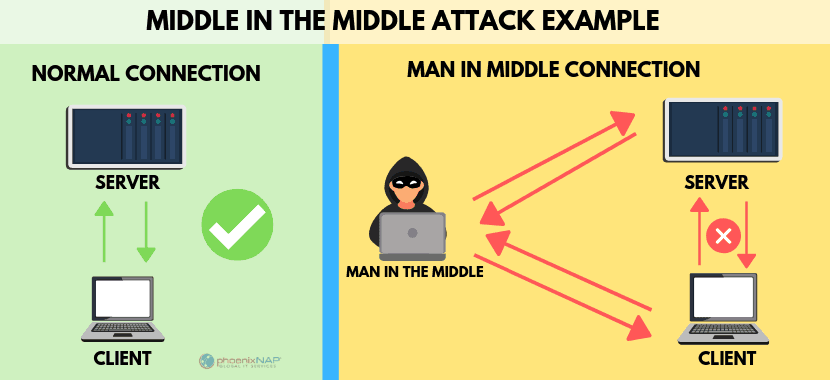
Man in the Middle Attack Prevention
Use a Virtual Private Network (VPN) to encrypt your web traffic. An encrypted VPN severely limits a hacker’s ability to read or modify web traffic.
Be prepared to prevent data loss; have a cyber security incident response plan.
Network Security
Secure your network with an intrusion detection system. Network administrators should be using good network hygiene to mitigate a man-in-the-middle attack.
Analyze traffic patterns to identify unusual behavior.
Your network should have strong firewalls and protocols to prevent unauthorized access.
Use third-party penetration testing tools, software, and HTTPS encryption to help detect and block spoofing attempts.
Install active virus and malware protection that includes a scanner that runs on your system at boot.
MITM attacks often rely on malware. Running updated anti-virus software is imperative.
Secure Your Communications
Encryption is the best defense to protect against intercepted communication.
The most effective method to stop email hijacking is to enable two-factor authentication. That means that, in addition to your password, you have to provide another vector of authentication. One example is Gmail’s combination of a password and a text to your smartphone.
Use basic internet security hygiene on all devices, including mobile applications.
Watch out for phishing emails as they are the most common attack vector. Carefully examine links before clicking.
Only install browser plug-ins from reputable sources.
Minimize the potential of attacks by signing out unused accounts to invalidate session cookies.
Force encryption by typing https at the beginning:https://www.website.com
If you expect an encrypted connection but don’t have one, stop what you’re doing and run a security scan.
If you use Google Chrome, install a chrome security extension, like HTTPS Everywhere, which forces an SSL connection whenever possible.
You should see a green or gray padlock just to the left of the web address in your browser. If you ever see a red padlock, that means there is something wrong with the encryption — double check domain names and your browser before visiting an insecure site.
Disable “Punycode support” (for rendering characters from different languages) on your browser.
Add an enterprise password management solution; this will avoid auto-filling passwords on a nefarious site.
Remember, mobile security best practices. Mobile applications are often targeted.
Avoid using public wifi networks. If you must use public wi-fi, configure your device to require a manual connection.
MITM attacks can be difficult to detect while they are occuring. The best way to stay safe is consistantly implementing all the prevention best practices above.
Be aware that some attacks are a form of social engineering. If something doesn’t seem right about a website or email, take a few minutes to dig a little deeper.
Protect your organization from falling victim
Detecting an attack is difficult, but they can be prevented.
Many Man In TheMiddle attacks can be prevented with good network hygiene, such as firewalls and security protocols. It is important to supplement these efforts by being mindful of your network habits.
Learn how PhoenixNAP proactively manages, detects, and responds to security indicators with our Threat Management Intelligence Services.
Recent Posts
What is SQL Injection? How to Prevent & Identify an Attack
An SQL Injection – or SQLI is a type of cyber security attack that targets application security weakness and allows attackers to gain control of an application’s database. An attacker inputs a malicious input into an SQL statement., and the SQL server reads it as programming code.
Some SQLI attacks can release lists of sensitive customer data while others delete part (or all) of a database. And some can even remotely run software applications.
SQL Injection attacks are relatively easy and commonplace. Preventing and detecting SQLI attacks is a necessary aspect of security diligence.
How To Prevent SQL Injection
Most experts agree that the best solution is to prevent intrusions before they happen. This can be done by upgrading security combined with vulnerability scanning and penetration testing. Consider using a third party service to check your website for known weaknesses.
Sanitize Input
Also known as validation; this checks the input before it’s executed. This is sort of like putting a bouncer at the front door. An additionally hidden program checks to make sure the input doesn’t contain any SQL executables. The best practice in this solution is to use a whitelist for approved input. Using a whitelist is simpler and more secure than blacklisting unauthorized code.
Parameterized SQL Code
This creates a sort of storage area (a parameter, or a prepared statement) that holds the user input. If an input doesn’t match the type for the parameter, it’s ignored. This technique prevents direct access between a user and the database. Since the user cannot issue commands directly, they cannot inject malicious SQL code.
Use Object-Relational Mapping
ORM libraries are tools for translating between programming languages. This may take help from developers, but it creates a system of virtual objects that run specific SQL queries. Like the previous step, this removes the ability of users to query the SQL server directly.
Limit User Permissions
This is a best practice in all IT and server administration. It holds especially true to preventing SQLI attacks. Simply limit users to the bare minimum permissions they require — the fewer accounts with read-write-execute permissions, the fewer opportunities for exploitation.
Third-Party Security Software
Web Application Firewall software can screen SQL inputs. There are many third-party security tools available. If you don’t have programming skills (or a developer team), consider using software to screen SQL inputs.
How to Detect SQL Injection Attacks
SQLI attacks often look like standard database errors. Without special tools, they can be difficult to detect in real time. An SQLI attack usually involves trial and error. Sometimes, a worm (or bot) repeatedly probes your website for flaws. Sometimes a human hacker enters SQL codes into your website. These attacks don’t always require a login, making detection much more difficult.
Detecting an SQLI attack while it’s in progress requires additional configuration or third-party tools. One method is to examine sqlserver.error_reported event for specific errors. Frequent failed login and bad syntax errors might indicate repeated intrusion attempts. Alternately, the database can be searched for common HTML tags, such as “iframe” or “http-equiv=”refresh.”
A second method to identify an SQLI attack involves traffic analysis. This requires a third party monitoring tool. Over time, the monitor will establish a baseline of standard behavior. If there’s a suspicious change, like changes in permissions, the monitor can trigger an alert.
Auditing software can help after a breach. These tools examine error logs looking for damage that was done. This data can be used to improve security and prevent the next attack.
Typically, these tools monitor:
- Repeated failed logins – These can indicate trial-and-error to bypass SQL security.
- Password changes – Unexpected password changes might indicate a hacker gained access to a user.
- Permission and Ownership changes – Files modified in this way can be evidence that a hacker made the changes to grant themselves access.
- Logins, Logouts, Database operations – While not inherently a sign of intrusion, unusual or unexpected account activity can indicate a breach.
How SQL an Injection Attack Works?
To understand an SQLI attack, it’s helpful to understand an SQL query.
There are two layers to an SQL query on a webpage. The first is user input, like a username and password field. The second is where the hidden programming code creates a SQL query against the database.
A SQL injection attack is when an attacker puts SQL code in a box designed for regular input. This fools an unprotected system into running the string of characters as a programming code.
A simple example works like this:
An attacker decides to attack a SQL server. The server has a prompt for a username and password:
Enter Username: username
Enter Password: password
The server has a database with a table of usernames and passwords. When a user enters their information, the server compares them against the table of usernames and passwords. If the server finds a match for both, the user is granted access.
The hidden program translates the user’s input into a query. A SQL query asks the database for a specific set of information.
A hidden SQL query might look like this:
SELECT UserList.Username
FROM UserList
WHERE UserList.Username = ‘username’
AND UserList.Password = ‘password’
The SQL server is running a query on the UserList table in the database. It’s looking for an entry that matches the ‘username’ input that was entered by the user. But that’s not enough – the database entry also has to contain the ‘password’ input from the user. If both match, the database returns a TRUE result, and the user gains access.
With an SQLI attack, the SQL query can be hacked.
An attacker might enter the following:
Username: username
Enter Password: password’ OR ‘1’=’1
This injects a piece of code into the query. Now, the hidden program creates a database query like this:
SELECT UserList.Username
FROM UserList
WHERE UserList.Username = ‘username’
AND UserList.Password = ‘password’ OR ‘1’=’1’
Note how the last line changed. The contents of the Enter Password field were added to the query. The SQL database reads this as executable code. Now, it’s being asked to check the database whether the number 1is equal to the number 1. It doesn’t matter if the username and password are correct. The formula “1=1” is true, so the database returns a TRUE result, and the user is granted access.
SQL Injection Example
One popular command can be used to delete entire tables from a database:
Enter Username: ‘;DROP TABLE User; ––‘
Enter Password: ‘OR”=’
Once the command is turned into a query, it looks like this:
SELECT UserList.Username
FROM UserList
WHERE UserList.Username = ‘ ‘; DROP TABLE User; ––‘AND Pwd = ‘ ‘ OR”=’
The attacker has injected a piece of code that executes DROP TABLE against the UserList table. Then, the rest of the line is marked as a comment, so it doesn’t run. This would delete the whole UserList table from your database.
SQLI attacks can also be used to run multiple commands. The UNION command can be used to run more than one SELECT:
Enter Username: username
Enter Password: password UNION SELECT Username, Password FROM UserList;
The hidden program would query the database as follows:
SELECT UserList.Username
FROM UserList
WHERE UserList.Username = ‘username’
AND UserList.Password = ‘password’ UNION SELECT Username, Password FROM UserList;
This would return a list of all the usernames and passwords from the table UserList.
This type of attack can wreak havoc.
It can result in data breaches if unauthorized users gain access to user data. It can be used to destroy whole portions of your database. It can even be used to launch and execute malicious software on your server.
SQL Injection Prevention Starts With Being Prepared
SQL Injection attacks don’t require a lot of skill to cause massive damage. Anyone with a computer can look up a SQL exploit and run it against your server, making it a tempting attack vector. Fortunately, they are relatively simple to defend against.
Locking down your SQL server to prevent injection attacks is an important step. It’s a lot easier to prevent an attack than to restore from backup. (Or to notify a client list of a security breach.) Take a moment to evaluate your SQL code.
The Open Web Application Security Project (OWASP) maintains an excellent list of resources and cheat sheets for protecting your SQL servers.
Schedule a security audit. Then sit down with your development team to implement SQLI protection on production servers.
Recent Posts
Upgrade Your Security Incident Response Plan (CSIRP) : 7 Step Checklist
In this article you will learn:
- Why every organization needs a cybersecurity incident response policy for business continuity.
- The Seven critical security incident response steps (in a checklist) to mitigate data loss.
- What should be included in the planning process to ensure business operations are not interrupted?
- Identify which incidents require attention & When to initiate your response.
- How to use threat intelligence to avoid future incidents.
What if your company’s network was hacked today? The business impact could be massive.
Are you prepared to respond to a data security breach or cybersecurity attack? In 2020, it is far more likely than not that you will go through a security event.
If you have data, you are at risk for cyber threats. Cybercriminals are continually developing new strategies to breach systems. Proper planning is a must. Preparation for these events can decrease the damage and loss you and your stakeholder’s.
Having a clear, specific, and current cybersecurity incident response plan is no longer optional.
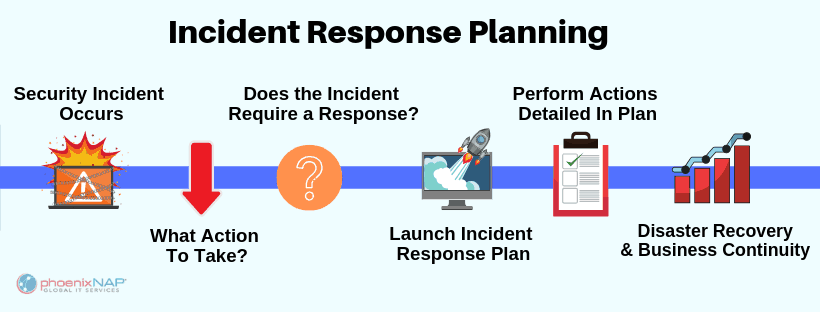
What is an Incident Response Plan?
An incident response (IR) plan is the guide for how your organization will react in the event of a security breach.
Incident response is a well-planned approach to addressing and managing reaction after a cyber attack or network security breach. The goal is to minimize damage, reduce disaster recovery time, and mitigate breach-related expenses.
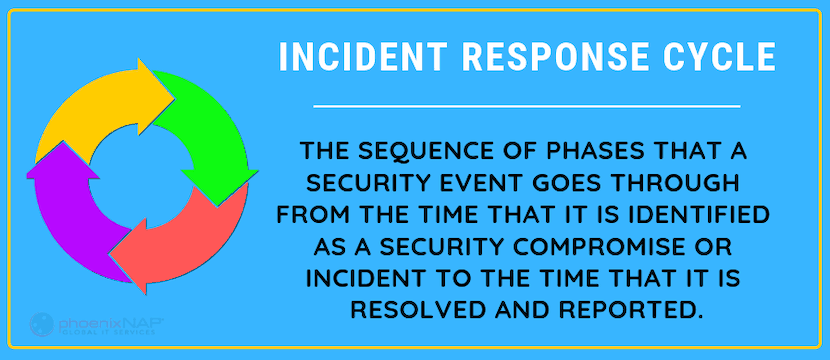
Cybersecurity Incident Response Checklist, in 7 Steps
During a breach, your team won’t have time to interpret a lengthy or tedious action plan.
Keep it simple; keep it specific.
Checklists are a great way to capture the information you need while staying compact, manageable, and distributable. Our checklist is based on the 7 phases of incident response process which are broken down in the infographic below.
Share this Image On Your Site, Copy & Paste
1. Focus Response Efforts with a Risk Assessment
If you haven’t done a potential incident risk assessment, now is the time. The primary purpose of any risk assessment is to identify likelihood vs. severity of risks in critical areas. If you’ve done a cybersecurity risk assessment, make sure it is current and applicable to your systems today. If It’s out-of-date, perform another evaluation.
Examples of a high-severity risk are a security breach of a privileged account with access to sensitive data. This is especially the case if the number of affected users is high. If the likelihood of this risk is high, then it demands specific contingency planning in your IR plan. The Department of Homeland Security provides an excellent Cyber Incident Scoring System to help you assess risk.
Use your risk assessment to identify and prioritize severe, likely risks. Plan appropriately for medium and low-risk items as well. Doing this will help you avoid focusing all your energy on doomsday scenarios. Remember, a “medium-risk” breach could still be crippling.
2. Identify Key Team Members and Stakeholders
Identify key individuals in your plan now, both internal and external to your CSIRT. Name your stakeholders and those with decision-making authority. This could include senior management, customers, and business partners.
Document the roles and responsibilities of each key person or group. Train them to perform these functions. People may be responsible for sending out a PR statement, activating procedures to contact authorities, or performing containment activities to minimize damage from the breach.
Store multiple forms of contact information both online and offline. Plan to have a variety of contact methods available (don’t rely exclusively on email) in case of system interruptions.
3. Define Incident Types and Thresholds
You need to know exactly when to initiate your IT security incident response. Your response plan should define what counts as an incident and who is in charge of activating the plan.
Know the kinds of cybersecurity attacks that can occur — stay-up-to-date on the latest trends and new types of data breaches that are happening.
Defining potential security incidents can save critical time in the early stages of breach detection. The stronger your CSIRT’s working knowledge of incident types and what they look like, the faster you can invoke a targeted active response.
Educate those outside your CSIRT, including stakeholders. They should also be familiar with these incident definitions and thresholds. Establish a clear communication plan to share information amongst your CSIRT and other key individuals to convey this information.
4. Inventory Your Resources and Assets
IR response depends on coordinated action across many departments and groups. You have different systems and resources available, so make the most of all of your departments and response teams.
Create a list of these assets, which can include:
- Business Resources: Team members, security operations center departments, and business partners are all businesses resources. These should consist of your legal team, IT, HR, a security partner, or the local authorities.
- Process Resources: A key consideration is to evaluate the processes you can activate depending on the type and severity of a security breach. Partial containment, “watch and wait” strategies, and system shutdowns like web page deactivation are all resources to include in your IR plan.
Once you have inventoried your assets, define how you would use them in a variety of incident types. With careful security risk management of these resources, you can minimize affected systems and potential losses.
5. Recovery Plan Hierarchies and Information Flow
Take a look at your assets above.
What are the steps that need to happen to execute different processes? Who is the incident response manager? Who is the contact for your security partner?
Design a flowchart of authority to define how to get from Point A to Point B. Who has the power to shut down your website for the short term? What steps need to happen to get there?
Flowcharts are an excellent resource for planning the flow of information. NIST has some helpful tools explaining how to disseminate information accurately at a moment’s notice. Be aware that this kind of communication map can change frequently. Make special plans to update these flowcharts after a department restructure or other major transition. You may need to do this outside your typical review process.
6. Prepare Public Statements
Security events can seriously affect an organizations reputation. Curbing some of the adverse effects around these breaches has a lot to do with public perception. How you interface with the public about a potential incident matters.
Some of the best practices recognized by the IAPP include:
- Use press releases to get your message out.
- Describe how (and with whom) you are solving the problem and what corrective action has been taken.
- Explain that you will publish updates on the root cause as soon as possible.
- Use caution when talking about actual numbers or totalities such as “the issue is completely resolved.”
- Be consistent in your messaging
- Be open to conversations after the incident in formats like Q&A’s or blog posts
Plan a variety of PR statements ahead of time. You may need to send an email to potentially compromised users. You may need to communicate with media outlets. You should have statement templates prepared if you need to provide the public with information about a breach.
How much is too much information? This is an important question to ask as you design your prepared PR statements. For these statements, timing is key – balance fact-checking and accuracy against timeliness.
Your customers are going to want answers fast, but don’t let that rush you into publishing incorrect info. Publicizing wrong numbers of affected clients or the types of data compromised will hurt your reputation. It’s much better to publish metrics you’re sure about than to mop up the mess from a false statement later.
7. Prepare an Incident Event Log
During and after a cybersecurity incident, you are going to need to track and review multiple pieces of information. How, when, and where the breach was discovered and addressed? These details and all supporting info will go into an event log. Prepare a template ahead of time, so it is easy to complete.
This log should include:
- Location, time, and nature of the incident discovery
- Communications details (who, what, and when)
- Any relevant data from your security reporting software and event logs
After an information security incident, this log will be critical. A thorough and effective incident review is impossible without a detailed event log. Security analysts will lean on this log to review the efficacy of your response and lessons learned. This account will also support your legal team and law enforcement both during and after threat detection.
How Often Should You Review Your Incident Response Procedures?
To review the steps in your cybersecurity incident response checklist, you need to test it. Run potential scenarios based on your initial risk assessment and updated security policy.
Perhaps you are in a multi-user environment prone to phishing attacks. Your testing agenda will look different than if you are a significant target for a DDoS attack. At a minimum, annual testing is suggested. But your business may need to conduct these exercises more frequently.
Planning Starts Now For Effective Cyber Security Incident Response
If you don’t have a Computer Security Incident Response Team (CSIRT) yet, it’s time to make one. The CSIRT will be the primary driver for your cybersecurity incident response plan. Critical players should include members of your executive team, human resources, legal, public relations, and IT.
Your plan should be a clear, actionable document that your team can tackle in a variety of scenarios, whether it’s a small containment event or a full-scale front-facing site interruption.
Protecting your organization from cybersecurity attacks is a shared process.
Partnering with the experts in today’s security landscape can make all the difference between a controlled response and tragic loss. Contact PhoenixNAP today to learn more about our global security solutions.
Recent Posts
What Is Penetration Testing? Types and Techniques
Security should be a multi-layered approach. One of those critical layers is Penetration Testing.
Is your data safe in today’s rapidly changing world of cybersecurity attacks?
The best way to find out if application systems are secure is to attempt to hack them yourself. A tried and tested method is a penetration test, a form of application scanning. Vulnerability detection aims to identify potential weakness before the bad guys do
In this article, we will discuss what pen testing is, different types, and how your organization can benefit from it.
What is Penetration Testing? A Definition
By definition, penetration testing is a method for testing a web application, network, or computer system to identify security vulnerabilities that could be exploited. The primary objective for security as a whole is to prevent unauthorized parties from accessing, changing, or exploiting a network or system. It aims to do what a bad actor would do.
Consider a Pen Test an authorized simulation of a real-world attack on a system, application, or network to evaluate the security of the system. The goal is to figure out whether a target is susceptible to an attack. Testing can determine if the current defense systems are sufficient, and if not, which defenses were defeated.
These tests are designed to target either known vulnerabilities or common patterns which occur across applications — finding not only software defects but also weaknesses in network configurations.
Why Security Penetration Testing is Important
A pen-test attempts to break a security system. If a system has sufficient defenses, alarms will be triggered during the test. If not, the system is considered compromised. Penetration testing tools are used to monitor and improve information security programs.
Though system administrators need to know the difference between a test and an actual threat, it’s important to treat each inspection as a real-world situation. Though unlikely, credible security threats could occur during the test.
Penetration tests are often creative rather than systematic. For example, instead of a brute force attack of a network, a pen-test could be designed to infiltrate a company executive via his/her e-mail. Approaching the problem creatively as an infiltrator is more realistic with what could potentially be a real attack someday.
Once a test is complete, the InfoSec team(s) need to perform detailed triage to eliminate vulnerabilities or defer action where a weakness poses little or no threat.
Typically, penetration testers are external contractors hired by organizations. Many organizations also offer bounty programs. They invite freelance testers to hack their external-facing systems, such as public websites, in a controlled environment with the promise of a fee (or other forms of compensation) to breach an organization’s computer systems.
There is a good reason why organizations prefer to hire external security professionals. Those who do not know how an application was developed may have a better chance of discovering bugs the original developers may never have considered or maybe blind toward.
Penetration testers come from a variety of backgrounds. Sometimes these backgrounds are similar to those of software developers. They can have various forms of computer degrees (including advanced ones), and they can also have specialized training in penetration security testing. Other penetration testers have no relevant formal education, but they have become adept at discovering security vulnerabilities in computer software. Still, other penetration testers were once criminal hackers, who are now using their advanced skills to help organizations instead of hurting them.

Steps of Penetration Testing
Reconnaissance and Intelligence Gathering
Before explaining the different methods for a penetration test, it’s necessary to understand the process of gathering intelligence from systems and networks.
Intelligence gathering, or Open Source Intelligence (OSINT) gathering, is a crucial skill for testers. During this initial phase, ethical hackers or cybersecurity personnel learn how the environment of a system functions, gathering as much information as possible about the system before beginning.
This phase will usually uncover surface-level vulnerabilities.
It includes a scan of:
- The local and wireless network
- Pertinent applications
- Website
- Cloud-based systems
- Employees
- Physical hardware facilities
Threat Modeling
After gathering intelligence, cybersecurity professionals move on to threat modeling.
Threat modeling is a structured representation of the information that affects system security. Security teams use this type of model to treat every application or feature as if it were a direct safety.
Threat modeling captures, organizes, and analyzes the bulk of intelligence gathered in the previous preparation phase for a penetration test. It then makes informed decisions about cybersecurity while prioritizing a comprehensive list of security improvements, including concepts, requirements, design, and rapid implementation.
Threat modeling is a process of its own, and can be summed up by asking the following four questions:
- What are we working on?
- What can go wrong with what we’re working on?
- What can we do to ensure that doesn’t happen?
- Did we completely eradicate the problem?
There is no single, right way to investigate vulnerabilities in a system. But combinations of these questions can go a long way toward finding solutions.
Cybersecurity professionals define and identify vulnerability assessment scope, threat agents, existing countermeasures, exploitable vulnerabilities, prioritized risks, and possible countermeasures during threat modeling.

Types of Penetration Testing
Following intelligence gathering and threat modeling, a penetration test itself is the next process.
Below are various penetration testing methodologies. It’s important to test for as many potential weaknesses throughout your system and network as possible.
Conducting multiple tests can reveal more vulnerabilities and provide your security and IT teams with more opportunities to address and eliminate security threats.
Network Penetration Testing & Exploitation
This type of test includes both internal and external network exploitation testing through the emulation of hacker techniques that penetrate a system’s network defenses. Once the network has been compromised, the tester can potentially gain access to the internal security credentials of an organization and its operation.
Testing of a network includes identifying:
- Threat Modeling
- Vulnerability Scanning & Analysis
- Firewall bypassing
- Router and proxy server testing
- IPS and DPS evasion
- Open port scanning
- SSH security attacks
Network testing is more in-depth than standard penetration testing and locates vulnerabilities that basic scans may not find, all to create a safer overall network.
Web Application Security Tests
Application security tests search for server-side application vulnerabilities. The penetration test is designed to evaluate the potential risks associated with these vulnerabilities through web applications, web services, mobile applications, and secure code review.
The most commonly reviewed applications are web apps, languages, APIs, connections, frameworks, systems, and mobile apps.
Client Side or Website & Wireless Network
Wireless and website tests inspect relevant devices and infrastructures for vulnerabilities that may compromise and exploit the wireless network.
Recently, Mathy Vanhoef, a security expert at the Belgian University KU Leuven, determined that all WiFi networks are vulnerable to hacking through their WPA2 protocols.
This exploit can reveal all encrypted information, including credit card numbers, passwords, chat messages, emails, and images. Injection and manipulation of data are also possible, leading to the potential for ransomware or malware attacks that could threaten the entire system.
To prevent wireless network hacking, check for the following during pen testing:
- webserver misconfiguration including the use of default passwords
- malware and DDoS attacks
- SQL injections
- MAC address spoofing
- media player or content creation software testing vulnerabilities
- cross-site scripting
- unauthorized hotspots and access points
- wireless network traffic
- encryption protocols
Social Engineering Attacks
Social engineering tests search for vulnerabilities an organization could be exposed to based on its employees directly. In this case, creative testing must be designed to mimic real-world situations that employees could run into without realizing they’re being exploited.
These tests not only help with internal security strategy amongst co-workers but allow security teams to determine necessary next steps in cybersecurity.
Specific topics such as eavesdropping, tailgating, or phishing attacks; posing as employees; posing as vendors/contractors; name-dropping or pretexting; gifts or dumpster diving; bluesnarfing; quid pro quo; or baiting, are common testing practices.
Bad actors typically possess social engineering skills and can influence employees to create access to systems or sensitive customer data. When used in conjunction with other physical tests, social engineering testing can help to develop a culture of security throughout an organization.
Physical Testing
Physical penetration testing prevents hackers from gaining tangible access to systems and servers by ensuring that facilities are impenetrable by unauthorized personnel. IT and cybersecurity professionals focus primarily on system vulnerabilities and may overlook physical security aspects that can result in exploitation. Physical penetration tests focus on attempts to access facilities and hardware through RFID systems, door entry systems and keypads, employee or vendor impersonation, and evasion of motion and light sensors.
Physical tests are used in combination with social engineering such as manipulation and deceit of facility employees to gain system access.
Computer Network Exploitation (CNE) & Computer Network Attacks (CNAs)
In a Computer Network Exploitation (CNE), networks can be used to target other systems directly.
For example, attempting to extract and obtain sensitive information and data such as classified intelligence or government documents. This type of attack is commonly performed within government agencies and military organizations and is considered surveillance, wiretapping, or even cyber-terrorism.
In a Computer Network Attacks (CNAs), the goal is to destroy or corrupt information that exists on a victim’s network through an Electronic Attack (EA). EA’s can use techniques such as an electromagnetic pulse (EMP) designed to incapacitate a network or system.
Types of CNAs can overlap with social engineering and include data modification and IP address spoofing; password-based attacks; DDOS; Man in the middle attacks; or compromised key, sniffer, and application layer attacks.
Cloud Pen Testing
Cloud services are essential for group collaboration, networking, and storage. Large amounts of data are stored within the cloud, which means that it is a hotbed for hackers seeking to exploit this technology.
Cloud deployment is relatively simple. However, cloud providers often have a shared or hands-off approach to cybersecurity, and organizations are responsible for vulnerabilities testing or hacking prevention themselves.
Cloud penetration testing is a complicated test, but one that is necessary and important.
Typical cloud testing areas include:
- Weak passwords
- Network Firewalls
- RDP and SSH remote administration
- Applications and encryption
- API, database, and storage access; VMs; and unpatched operating systems.
Public cloud penetration testing can be among the most complicated to perform.
Utilize a “white box” method of testing by making use of as much information as possible about the target system. This includes the software it runs, and the network architecture, source code.
This will ensure you have the intelligence to accomplish the test. Be aware that public cloud services providers limit your penetration testing abilities due to the resource limitations of shared infrastructures.
For instance, Amazon Web Services (AWS) requires that you fill out the AWS Vulnerability Testing Request Form before testing and forbids certain types of pen tests.
Microsoft Azure lists its Microsoft Cloud Unified Penetration Testing Rules of Engagement on its website.
On-premises subscribers and cybersecurity personnel can scan applications, data, runtime, operating system, virtualization, servers, storage, and networking.
In the cloud, they can test applications, data, runtime, and operating systems for IaaS; applications and data only for PaaS; and no subscriber testing for SaaS.
Assess Your Security With Pen Testing Before a Hacker Does
Cybersecurity is a concern for all businesses. Constant threats to IT systems and networks are non-stop. Identifying weaknesses thru testing can prevent unauthorized parties from accessing data. Ensure that your applications and network systems have an evolving multi-stage security approach.
Designing tests that simulate attacks on hardware, software, networks, and even your employees, you can quickly determine the weaknesses.
Recent Posts
What is Spear Phishing? Learn How to Prevent Attacks
The latest numbers are in, and they aren’t pretty. In 2018, over 90% of cyber attacks and their resulting breaches stemmed from a spear phishing email.
According to SANS Institute’s Allen Paller, spear phishing emails caused 95% of all attacks on enterprise networks. So what is it that makes phishing emails in general and spear phishing emails in specific so dangerous? And how can individuals and enterprises protect themselves against such an invasive tactic?
The following article details what spear phishing attacks are and how to prevent them.
A Definition of Spear Phishing
Spear phishing is a much more targeted type of phishing attack. Here, the perpetrator doesn’t just send out a stock email to thousands or tens of thousands of recipients. Instead, they send out a personalized email to each of their targets. That email is sent out only after the perpetrator has done their research and knows specific details about their victim that will encourage the target to act. Those key details enable the perpetrator to draft the email in such a way as to instill trust in their victim and encourage them to do something that they might not otherwise do.
Spear phishing attacks usually appeal either to human greed or fear. This means they will either offer targets money, discounts, bargains, etc. or threaten targets into acting by saying their checking, PayPal, or eBay account has been frozen.
To encourage their victim to act, the perpetrator of a spear phishing attack will first find their victim and collect critical details to ensure whichever tactic will be believable. For example, they might search out an individual’s profile on a social networking site and from there glean their target’s email address, geographic location, workplace, friends list, and any new big items recently purchased and from where. Such details alone might seem innocuous but together enable the perpetrator to craft a dangerously effective email.
In their spear phishing email, the perpetrator will use the information to pose as a friend, colleague, boss, or other familiar entity to send out a highly convincing but ultimately fraudulent message. Hackers also employ a blend of email spoofing, and dynamic URLs to make emails appear more convincing.
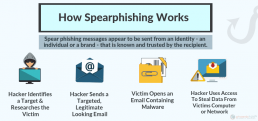
91% of cyberattacks and the resulting data breach begin with a “spear phishing” email, according to research from security software firm Trend Micro.
How Spear Phishing Works
Phishing schemes are any cyber or phone-based schemes designed to trick a victim into giving up personal details.
That information is then later used in some sort of scam. It’s a common hack, and most phishing scheme perpetrators target thousands of people with the goal of fooling a few. Take for example the famous “Nigerian Prince” scam. In this phishing scam, thousands of people receive emails offering a large sum of money on the condition the recipient transfers money for them. Most people will delete the email, but every year there continues to be those who don’t. Those victims who fall prey can lose thousands or even tens of thousands of dollars to the scam.
However, because more people have become aware of such scams and because business IT groups and email servers have tightened up security, the phishers have become more specialized. This is where the hacking technique of spear phishing developed.
Examples of Spear Phishing
Examples and scenarios for how spear phishing works and what it looks like include:
Spear Phishing An Individual: The perpetrator discovers the bank their target uses and using a spoofed email and copied website credentials, sends the target an email stating the account has been breached. That email will use fear-mongering to get the target to call a number or follow a link to provide confidential banking information (such as username and password) to confirm they are the real account holder. The perpetrator will then use that information to siphon out money.
Spear Phishing a business: A spear phishing attack against a company is similar to the one against an individual in that the perpetrator will first research and then use that research to draft a legitimate-looking scam. But the difference is the scale. Networking firm Ubiquiti Networks Inc. learned this the hard when cyber thieves uncovered key details about firm executives. The thieves then used those details to create spoof communications that appeared as though they were the firm executives and directed the firm’s finance department to initiate unauthorized international wire transfers to the tune of $46.7 million.
5 Protection Tactics To Avoid Spear Phishing Attacks
Spear phishing attacks look legitimate but are very dangerous. The following are a few tips both individuals and businesses can use to help prevent perpetrators of such attacks both from harvesting key data and using the data to get hold of critical accounts:
1. Avoid posting personal information online, such as a personal phone number. Every individual should avoid ever posting their phone number on their social media platform and avoid inputting their phone number with an unknown (and even most known) websites and mobile applications. Phone numbers are just as key to identifying a person and their complete financial background as a social security number. With techniques like SIM swapping and phishing scams, a person can essentially take over all of a person’s financial accounts.
2. Never click an unknown email link or attachment, especially from a financial or business institution. Use email security best practices. Perpetrators of spear phishing attacks will commonly send emails posing as a trusted institution their victim is known to frequent, such as Bank of America, Amazon, and eBay. Any emails an individual receives via personal business email should not be wholly trusted. Never click a link from such an organization, instead launch a separate browser window and go directly to the institution’s website to investigate claims and conduct business as usual. Any other emails, from friends, favorite blog writers, or nonprofit organizations, should be considered with care. Check the anchor text and never input personal details or otherwise confidential information on a link clicked from an email.
3. Be careful over-sharing on social media. Be mindful of personal details on their social media profiles and who they allow access to it. Keep privacy configurations high and avoid accepting unknown friend requests.
4. All organizations should implement a wholescale data protection program. Data protection programs are a combination of user education and security awareness training on best digital security practices and the implementation of a wholesale cyber protection solution designed to prevent potential data loss due to cyber attacks like spear phishing.
5. Keep confidential information out of emails. A favorite spear phishing tactic is to email employees from a reputable looking address and request sensitive information such as passwords or business banking details.ion.
Stay Alert & Stay Safe
No person and no organization is immune to becoming a target of cyber thieves.
If your information is on the internet or your smartphone has applications downloaded, then you are a potential target for this and other sophisticated cyber attacks. The best way to prevent falling victim is to stay aware at all time.
Keep information confidential, never trust outside sources and contact an experienced and professional security solutions team to ensure business assets are likewise protected.
Recent Posts
15 DevOps Metrics & KPIs That Enterprises Should Be Tracking
DevOps first made its mark as an option for streamlining software delivery. Today, DevOps is widely regarded as an essential component of the delivery process. Key DevOps processes are involved in everything from securing to maintaining applications.
DevOps practices and principles alone won’t ensure quality and could even cause more issues if not integrated correctly. In the effort to deliver software to the market as quickly as possible, companies risk more defects caught by the end-user.
The modern era of end-to-end DevOps calls for the careful integration of key performance indicators (KPIs). The right metrics can ensure that applications reach their peak potential.
Ideally, DevOps Metrics and KPI’s present relevant information in a way that is clear and easy to understand. Together, they should provide an overview of the deployment and change process — and where improvements can be made.
The following metrics are worth tracking as you strive to improve both efficiency and user experience.
DevOps Metrics and Key Performance Indicators
1. Deployment Frequency
Deployment frequency denotes how often new features or capabilities are launched. Frequency can be measured on a daily or weekly basis. Many organizations prefer to track deployments daily, especially as they improve efficiency.
Ideally, frequency metrics will either remain stable over time or see slight and steady increases. Any sudden decrease in deployment frequency could indicate bottlenecks within the existing workflow.
More deployments are typically better, but only up to a point. If high frequency results in increased deployment time or a higher failure rate, it may be worth holding off on deployment increases until existing issues can be resolved.
2. Change Volume
Deployment frequency means little if the majority of deployments are of little consequence.
The actual value of deployments may be better reflected by change volume. This DevOps KPI determines the extent to which code is changed versus remaining static. Improvements in deployment frequency should not have a significant impact on change volume.
3. Deployment Time
How long does it take to roll out deployments once they’ve been approved?
Naturally, deployments can occur with greater frequency if they’re quick to implement. Dramatic increases in deployment time warrant further investigation, especially if they are accompanied by reduced deployment volume. While short deployment time is essential, it shouldn’t come at the cost of accuracy. Increased error rates may suggest that deployments occur too quickly.
4. Failed Deployment Rate
Sometimes referred to as the mean time to failure, this metric determines how often deployments prompt outages or other issues.
This number should be as low as possible. The failed deployment rate is often referenced alongside the change volume. A low change volume alongside an increasing failed deployment rate may suggest dysfunction somewhere in the workflow.
5. Change Failure Rate
The change failure rate refers to the extent to which releases lead to unexpected outages or other unplanned failures. A low change failure rate suggests that deployments occur quickly and regularly. Conversely, a high change failure rate suggests poor application stability, which can lead to negative end-user outcomes.
6. Time to Detection
A low change failure rate doesn’t always indicate that all is well with your application.
While the ideal solution is to minimize or even eradicate failed changes, it’s essential to catch failures quickly if they do occur. Time to detection KPIs can determine whether current response efforts are adequate. High time to detection could prompt bottlenecks capable of interrupting the entire workflow.
7. Mean Time to Recovery
Once failed deployments or changes are detected, how long does it take actually to address the problem and get back on track?
Mean time to recovery (MTTR) is an essential metric that indicates your ability to respond appropriately to identified issues. Prompt detection means little if it’s not followed by an equally rapid recovery effort. MTTR is one of the best known and commonly cited DevOps key performance indicator metrics.
8. Lead Time
Lead time measures how long it takes for a change to occur.
This metric may be tracked beginning with idea initiation and continuing through deployment and production. Lead time offers valuable insight into the efficiency of the entire development process. It also indicates the current ability to meet the user base’s evolving demands. Long lead times suggest harmful bottlenecks, while short lead times indicate that feedback is addressed promptly.
9. Defect Escape Rate
Every software deployment runs the risk of sparking new defects. These might not be discovered until acceptance testing is completed. Worse yet, they could be found by the end user.
Errors are a natural part of the development process and should be planned for accordingly. The defect escape rate reflects this reality by acknowledging that issues will arise and that they should be discovered as early as possible.
The defect escape rate tracks how often defects are uncovered in pre-production versus during the production process. This figure can provide a valuable gauge of the overarching quality of software releases.
10. Defect Volume
This metric relates to the escape rate highlighted above, but instead focuses on the actual volume of defects. While some defects are to be expected, sudden increases should spark concern. A high volume of defects for a particular application may indicate issues with development or test data management.
11. Availability
Availability highlights the extent of downtime for a given application.
This can be measured as complete (read/write) or partial (read-only) availability. Less downtime is nearly always better. That being said, some lapses in availability may be required for scheduled maintenance. Track both planned downtime and unplanned outages closely, keeping in mind that 100 percent availability might not be realistic.
12. Service Level Agreement Compliance
To increase transparency, most companies operate according to service level agreements. These highlight commitments between providers and clients. SLA compliance KPIs provide the necessary accountability to ensure that SLAs or other expectations are met.
13. Unplanned Work
How much time is dedicated to unexpected efforts? The unplanned work rate (UWR) tracks this in relation to time spent on planned work. Ideally, the unplanned work rate (UWR) will not exceed 25 percent.
A high UWR may reveal efforts wasted on unexpected errors that were likely not detected early in the workflow. The UWR is sometimes examined alongside the rework rate (RWR), which relates to the effort to address issues brought up in tickets.
14. Customer Ticket Volume
As the defect escape rate KPI suggests, not all defects are disastrous. Ideally, however, they will be caught early. This concept is best reflected in customer ticket volume, which indicates how many alerts end users generate. Stable user volume alongside increased ticket volume suggests issues in production or testing.
15. Cycle Time
Cycle time metrics provide a broad overview of application deployment.
This KPI tracks the entirety of the process, beginning with ideation and ending with user feedback. Shorter cycles are generally preferable, but not at the expense of discovering defects or abiding by SLAs.
Start Measuring Devops Success
When tracking key DevOps metrics, focus less on the perceived success or failure according to any one indicator, but rather, on the story these metrics tell when examined together. A result that seems problematic on its own could look completely different when analyzed alongside additional data.
Careful tracking of the KPIs highlighted above can ensure not only greater efficiency in development and production, but more importantly, the best possible end-user experience. Embrace DevOps metrics, and you could see vast improvements in application deployment and feedback.
Recent Posts
17 Types of Cyber Attacks To Secure Your Company From in 2020
In this article you will learn:
- What a Cyber Security Attack looks like in 2020 and how to identify one.
- An attack could destroy your business overnight, a proper security defense requires understanding the offense.
- How to protect your organization from the most common cyber attack vectors. Different methods require different prevention strategies.
- In the event an attack happens, learn how to be prepared to respond and respond.
What is a Cyber Attack?
A cyber attack is an intentional exploitation of computer systems, networks, and technology-dependent enterprises. These attacks use malicious code to modify computer code, data, or logic. Culminating into destructive consequences that can compromise your data and promulgate cybercrimes such as information and identity theft. A cyber attack is also known as a computer network attack (CNA).
Common Types of Cybersecurity Attacks
Phishing Attacks
Phishing is a type of social engineering usually employed to steal user data such as credit card numbers and login credentials. It happens when an attacker, posing as a trusted individual, tricks the victim to open a text message, email, or instant message. The victim is then deceived to open a malicious link that can cause the freezing of a system as part of a ransomware attack, revealing sensitive information, or installation of malware.
This breach can have disastrous results. For an individual, this includes identity theft, stealing of funds, or unauthorized purchases.
Phishing is often used to obtain a foothold in governmental or corporate networks as part of a more significant plot such as an advanced persistent threat (APT). In such a case, employees are compromised to gain privileged access to secured data, distribute malware in a closed environment, and to bypass security parameters.
Learn more about phishing attacks.
Spear Phishing Attacks
Spear phishing is an email aimed at a particular individual or organization, desiring unauthorized access to crucial information. These hacks are not executed by random attackers but are most likely done by individuals out for trade secrets, financial gain, or military intelligence.
Spear phishing emails appear to originate from an individual within the recipient’s own organization or someone the target knows personally. Quite often, government-sponsored hacktivists and hackers perform these activities. Cybercriminals also carry out these attacks with the aim of reselling confidential data to private companies and governments. These attackers employ social engineering and individually-designed approaches to effectively personalize websites and messages.
Learn more about spear phishing attacks.
Whale Phishing Attack
A whale phishing attack is a type of phishing that centers on high-profile employees such as the CFO or CEO. It is aimed at stealing vital information since those holding higher positions in a company have unlimited access to sensitive information. Most whaling instances manipulate the victim into permitting high-worth wire transfers to the attacker.
The term whaling signifies the size of the attack, and whales are targeted depending on their position within the organization. Since they are highly targeted, whaling attacks are more difficult to notice compared to the standard phishing attacks.
In a business, system security administrators can lessen the effectiveness of such a hack by encouraging the corporate management staff to attend security awareness training.
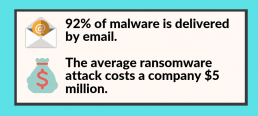
Malware Attacks
Malware is a code that is made to stealthily affect a compromised computer system without the consent of the user. This broad definition includes many particular types of malevolent software (malware) such as spyware, ransomware, command, and control.
Many well-known businesses, states, and criminal actors have been implicated of and discovered deploying malware.
Malware differs from other software in that it can spread across a network, cause changes and damage, remain undetectable, and be persistent in the infected system. It can destroy a network and bring a machine’s performance to its knees.
Ransomware
Ransomware blocks access to a victims data, typically threating delete it if a ransom is paid. There is no guarantee that paying a ransom will regain access to the data. Ransomware is often carried out via a Trojan delivering a payload disguised as a legitimate file.
Learn more about ransomware attacks and how to prevent them.
Drive-by Attack
A drive-by attack is a common method of distributing malware.
A cyber attacker looks for an insecure website and plants a malicious script into PHP or HTTP in one of the pages. This script can install malware into the computer that visits this website or become an IFRAME that redirects the victim’s browser into a site controlled by the attacker. In most cases, these scripts are obfuscated, and this makes the code to be complicated to analyze by security researchers. These attacks are known as drive-by because they don’t require any action on the victim’s part except visiting the compromised website. When they visit the compromised site, they automatically and silently become infected if their computer is vulnerable to the malware, especially if they have not applied security updates to their applications.
Trojan Horses
A Trojan is a malicious software program that misrepresents itself to appear useful. They spread by looking like routine software and persuading a victim to install. Trojans are considered among the most dangerous type of all malware, as they are often designed to steal financial information.
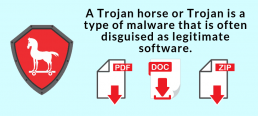
Web Attacks
SQL Injection
SQL injection, also known as SQLI, is a kind of attack that employs malicious code to manipulate backend databases to access information that was not intended for display. This may include numerous items including private customer details, user lists, or sensitive company data.
SQLI can have devastating effects on a business. A successful SQLI attack can cause deletion of entire tables, unauthorized viewing of user lists, and in some cases, the attacker can gain administrative access to a database. These can be highly detrimental to a business. When calculating the probable cost of SQLI, you need to consider the loss of customer trust in case personal information like addresses, credit card details, and phone numbers are stolen.
Although SQLI can be used to attack any SQL database, the culprits often target websites.
Cross Site Scripting
Cross-site scripting (XSS) is a kind of injection breach where the attacker sends malicious scripts into content from otherwise reputable websites. It happens when a dubious source is allowed to attach its own code into web applications, and the malicious code is bundled together with dynamic content that is then sent to the victim’s browser.
Malicious code is usually sent in the form of pieces of Javascript code executed by the target’s browser. The exploits can include malicious executable scripts in many languages including Flash, HTML, Java, and Ajax. XSS attacks can be very devastating, however, alleviating the vulnerabilities that enable these attacks is relatively simple.
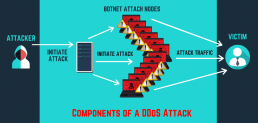
Other Types of Cyber Security Threats
Distributed Denial-of-Service (DDoS) attack?
Denial-of-service (DDoS) aims at shutting down a network or service, causing it to be inaccessible to its intended users. The attacks accomplish this mission by overwhelming the target with traffic or flooding it with information that triggers a crash. In both situations, the DoS onslaught denies legitimate users such as employees, account holders, and members of the resource or service they expected.
DDoS attacks are often targeted at web servers of high-profile organizations such as trade organizations and government, media companies, commerce, and banking. Although these attacks don’t result in the loss or theft of vital information or other assets, they can cost a victim lots of money and time to mitigate. DDoS is often used in combination to distract from other network attacks.
Learn more about DDoS Attacks.
Password Attack
A password attack simply means an attempt to decrypt or obtain a user’s password with illegal intentions.
Crackers can use password sniffers, dictionary attacks, and cracking programs in password attacks. There are few defense mechanisms against password attacks, but usually, the remedy is inculcating a password policy that includes a minimum length, frequent changes, and unrecognizable words.
Password attacks are often carried out by recovering passwords stored or exported through a computer system. The password recovery is usually done by continuously guessing the password through a computer algorithm. The computer tries several combinations until it successfully discovers the password.
Eavesdropping Attack
Eavesdropping attacks start with the interception of network traffic.
An Eavesdropping breach, also known as snooping or sniffing, is a network security attack where an individual tries to steal the information that smartphones, computers and other digital devices send or receive This hack capitalizes on unsecured network transmissions to access the data being transmitted. Eavesdropping is challenging to detect since it doesn’t cause abnormal data transmissions.
These attacks target weakened transmissions between the client and server that enables the attacker to receive network transmissions. An attacker can install network monitors such as sniffers on a server or computer to perform an eavesdropping attack and intercept data as it is being transmitted. Any device within the transmitting and receiving network is a vulnerability point, including the terminal and initial devices themselves. One way to protect against these attacks is knowing what devices are connected to a particular network and what software is run on these devices.
Birthday attack
The birthday attack is a statistical phenomenon that simplifies the brute-forcing of one-way hashes. It is based on the birthday paradox that states that for a 50 percent chance that someone shares your birthday in any room, you need 253 individuals in the room. However, for a chance higher than 50 percent, you only require 23 people. This probability works because these matches depend on pairs. If you choose yourself as one of the pairs, you only need 253 people to get the required number of 253 pairs. However, if you just need matches that don’t include you, you only need 23 people to create 253 pairs when cross-matching with each other. Thus, 253 is the number you need to acquire a 50 percent probability of a birthday match in a room.
Brute-Force and Dictionary Network Attacks
Dictionary and brute-force attacks are networking attacks whereby the attacker attempts to log into a user’s account by systematically checking and trying all possible passwords until finding the correct one.
The simplest method to attack is through the front door since you must have a way of logging in. If you have the required credentials, you can gain entry as a regular user without creating suspicious logs, needing an unpatched entry, or tripping IDS signatures. If you have a system’s credentials, your life is even simplified since attackers don’t have these luxuries.
The term brute-force means overpowering the system through repetition. When hacking passwords, brute force requires dictionary software that combines dictionary words with thousands of different variations. It is a slower and less glamorous process. These attacks start with simple letters such as “a” and then move to full words such as “snoop” or “snoopy.”
Brute-force dictionary attacks can make 100 to 1000 attempts per minute. After several hours or days, brute-force attacks can eventually crack any password. Brute force attacks reiterate the importance of password best practices, especially on critical resources such as network switches, routers, and servers.
Learn more about Brute Force attacks.
Insider Threats
Not every network attack is performed by someone outside an organization.
Inside attacks are malicious attacks performed on a computer system or network by an individual authorized to access the system. Insiders that carry out these attacks have the edge over external attackers since they have authorized system access. They may also understand the system policies and network architecture. Furthermore, there is less security against insider attacks since most organizations focus on defending against external attacks.
Insider threats can affect all elements of computer security and range from injecting Trojan viruses to stealing sensitive data from a network or system. The attackers may also affect the system availability by overloading the network or computer processing capacity or computer storage, resulting in system crashes.
Man-in-the-Middle (MITM) Attacks
Man-in-the-middle (MITM) attacks are a type of cybersecurity breach that allows an attacker to eavesdrop a communication between two entities. The attack occurs between two legitimate communicating parties, enabling the attacker to intercept communication they should otherwise not be able to access. Thus the name “man-in-the-middle.” The attacker “listens” to the conversation by intercepting the public key message transmission and retransmits the message while interchanging the requested key with his own.
The two parties seem to communicate as usual, without knowing the message sender is an unknown perpetrator trying to modify and access the message before it is transmitted to the receiver. Thus, the intruder controls the whole communication.
AI-Powered Attacks
The concept of a computer program learning by itself, building knowledge, and getting more sophisticated may be scary.
Artificial intelligence can be easily dismissed as another tech buzzword. However, it is already being employed in everyday applications through an algorithmic process referred to as machine learning. Machine learning software is aimed at training a computer to perform particular tasks on its own. They are taught to accomplish tasks by doing them repeatedly while learning about certain obstacles that could hinder them.
AI can be used to hack into many systems including autonomous vehicles and drones, converting them into potential weapons. AI makes cyber attacks such as identity theft, password cracking, and denial-of-service attacks, automated, more powerful and efficient. It can also be used to kill or injure people, steal money, or cause emotional harm. Larger attacks can as well be used to affect national security, shut down hospitals, and cut power supplies to entire regions.
Be Prepared For Attacks On Your Network
This article has reviewed the top cyber-security attacks that hackers use to disrupt and compromise information systems.
For you to mount a good defense mechanism, you need to understand the offense. This review of the most common cyber attacks shows you that attackers have many options while choosing attacks to compromise and disrupt information systems. You also need to be proactive in defending and securing your network.
Maintain an updated antivirus database, train your employees, keep your passwords strong, and use a low-privilege IT environment model to protect yourself against cyber attacks.
Recent Posts
HIPAA Compliant Cloud Storage Solutions: Maintain Healthcare Compliance
Hospitals, clinics, and other health organizations have had a bumpy road towards cloud adoption over the past few years. The implied security risks of using the public cloud or working with a third-party service provider considerably delayed cloud adoption in the healthcare industry.
Even today, when 84% of healthcare organizations use cloud services, the question of choosing the right HIPAA compliant cloud provider can be a headache.
All healthcare providers whose clients’ data is stored in the U.S. are a subject to a set of regulations known as HIPAA compliance
Today, any organization that handles confidential patient data needs abide by HIPAA storage requirements.
What is HIPAA Compliance?
HIPAA standards provide protection of health data. Any vendor working with a healthcare organization or business handling health files must abide by the HIPAA privacy rules. There are also many ancillary industries that must adhere to the guidelines if they have access to medical and patient data. This is where HIPPA Compliant cloud storage plays a significant role.
In 1996, “the U.S. Department of Health and Human Services (“HHS”) issued the Privacy Rule to implement the requirement of the Health Insurance Portability and Accountability Act (HIPAA) of 1996.” The Privacy Rule addresses patients’ “electronic protected health information” and how organizations, or “HIPAA covered entities” subject to the Privacy Rules must comply.
Most healthcare institutions use some form of electronic devices to provide medical care. This means that information no longer resides on a paper chart, but on a computer or in the cloud. Unlike general businesses or most commercial entities, healthcare institutions are legally obliged to employ the most reliable data backup practices.
So, how does this affect their choice of a cloud provider?
When planning their move to cloud computing, health care institutions need to ensure their vendor meets specific security criteria.
These criteria translate into requirements and thresholds that a company must meet and maintain to become HIPAA-ready. These come down to a set of certifications, SOC auditing and reporting, encryption levels, and physical security features.
HIPAA cloud storage solutions should work to make becoming compliant simple and straightforward. This way, healthcare organizations have one less thing to worry about and can focus on improving their critical processes.

HIPAA Cloud Storage and Data Backup Requirements
A cloud service provider doing business with a company operating under the HIPAA-HITECH act rules is considered a business associate. As such, it must show that it within cloud compliance standards and follows any relevant standards. Although the vendor does not directly handle patient information, it does receive, manage, and store Protected Health Information (PHI). This fact alone makes them responsible for protecting it according to HIPAA-HITECH act guidelines.
Being HIPAA compliant means implementing all of the rules and regulations that the Act proposes. Any vendor offering services that are subject to the act must provide documentation as proof of their conformity. This documentation needs to be sent not only to their clients but also to the Office for Civil Rights (OCR). The OCR is a sub-agency of the U.S. Department of Education, which promotes equal access to healthcare and human services programs.
Healthcare industry organizations looking to work with a HIPAA Compliant cloud storage provider should request proof of compliance to protect themselves. If the provider follows all standards, it should have no qualms about sharing the appropriate documentation with you.
HIPAA requirements for cloud hosting organizations are the same as the requirements for business associates. They fall into three distinct categories: administrative, physical, and technical safeguards.
- Administrative Safeguards: These types of safeguards are transparent policies that outline how the business will comply from an operational standpoint. The operations can include managing security risk assessments, appropriate procedures, disaster and emergency response, and managing passwords.
- Physical Safeguard: Physical safeguards are usually systems that are in place to protect customer data. They might include proper storage, data backup, and appropriate disposal of media at a data center. Important security precautions for facilities where hardware or software storage devices reside are also a part of this category.
- Technical Safeguards: This group of safeguards refers to technical features implemented to minimize data risk and maximize protection. Requiring unique login information, auto-logoff policies, and authentication for PHI access are just some of the technical safeguards that should be in place.

What Makes a HIPAA Certified Cloud Provider Compliant?
Providing HIPAA compliant file storage hardware or software is not as simple as flipping a switch. It takes a tremendous amount of time and effort for a company to become compliant.
The critical element to look for in a HIPAA certified cloud storage provider is its willingness to make a Business Associate Agreement. Known as a BAA, this agreement is completed between two parties planning to transmit, process, or receive PHI. Its primary purpose is to protect both parties from any legal repercussions resulting in the misuse of protected health information.
A Business Associate Agreement BAA must not add, subtract, or contradict the overall standards of the HIPAA. However, if both parties agree, supplementing specific terminology is acceptable. There are also some core terms that make up the groundwork for a compliant business associate agreement and must remain for the contract to be considered legally binding.
The level of encryption enabled by the cloud provider needs proper attention. The company should be encrypting files not only in transit but also at rest. Advanced Encryption Standard (AES) is the minimum level of encryption that it should use for file storage and sharing. AES is a successor to Data Encryption Standard (DES) and was developed by the National Institute of Standards and Technology (NIST) in 1997. It is an advanced encryption algorithm that offers improved defense against different security incidents.

Selecting a Compliant Cloud Storage Vendor
When choosing a HIPAA compliant provider, look for HIPAA web Hosting that meets the measures outlined in the previous section. Make sure you ask them about their data storage security practices to how secure your PHI data will be.
Does the potential vendor offer a service level agreement?
An SLA contract indicates guaranteed response times to threats, typically within a twenty-four-hour window. As a company that transmits PHI, you need to know how quickly the provider can notify you in the event of an incident. The faster you receive a breach notification, the more efficiently you can respond.
Don’t forget that the storage of electronic cloud-based medical records should be in a secure data center.
What are the security measures in place in case of an incident? How is access to the facility determined? Ask for a detailed outline of how they implement and enforce physical security. Check how they respond in the event of a data breach. Make sure you get all the relevant details before you bring your data to risk.
Your selected vendor should also have a Disaster Recovery and Continuity Plan in place.
A continuity plan will anticipate loss due to natural disasters, data breaches, and other unforeseen incidents. It will also provide the necessary processes and procedures if or when such events occur. Concerning data loss prevention best practices, it is also essential to determine how often the proposed method undergoes rigorous testing.
Healthcare Medical Records Security – How can I be Sure?
Cloud providers that take compliance seriously will ensure their certifications are current. There are several ways to check if they follow standards and relevant regulations.
One way is to audit your potential provider using an independent party. Auditing will bring any possible risks to your attention and reveal the vendor’s security tactics. Cloud storage for medical records providers must regularly audit their systems and environments for securing threats to remain compliant. The term ‘regularly’ is not defined by the act, so it is essential to request documentation and information on at least a quarterly basis. You should also ensure you have constant access to reports and documentation detailing the most recent audit.
Another way to determine whether the company is compliant is to assess the qualifications of its employees. All staff needs to be educated on the most current standards and get familiarized with specific safeguards. Only with these in place organizations can achieve compliance.
Ask your potential vendor tough questions. Anyone with access to PHI needs appropriate training on secure data transmission methods. Training needs to include the ability to securely encrypt patient information no matter where they are stored.
A HIPAA compliant company will not ask you for a backdoor to access your data or permission to bypass your access management protocols. Such vendors recognize the risk of requiring additional authentication or access points. Compromising access to authentication protocols and password requirements is a serious violation and should never happen.

Cloud Backup & Storage Frequently Asked Questions
Ask potential cloud vendors which method they use to evaluate your HIPAA compliance.
Is a HIPAA policy template available for use? Does the provider offer guidance and feedback on compliance? How are they ensuring that you are up to date and aware of security rules and regulations? Do they offer HIPAA compliant email?
Does the company have full-time employees on-premise?
Having a presence on site and available around the clock is a mechanism to ensure advanced security. An available representative makes PHI security more reliable and guarantees a quick response if needed. It also gives you peace of mind knowing that the company in charge of your data protection is thoroughly versed in the required standards.
The right provider should also be quick to adapt to the changes and inform you of anything that directly affects your PHI or your access to it.
Data deletion is a crucial component in choosing the appropriate HIPAA business associate. How long is the information kept for a period before being purged? How is data leakage prevented when servers are taken out of commission or erased? Is the data provided to you before deletion? The act offers no guidelines concerning the required length of time, but it is an agreement you and your provider must reach together.
In addition to your knowledge, determine how well your potential provider is versed in HIPAA regulations. Cloud companies often fail to follow the latest regulation changes, and you have to look for the one with consistent dedication.
Shop around. Do not be content with the first quote.
Many companies tout their HIPAA security, only to discover that they fall short of the measuring stick. Do your research, ask questions, and determine which vendor best suits your needs.
HIPAA-Compliant Cloud Storage is Critical
When it comes to protecting medical records in the cloud, phoenixNAP will support your efforts with the highest service quality, security, and dependability.
We provide a selection of data centers which offer state-of-the-art protection for your medical files. With scalable cloud solutions, a 100% uptime guarantee, and unmatched disaster recovery, you can rest assured that your infrastructure is compliant.
HIPAA certifications can be confusing, complicated, and stressful.
You need to be able to trust your cloud provider to keep your files safe. PhoenixNap Global IT Services will allow you the freedom to focus your attention on other areas of your business and ensure the protection of your entities and business associates.
Recent Posts
Information Security Risk Management: Plan, Steps, & Examples
Are your mission-critical data, customer information, and personnel records safe from intrusions from cybercriminals, hackers, and even internal misuse or destruction?
If you’re confident that your data is secure, other companies had the same feeling:
- Target, one of the largest retailers in the U.S. fell victim to a massive cyber attack in 2013, with personal information of 110 million customers and 40 million banking records being compromised. This resulted in long-term damage to the company’s image and a settlement of over 18 million dollars.
- Equifax, the well-known credit company, was attacked over a period of months, discovered in July 2017. Cyber thieves made off with sensitive data of over 143 million customers and 200,000 credit card numbers.
These are only examples of highly public attacks that resulted in considerable fines and settlements. Not to mention, damage to brand image and public perception.
Kaspersky Labs’ study of cybersecurity revealed 758 million malicious cyber attacks and security incidents worldwide in 2018, with one third having their origin in the U.S.
How do you protect your business and information assets from a security incident?
The solution is to have a strategic plan, a commitment to Information Security Risk Management.
What is Information Security Risk Management? A Definition
Information Security Risk Management, or ISRM, is the process of managing risks affiliated with the use of information technology.
In other words, organizations need to:
- Identify Security risks, including types of computer security risks.
- Determining business “system owners” of critical assets.
- Assessing enterprise risk tolerance and acceptable risks.
- Develop a cybersecurity incident response plan.

Building Your Risk Management Strategy
Risk Assessment
Your risk profile includes analysis of all information systems and determination of threats to your business:
- Network security risks
- Data & IT security risks
- Existing organizational security controls
A comprehensive IT security assessment includes data risks, analysis of database security issues, the potential for data breaches, network, and physical vulnerabilities.
Risk Treatment
Actions taken to remediate vulnerabilities through multiple approaches:
- Risk acceptance
- Risk avoidance
- Risk management
- Incident management
- Incident response planning
Developing an enterprise solution requires a thorough analysis of security threats to information systems in your business.
Risk assessment and risk treatment are iterative processes that require the commitment of resources in multiple areas of your business: HR, IT, Legal, Public Relations, and more.
Not all risks identified in risk assessment will be resolved in risk treatment. Some will be determined to be acceptable or low-impact risks that do not warrant an immediate treatment plan.
There are multiple stages to be addressed in your information security risk assessment.

6 Stages of a Security Risk Assessment
A useful guideline for adopting a risk management framework is provided by the U.S. Dept. of Commerce National Institute of Standards and Technology (NIST). This voluntary framework outlines the stages of ISRM programs that may apply to your business.
1. Identify – Data Risk Analysis
This stage is the process of identifying your digital assets that may include a wide variety of information:
Financial information that must be controlled under Sarbanes-OxleyHealthcare records requiring confidentiality through the application of the Health Insurance Portability and Accountability Act, HIPAA
Company-confidential information such as product development and trade secrets
Personnel data that could expose employees to cybersecurity risks such as identity theft regulations
For those dealing with credit card transactions, compliance with Payment Card Industry Data Security Standard (PCI DSS)
During this stage, you will evaluate not only the risk potential for data loss or theft but also prioritize the steps to be taken to minimize or avoid the risk associated with each type of data.
The result of the Identify stage is to understand your top information security risks and to evaluate any controls you already have in place to mitigate those risks. The analysis in this stage reveals such data security issues as:
Potential threats – physical, environmental, technical, and personnel-related
Controls already in place – secure strong passwords, physical security, use of technology, network access
Data assets that should or must be protected and controlled
This includes categorizing data for security risk management by the level of confidentiality, compliance regulations, financial risk, and acceptable level of risk.
2. Protection – Asset Management
Once you have an awareness of your security risks, you can take steps to safeguard those assets.
This includes a variety of processes, from implementing security policies to installing sophisticated software that provides advanced data risk management capabilities.
- Security awareness training of employees in the proper handling of confidential information.
- Implement access controls so that only those who genuinely need information have access.
- Define security controls required to minimize exposure from security incidents.
- For each identified risk, establish the corresponding business “owner” to obtain buy-in for proposed controls and risk tolerance.
- Create an information security officer position with a centralized focus on data security risk assessment and risk mitigation.
3. Implementation
Your implementation stage includes the adoption of formal policies and data security controls.
These controls will encompass a variety of approaches to data management risks:
- Review of identified security threats and existing controls
- Creation of new controls for threat detection and containment
- Select network security tools for analysis of actual and attempted threats
- Install and implement technology for alerts and capturing unauthorized access
4. Security Control Assessment
Both existing and new security controls adopted by your business should undergo regular scrutiny.
- Validate that alerts are routed to the right resources for immediate action.
- Ensure that as applications are added or updated, there is a continuous data risk analysis.
- Network security measures should be tested regularly for effectiveness. If your organization includes audit functions, have controls been reviewed and approved?
- Have data business owners (stakeholders) been interviewed to ensure risk management solutions are acceptable? Are they appropriate for the associated vulnerability?
5. Information Security System Authorizations
Now that you have a comprehensive view of your critical data, defined the threats, and established controls for your security management process, how do you ensure its effectiveness?
The authorization stage will help you make this determination:
- Are the right individuals notified of on-going threats? Is this done promptly?
- Review the alerts generated by your controls – emails, documents, graphs, etc. Who is tracking response to warnings?
This authorization stage must examine not only who is informed, but what actions are taken, and how quickly. When your data is at risk, the reaction time is essential to minimize data theft or loss.
6. Risk Monitoring
Adopting an information risk management framework is critical to providing a secure environment for your technical assets.
Implementing a sophisticated software-driven system of controls and alert management is an effective part of a risk treatment plan.
Continuous monitoring and analysis are critical. Cyber thieves develop new methods of attacking your network and data warehouses daily. To keep pace with this onslaught of activity, you must revisit your reporting, alerts, and metrics regularly.

Create an Effective Security Risk Management Program
Defeating cybercriminals and halting internal threats is a challenging process. Bringing data integrity and availability to your enterprise risk management is essential to your employees, customers, and shareholders.
Creating your risk management process and take strategic steps to make data security a fundamental part of conducting business.
In summary, best practices include:
- Implement technology solutions to detect and eradicate threats before data is compromised.
- Establish a security office with accountability.
- Ensure compliance with security policies.
- Make data analysis a collaborative effort between IT and business stakeholders.
- Ensure alerts and reporting are meaningful and effectively routed.
Conducting a complete IT security assessment and managing enterprise risk is essential to identify vulnerability issues.
Develop a comprehensive approach to information security.
PhoenixNAP incorporates infrastructure and software solutions to provide our customers with reliable, essential information technology services:
- High-performance, scalable Cloud services
- Dedicated servers and redundant systems
- Complete software solutions for ISRM
- Disaster recovery services including backup and restore functions
Security is our core focus, providing control and protection of your network and critical data.
Contact our professionals today to discuss how our services can be tailored to provide your company with a global security solution.

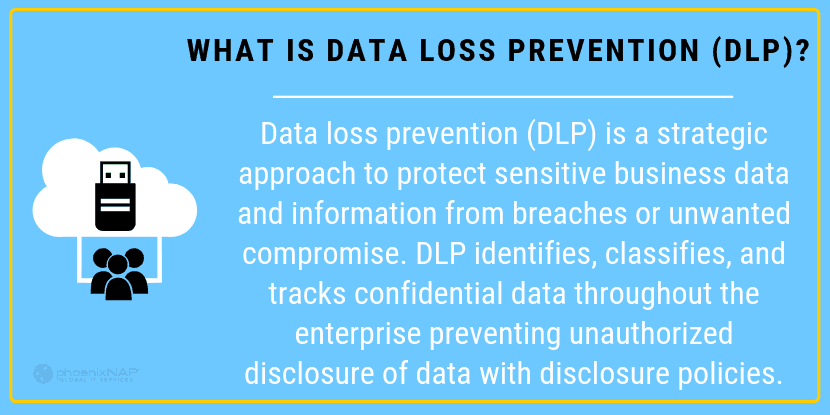

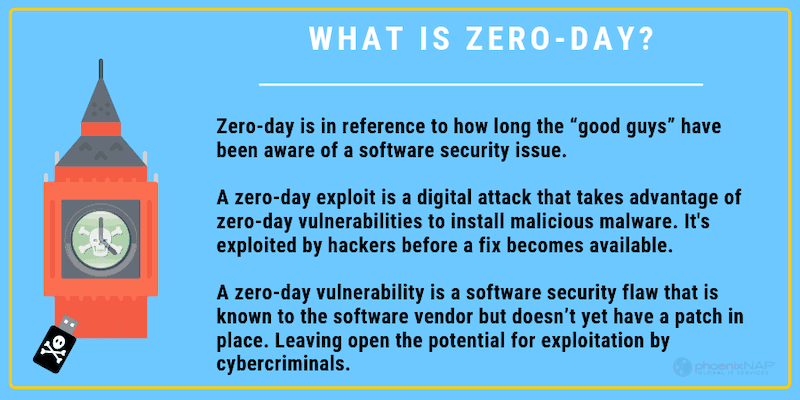
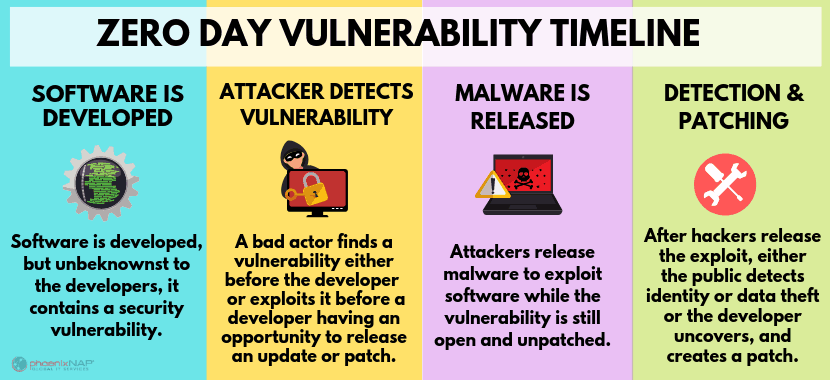
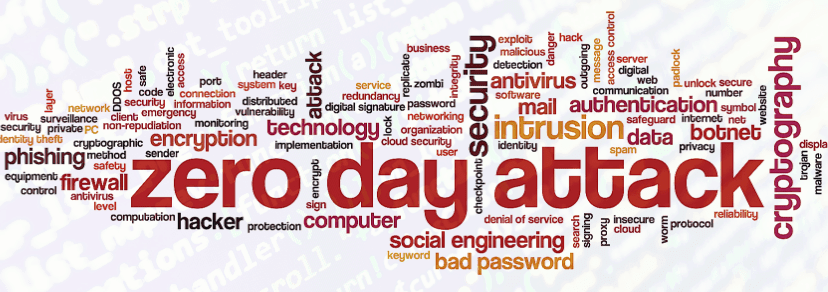

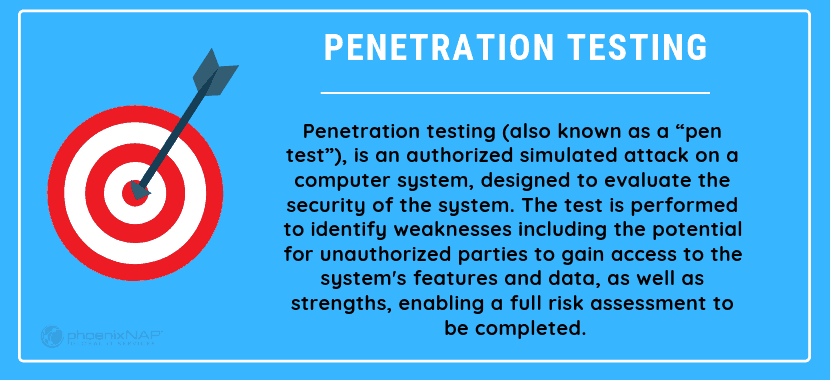
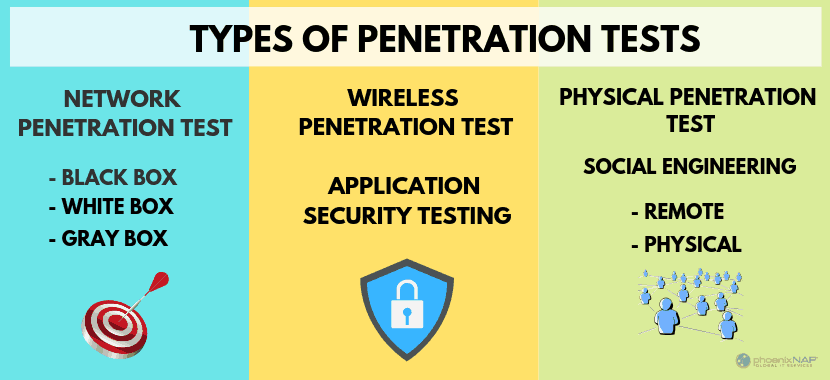 Types of Penetration Tests
Types of Penetration Tests
